LG Electronics USA L05D PCS GSM Phone with WLAN, Bluetooth and RFID User Manual DS1106 E UG indb
LG Electronics MobileComm USA, Inc. PCS GSM Phone with WLAN, Bluetooth and RFID DS1106 E UG indb
Contents
- 1. Users Manual 1
- 2. Users Manual 2
Users Manual 1

Don't forget your mobile phone … or your manners!
When using your mobile phone in a public place, don't forget to show common courtesy and consideration to others around you.
General Inquiries
<docomo Information Center> Repairs
For Applications or Repairs and After-Sales Service, please contact the above-mentioned information center or
the docomo Shop etc. near you searched on the NTT DOCOMO website.
NTT DOCOMO website http://www.nttdocomo.co.jp/english/
Please conrm the phone number before you dial.
0120-800-000
* Unavailable from part of IP phones.
■From land-line phones (In Japanese only)
* Unavailable from land-line phones, etc.
(No prex) 151 (toll free)
■From DOCOMO mobile phones (In Japanese only)
0120-800-000
* Unavailable from part of IP phones.
■From land-line phones (In Japanese only)
* Unavailable from land-line phones, etc.
(No prex) 113 (toll free)
■From DOCOMO mobile phones (In Japanese only)
To prevent damage to the environment,
bring used battery packs to a docomo service
counter, a docomo agent or recycle center.
Li-ion00
'12.XX (1st Edition)
MBMXXXXXXXX
’12.XX
L-05D
INSTRUCTION MANUAL
L-05D
INSTRUCTION MANUAL
Contents / Precautions
Confirmation and
Settings before Using
docomo Palette UI
Application
Using Overseas
Appendix / Index
File Management
Mail / Internet
Settings
Calling /
Network Services
(Business hours: 9:00 a.m. to 8:00 p.m.)
* Service available in: English, Portuguese, Chinese, Spanish, Korean.
* Unavailable from part of IP phones.
0120-005-250
(toll free)
(Business hours: 9:00 a.m. to 8:00 p.m. (open all year round))
(Business hours: 24 hours (open all year round))

Introduction
Thank you for purchasing "L-05D".
Before or while using, be sure to thoroughly read this
manual to ensure its correct use.
Before Using this Terminal
•This terminal supports LTE, W-CDMA, GSM/GPRS,
and wireless LAN systems.
•This terminal uses wireless, therefore, it may not
function in locations where it is difficult for radio
waves to penetrate or areas where radio wave
signals are weak, such as tunnels, underground
passages, and some buildings or places out of the
Xi and FOMA service areas. Even when you are
on a higher floor of a tall building or condominium
and nothing blocks your view outside, this terminal
may not be able to receive or transmit signals. Also
communication may be interrupted even when the
Antenna Indication Lamp indicates a strong signal
reception with four antenna indication bars.
•Because the terminal uses radio waves, there is a
possibility that a third party may intercept your call.
However, LTE, W-CDMA, and GSM/GPRS systems
automatically support privacy functions for all calls,
so even if a third party intercepts a call through a
receiver, it is only received as noise.
•This terminal encodes sound communication by
wireless and also as digital data. When you are
operating your terminal while moving to a location
subject to weaker radio wave conditions, the
transmitted data may not be correctly decoded and
as a result the decoded sound may differ somewhat
from the actual sound.
•This terminal is supported in Xi Areas, FOMA Plus-
Areas, and FOMA HIGH-SPEED Areas.
•Keep a separate record of any information stored on
this terminal and store the copies in a safe location.
DOCOMO assumes no responsibility for any loss
of your data resulting from malfunctions, repair,
changing of the model or other handling of the
terminal.
•As with PCs, some applications that you install may
cause unstable terminal operation, or may send
your location information or personal information
registered in the terminal to outside via the Internet
and the information may be used improperly.
Therefore, verify the supplier and operating
conditions of the applications before using.
•It is recommended that you save important data to a
microSD card.

Unlocking SIM
Unlocking SIM is available on this terminal. Unlocking
SIM enables a SIM card from other makers to be used.
•Unlocking SIM is available at a docomo Shop.
•A fee is required to unlock the SIM.
•When a SIM card from another maker is used,
LTE is not available. In addition, its services and
functions may get restricted. DOCOMO assumes no
responsibility for any operation problems based on
SIMs from other makers.
•Visit the DOCOMO website for detailed information
on unlocking SIM.
Download the latest information of this manual
from DOCOMO website. Also you can check the
latest information from this terminal.
Quick Start Guide (Accessories, in Japanese
only)
Basic function operations are explained.
INSTRUCTION MANUAL (Applications for this
Terminal, in Japanese only)
Details about functions and operations are
explained.
Tap "Applications" u "Instruction Manual" on the
Home screen.
INSTRUCTION MANUAL (PDF file)
Details about functions and operations are
explained.
Download from DOCOMO website.
http://www.nttdocomo.co.jp/support/trouble/
manual/download/index.html
* The URL and information contained in the
manual are subject to change without prior
notice.
1

Supplied Accessories
About other optional accessories and related
equipment →P207
L-05D
(with warranty and back cover )
Quick Start Guide
Battery Pack
2
Contents / Precautions

microSDHC card (4GB) (sample)
(with manual)
3
Contents / Precautions
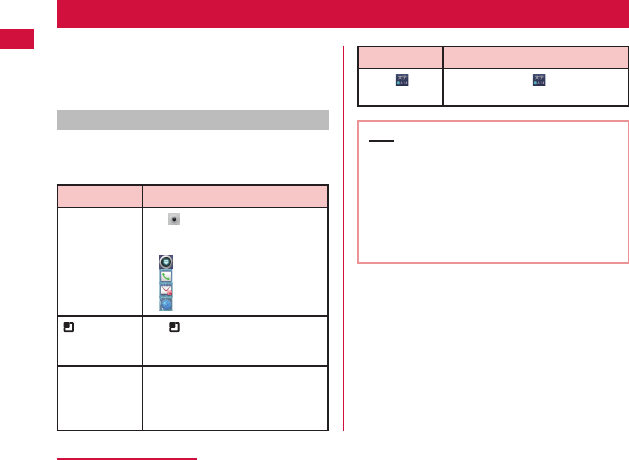
How to Use this Manual
•Any reprint of this manual is prohibited.
•This manual is subject to change without prior notice.
•"This terminal" indicates "L-05D" in this manual.
Please keep this in mind.
Explanation of operations
The selection operations of those icons and items
displayed on the touch screen are described below in
this manual.
Description Operation description
"Applications"
on the Home
screen
Tap on the Home screen.
•The icons on the Home screen
are explained below.
: Applications
: Phone
: sp-mode mail
: Browser
u"Settings"
on the Home
screen
Tap at the bottom of the screen,
and then tap "Settings" from the
displayed Option menu.
"Wireless &
networks"
u "Mobile
networks"
Tap "Wireless & networks"
displayed on the screen, and then
tap "Mobile networks".
Description Operation description
Touch for
over 1 second
Tap and hold the displayed on
the screen for 1 to 2 seconds.
Note
•The operations described in this manual are
followed by the default settings of the Home
screen where the Home Switcher is set to
"docomo Palette UI". If the contents of the Home
screen are changed, the operation description
may differ.
•Images used in this manual may differ from
those on this terminal.
4
Contents / Precautions

Table of Contents
Supplied Accessories …………………………………… 2
How to Use this Manual ………………………………… 4
Notes on Using this Terminal …………………………… 8
Safety Precautions (ALWAYS FOLLOW THESE
PRECAUTIONS) ………………………………………… 9
Handling and Care …………………………………… 22
Confirmation and Settings before Using … 29
Part Names and Functions …………………………… 29
UIM ……………………………………………………… 31
microSD Card ………………………………………… 33
Battery Pack …………………………………………… 34
Charging ……………………………………………… 35
Turning ON/OFF the Power ………………………… 40
Basic Operations (Touch Screen Operations) ……… 41
Initial Settings ………………………………………… 46
Screen Display/Icons ………………………………… 53
Character Entry………………………………………… 57
docomo Palette UI ………………………… 62
Viewing the Home Screen …………………………… 62
Home Screen Management ………………………… 63
Viewing the Application Screen ……………………… 66
Manage Applications ………………………………… 73
Group Management …………………………………… 74
Searching Applications ……………………………… 76
Switching Application Screen Display ……………… 76
Home Application Information ……………………… 76
Calling / Network Services ………………… 78
Making/Receiving Calls ……………………………… 78
Operations during a Call ……………………………… 82
Call Log ………………………………………………… 83
Phonebook …………………………………………… 85
Network Services ……………………………………… 91
Settings ……………………………………… 100
Settings Menu ………………………………………… 100
Wireless & Networks ………………………………… 101
Call Settings ……………………………………………106
docomo Service ……………………………………… 107
Sound …………………………………………………… 108
Display …………………………………………………109
Gesture …………………………………………………109
Location & Security …………………………………… 110
Applications …………………………………………… 115
Accounts & Sync ……………………………………… 115
Privacy ………………………………………………… 116
Storage ………………………………………………… 116
Language & Keyboard ………………………………… 117
Voice Input & Output ………………………………… 117
Accessibility …………………………………………… 117
Connectivity Settings ………………………………… 118
Date & Time ……………………………………………120
5
Contents / Precautions

About Phone ……………………………………………120
Mail / Internet ……………………………… 122
sp-mode Mail……………………………………………122
SMS ……………………………………………………122
Gmail ……………………………………………………124
Early Warning "Area Mail" ……………………………125
Browser …………………………………………………126
Talk ………………………………………………………129
File Management …………………………… 131
File Operation …………………………………………131
Folder and File Operations ……………………………133
Bluetooth Communication ……………………………134
External Device Connection …………………………138
Application …………………………………… 141
Camera …………………………………………………141
Gallery ………………………………………………… 146
Media Player ……………………………………………148
Market …………………………………………………156
Maps ……………………………………………………160
Latitude …………………………………………………167
Navigation ………………………………………………168
Places……………………………………………………169
1Seg ……………………………………………………169
Osaifu-Keitai ……………………………………………177
ToruCa …………………………………………………180
Alarm Clock ……………………………………………181
Calendar ………………………………………………183
Calculator ………………………………………………186
SmartWorld …………………………………………… 186
YouTube …………………………………………………187
Polaris Office ……………………………………………187
iD設定アプリ (iD appli) ………………………………188
Electronic Dictionary …………………………………189
Downloads ……………………………………………… 191
Application Manager …………………………………191
Data Backup and Settings Backup …………………192
Using Overseas …………………………… 197
Overview of International Roaming
(WORLD WING) ………………………………………197
Available Services ……………………………………198
Confirming before Using ………………………………198
How to Make and Receive Calls at your
Destination………………………………………………202
Settings for Network Connection at Overseas ………205
Appendix / Index …………………………… 207
Introduction of Options and Related Devices ………207
Troubleshooting (FAQs) ………………………………208
Warranty and After-Sales Service …………………… 216
Updating Software ……………………………………218
Main Specifications ……………………………………225
Specific Absorption Rate (SAR), etc. of
Mobile Phones …………………………………………229
Radio Frequency (RF) Signals ………………………230
Declaration of Conformity ……………………………232
Important Safety Information …………………………233
6
Contents / Precautions

Export Administration Regulations……………………235
Intellectual Property Right ……………………………235
Index ……………………………………………………238
7
Contents / Precautions

Notes on Using this Terminal
•This terminal does not support accessing the i-mode
site (programs) and i-αppli, etc.
•This terminal automatically performs communication
for some functions, for example, to synchronize data,
update the latest software, maintain connection with
the server, etc. When you download applications
or watch movies etc., a large amount of packet
communication is executed. Therefore, it is highly
recommended to use packet flat-rate service.
•This terminal does not support Pubic mode (driving
mode).
•You can confirm your own phone number as follows.
From the Home screen, tap u "Settings" u "About
phone" u "Status".
•You can confirm the software version of this terminal
as follows.
From the Home screen, tap u "Settings" u "About
phone".
•You can update the software of this terminal. Refer to
"Updating Software" (P218) for detailed information.
•In order to improve the quality of this terminal,
sometimes the OS is upgraded through software
updates. Therefore, it is required to always use the
latest version of the OS. Also, applications may
not be able to use any longer if the OS is old, or
problems may occur.
•This terminal uses only UIM. Bring your miniUIM/
FOMA card to a docomo Shop to exchange it.
•Set screen lock or password for this terminal to
ensure its security in case it gets lost. For details,
refer to "Location & Security" (P110).
•In case of loss, please change passwords of each
service accounts on PC to prevent others from using
Google service such as Google Talk, Gmail, Android
Market, etc.
•This terminal does not support service providers
other than sp-mode, mopera U or Business mopera
Internet.
•This terminal does not support 64K data
communication.
8
Contents / Precautions
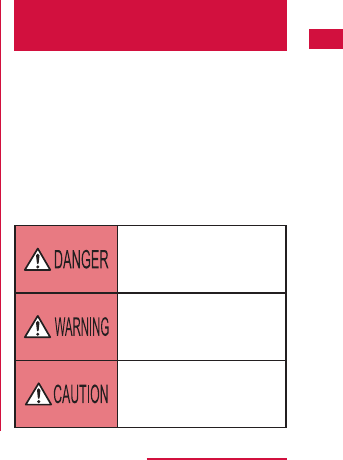
•Backup your data such as images, videos and music
on PC. For details about connection method, refer
to "File Management" (P131) and "External Device
Connection" (P138). Also, it is recommended to use
various on-line data backup services.
•Packet communication fee differs when using
tethering depending on the plan. Packet flat-rate
service is recommended.
•Subscription to sp-mode is required when using
tethering.
•Security between external device and mobile phone
is not configured in the default settings for Wi-Fi
tethering. Set security as needed.
•For detailed information about fees, refer to
http://www.nttdocomo.co.jp/.
Safety Precautions (ALWAYS
FOLLOW THESE PRECAUTIONS)
Before using this terminal, read these "Safety
Precautions" carefully so that you can use it properly.
After reading the safety precautions, keep this manual
in a safe place for later reference.
These precautions are intended to protect you and
others around you. Read and follow them carefully
to avoid injury, damage to the product or damage to
property.
The signs below indicate the levels of danger or
damage that may occur if the particular precautions
are not observed.
This sign indicates that
incorrect handling has a high
possibility of causing death or
serious injury.
This sign indicates that
incorrect handling poses
a risk of causing death or
serious injury.
This sign indicates that incorrect
handling poses a risk of causing
slight injury or damage to the
product or property.
9
Contents / Precautions
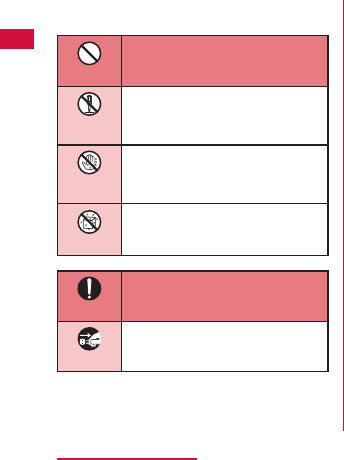
The following symbols indicate special warnings
regarding product usage.
Don’t
Denotes things not to do (prohibition).
Not
disassembly
Denotes not to disassemble.
No
wet hands
Denotes not to use with wet hands.
Not liquids
Denotes not to use where it could get
wet.
Do
Denotes mandatory instructions
(matters that must be complied with).
Unplug
Denotes that the equipment should
be unplugged.
"Safety Precautions" are explained in the following
seven sections.
General Precautions for Terminal, Battery Pack,
Adapter, UIM ………………………………………P11
Precautions for Terminal …………………………P13
Precautions for Battery Pack ……………………P15
Precautions for Adapter ……………………………P17
Precautions for UIM ………………………………P19
Precautions on Using near Electronic Medical
Equipment …………………………………………P19
Material List ……………………………………… P21
10
Contents / Precautions
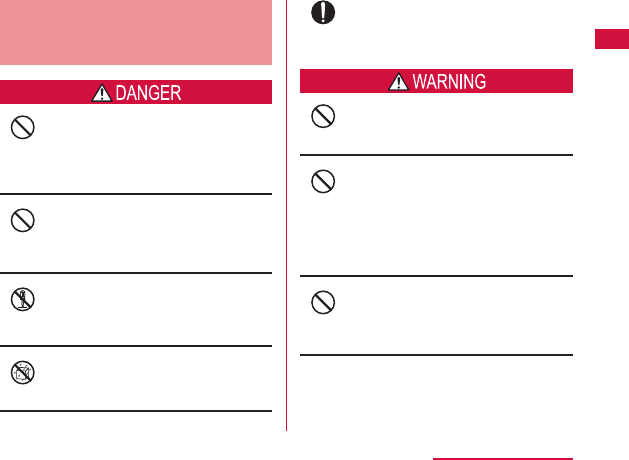
General Precautions for
Terminal, Battery Pack, Adapter,
UIM
Don’t
Do not use or leave this terminal and its
accessories in places with a high temperature
such as besides fire, under direct sunlight or in
cars under the blazing sun.
Fire, burns, or injury may result.
Don’t
Do not put this terminal and its accessories
in heating appliances such as microwaves or
high pressure containers.
Fire, burns, injury, or electric shock may result.
Not
disassembly
Do not disassemble or remodel this terminal
and its accessories.
Fire, burns, injury, or electric shock may result.
Not liquids
Do not get this terminal and its accessories
wet with water, drinking water, pet urine, etc.
Fire, burns, injury, or electric shock may result.
Do
Use the battery pack and adapter specified by
NTT DOCOMO for this terminal.
Fire, burns, injury, or electric shock may result.
Don’t
Do not subject this terminal and its
accessories to severe shocks, or throw them.
Fire, burns, injury, or electric shock may result.
Don’t
Keep conductive materials (metal pieces,
pencil lead, etc.) from coming in contact with
the charging terminal or external connection
terminal (microUSB connection terminal,
earphone/microphone terminal). Do not put
those materials inside the terminal.
Fire, burns, injury, or electric shock may result.
Don’t
Do not cover or wrap this terminal or its
accessories with bedding, etc. while using or
charging.
Fire or burns may result.
11
Contents / Precautions
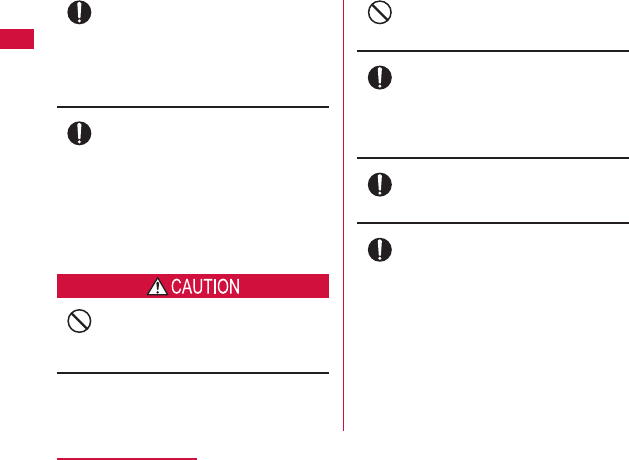
Do
Make sure to turn off the terminal or stop
charging before going to the places like a gas
station where a flammable gas fumes.
Catching fire may result.
Turn off the power when using Osaifu-Keitai
at gas stations (before turning the power off,
release the lock for Osaifu-Keitai if it is set).
Do
If the equipment starts giving off a strange
smell, overheats, becomes discolored or
deformed during use, charging or in storage,
immediately perform the following operations.
•Remove the power plug from the wall outlet
or cigar lighter socket.
•Turn off the terminal.
•Remove the battery pack from the terminal.
Fire, burns, injury, or electric shock may result.
Don’t
Do not place the terminal and its accessories
on unstable locations such as wobbly tables or
slanted locations.
Damage may result from falling down.
Don’t
Do not store this terminal and its accessories
in humid, dusty places, or in hot areas.
Fire, burns, or electric shock may result.
Do
If children use this terminal and its
accessories, a guardian should explain the
precautions and correct operations. Also make
sure that the instructions are followed during
use.
Injury may result.
Do
Keep out of reach of babies and small children.
Accidental swallowing or injury may result.
Do
Be careful especially when using the terminal
with the adapter connected continuously for a
long time.
If you use an application or watch 1Seg
programs for a long time while charging, the
temperature of the terminal, battery pack and
adapter may get high.
Directly touching a hot part for a long time
may cause redness, itching or rash on your
skin, or low-temperature burns depending on
your constitution and/or health condition.
12
Contents / Precautions
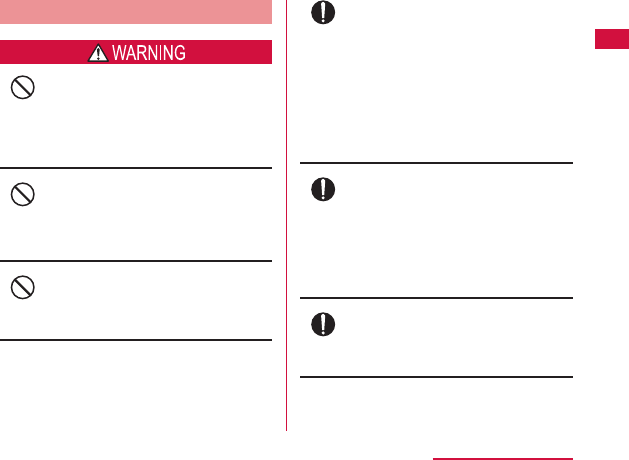
Precautions for Terminal
Don’t
Do not lighten the light near eyes. Especially,
when you shoot photos of babies or infants,
keep the terminal 1 m or more away from
babies and infants.
Vision problems may result. Accident may
result from being shocked and being blind.
Don’t
Do not get liquids such as water or foreign
objects such as metal pieces or flammable
materials into the UIM slot or microSD card
slot of the terminal.
Fire, burns, injury, or electric shock may result.
Don’t
Do not turn on lights in front of the auto driver
directly.
Accident may result from the weak vision
caused by light.
Do
Turn off the terminal in places where use is
prohibited such as airplanes or hospitals.
Electronic devices or electronic medical
devices may be adversely affected. Follow
the instructions when using inside medical
facilities. Also, you will get punished
according to law if any prohibited action, such
as using the phone in airplane, is conducted.
However, if use is permitted by setting for
disconnecting radio wave, etc., follow airline
instructions for proper use.
Do
When talking on the phone with speaker on or
when the terminal is ringing, keep it away from
your ear. And, when connecting the earphone/
microphone etc. to the terminal and playing a
game or music, adjust the volume moderately.
Too loud volume may cause a hearing loss.
And, if you cannot hear the sound around you
clearly, it may cause an accident.
Do
If you have a weak heart, be careful when
setting the Vibrate alert (vibration) or alert
volume setting.
Harmful effect on heart may result.
13
Contents / Precautions
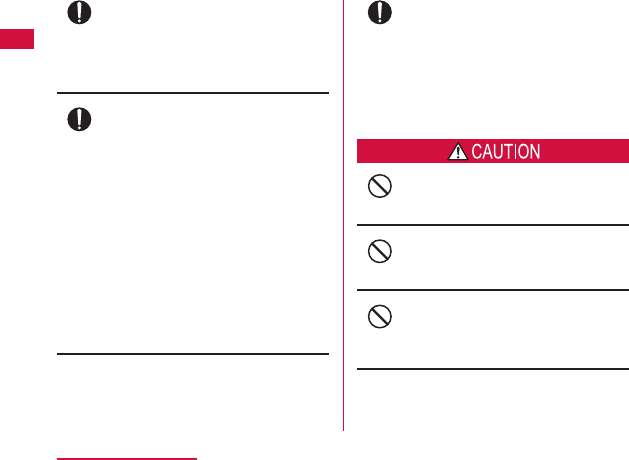
Do
When you use electronic medical equipment,
check with the equipment manufacturer to
determine how the device is affected by radio
waves before using.
Harmful effect on electronic medical
equipment etc. may result.
Do
Turn off the terminal in places near high-
precision electronic devices or devices using
weak electronic signals.
Electronic devices may be adversely affected
by reasons such as malfunction.
* Examples of electronic devices to avoid
Hearing aids, implanted cardiac
pacemakers, implanted defibrillators, other
medical electronic devices, fire alarms,
automatic doors and other automatically
controlled devices.
If you are using an implanted cardiac
pacemaker, implanted defibrillator or any
other electronic medical device, consult
the manufacturer or retailer of the device
for advice regarding possible effects from
radio waves.
Do
When the display or camera lens is
accidentally broken, be careful of broken glass
or exposed internal parts of the terminal.
Since the reinforced glass is used on the
surface of the display and the camera lens,
they are structured for the glass not to scatter.
However, if you carelessly touch broken or
exposed parts, you may get injured.
Don’t
Do not swing the terminal by its antenna, etc.
It may hit you or someone else and may result
in an accident such as an injury.
Don’t
Do not use a broken terminal.
Fire, burns, injury, or electric shock may result.
Don’t
When using the motion sensor, ensure the
safety of you and those around you, hold the
terminal firmly, and avoid extreme movements.
Injury may result.
14
Contents / Precautions
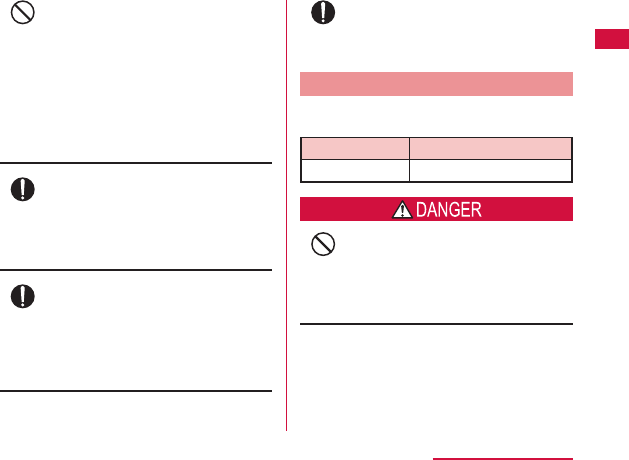
Don’t
If the display part is accidentally broken and
liquid crystal leaks out, do not make the
material contact with your skin of face or
hands.
It may cause loss of sight or skin problems.
If liquid crystal gets into your eyes or mouth,
rinse it with clean water and see a doctor
immediately.
And, if the material adheres to skin or clothing,
use alcohol etc. to wipe it off, and then wash
with soap.
Do
If you use this terminal in a car, contact the car
manufacturer or dealer to ask about the effect
from radio waves.
Depending on the type of car, in-car electronic
devices could be adversely affected. In this
case, stop using this terminal immediately.
Do
Itching, rash or eczema may be caused
depending on your physical conditions or
predisposition. If an abnormality occurs, stop
using the terminal immediately, and then seek
medical attention.
•For the material of each part → "Material
List" (P21)
Do
When watching the display, take a certain
distance from the display in a fully bright place.
Visual loss may result.
Precautions for Battery Pack
Confirm the battery type referring to the label on the
battery pack.
Display Battery type
Li-ion00 Lithium-ion battery
Don’t
Do not get the terminal placed in contact
with metal materials such as a needle. Also,
do not store or bring in contact with metallic
necklaces.
Fire, explosion, getting heated or liquid leak of
the battery pack may result.
15
Contents / Precautions
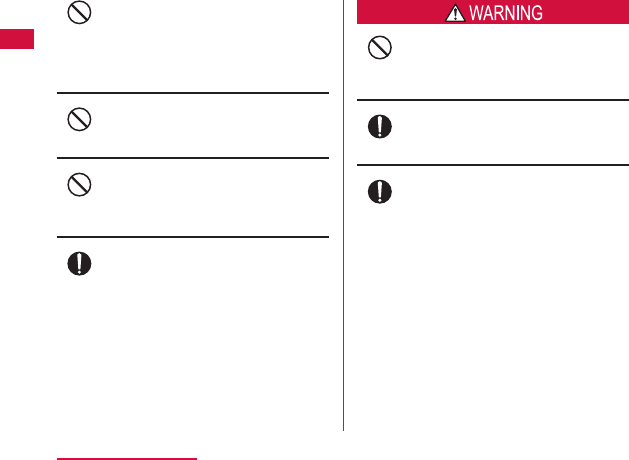
Don’t
When inserting battery pack into the terminal,
make sure to confirm the direction of the
battery pack and not place excessive force on
it.
Fire, explosion, getting heated or liquid leak of
the battery pack may result.
Don’t
Do not throw the terminal into fire.
Fire, explosion, getting heated or liquid leak of
the battery pack may result.
Don’t
Do not sting the terminal with a nail, and do
not hammer or step upon the terminal.
Fire, explosion, getting heated or liquid leak of
the battery pack may result.
Do
When the liquid from battery pack splashes
into your eyes, do not rub your eyes. Wash
your eyes and go to consult with a doctor
immediately.
Blindness may result.
Don’t
Do not use this terminal when transformation
or damage is resulted from falling down.
Fire, explosion, getting heated or liquid leak of
the battery pack may result.
Do
When battery pack leaks liquid or gives off
odor, stop using it and keep it away from fire.
Fire, explosion may result from liquid.
Do
Do not let the pet bite the battery pack.
Fire, explosion, getting heated or liquid leak of
the battery pack may result.
16
Contents / Precautions
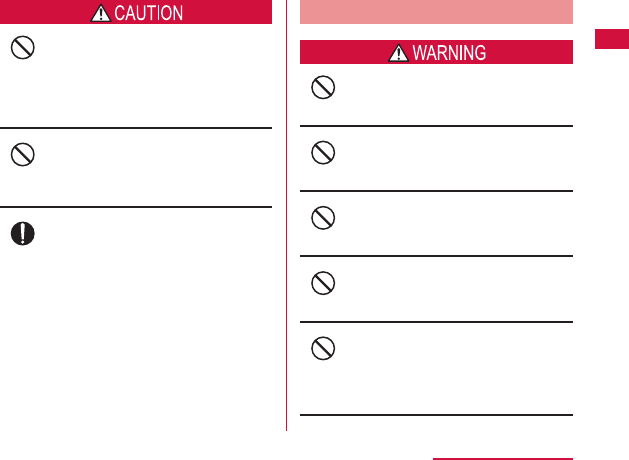
Don’t
Do not discard it as combustible waste.
Fire and environmental pollution may result.
Bring the terminal to a docomo Shop after
insulating the battery pack by wrapping the
terminal with tape or follow the local disposal
regulations.
Don’t
Do not use or charge the terminal when the
battery pack is wet.
Fire, explosion, getting heated or liquid leak of
the battery pack may result.
Do
If battery fluid or another substance leaks from
the battery pack, do not allow it to get on the
skin of your face, hands, etc.
It may cause loss of sight or skin problems.
If battery fluid or another substance gets
in your eyes or mouth, or on your skin
or clothing, rinse it off with clean water
immediately.
Furthermore, if battery fluid gets in your eyes
or mouth, rinse your eyes or mouth with clean
water and then consult a doctor immediately.
Precautions for Adapter
Don’t
Do not use it if the adapter cord gets damaged.
Fire, burns, or electric shock may result.
Don’t
Do not use the AC adapter in a bathroom or
other highly humid area.
Fire, burns, or electric shock may result.
Don’t
DC adapter is only for minus earth car. Do not
use it on plus earth car.
Fire, burns, or electric shock may result.
Don’t
When it starts to thunder, do not touch the
adapter.
Electric shock may result.
Don’t
Do not short the charging terminal while being
connected to the outlet or cigar lighter socket.
Do not touch the charging terminal with a part
of your body such as your hands or fingers.
Fire, burns, or electric shock may result.
17
Contents / Precautions
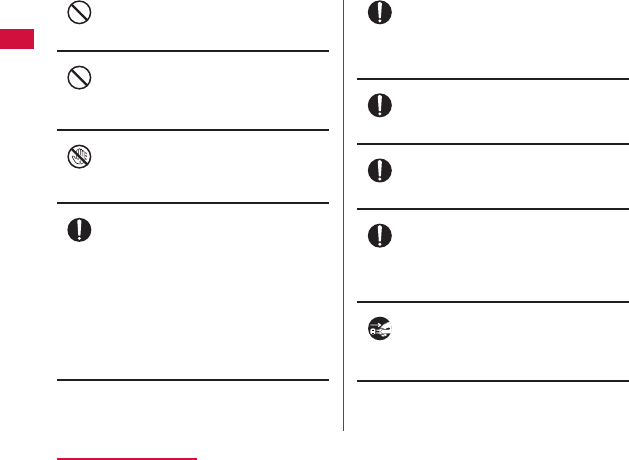
Don’t
Do not place heavy objects on the adapter
cord.
Fire, burns, or electric shock may result.
Don’t
When you insert and remove AC adapter from
the power outlet, do not contact a metal strap
or other metal objects with the terminal.
Fire, burns, or electric shock may result.
No
wet hands
Do not touch the Adapter cord or outlet with
wet hands.
Fire, burns, or electric shock may result.
Do
Only use with the specified power source
and voltage. When charging overseas, use a
compatible AC adapter.
If incorrect voltage is used, this may cause
fire, burns or electric shock.
AC adapter: AC 100V
DC adapter: DC 12V/24V (only for minus earth
car)
AC adapter for overseas use: Between
AC 100V and 240V (Connect to the AC outlet
for internal household use)
Do
Use the specified fuse when the fuse of DC
adapter blows.
Fire, burns, or electric shock may result. Refer
to the manual for detailed information of the
specified fuse.
Do
Wipe off any dust that accumulated on the
power plug.
Fire, burns, or electric shock may result.
Do
When you connect the AC adapter to an outlet,
do not fail to properly connect to the outlet.
Fire, burns, or electric shock may result.
Do
When you disconnect the power plug from the
outlet or cigar lighter socket, do not pull the
adapter cord with excessive force. Instead,
hold the adapter to disconnect.
Fire, burns, or electric shock may result.
Unplug
Always remove the power plug from the outlet
or cigar lighter socket when not using the
adapter for an extended period.
Fire, burns, or electric shock may result.
18
Contents / Precautions
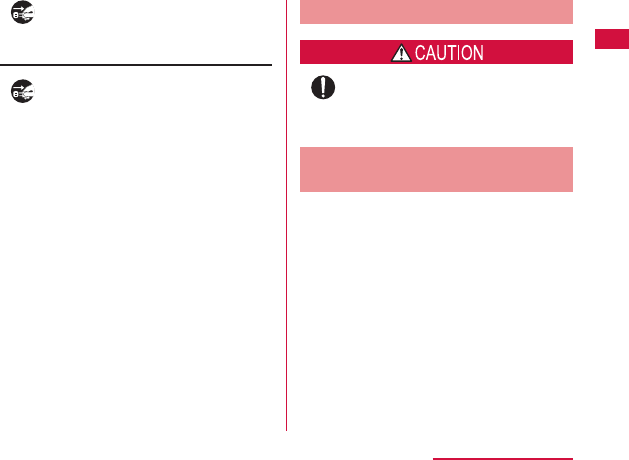
Unplug
Immediately remove the power plug from the
outlet or cigar lighter socket if water or other
fluids get into the adapter.
Fire, burns, or electric shock may result.
Unplug
Always remove the power plug from the outlet
or cigar lighter socket when cleaning the
equipment.
Fire, burns, or electric shock may result.
Precautions for UIM
Do
Be careful not to touch the edge of UIM when
removing it.
Injury may result.
Precautions on Using near
Electronic Medical Equipment
The description below meets "Guideline on the Use
of Radio-communication Equipment such as Cellular
Telephones - Safeguards for Electronic Medical
Equipment" by the Electromagnetic Compatibility
Conference.
19
Contents / Precautions
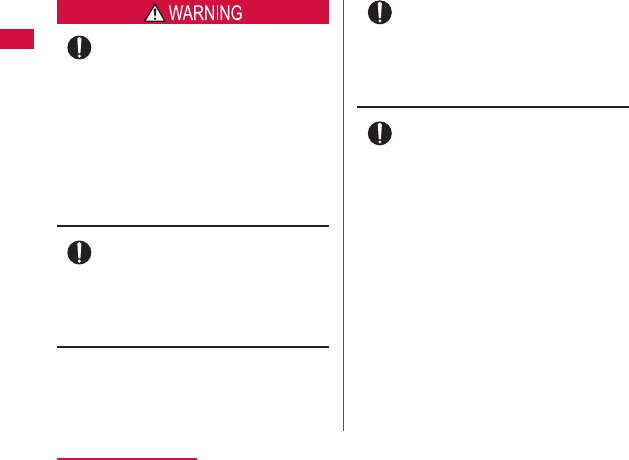
Do
Be sure to adhere to the following regulations
inside medical facilities.
•Keep the terminal out of operating rooms,
intensive care units (ICUs) or coronary care
units (CCUs).
•Turn off the terminal in hospital wards.
•Turn off the terminal in hospital lobbies
and corridors if electronic medical devices
could be nearby.
•If the medical facility has specific zones
where use or possession of mobile
terminals is prohibited, follow those
regulations.
Do
Turn off the terminal in crowded trains or
other public places where implanted cardiac
pacemaker or defibrillator wearers could be
nearby.
Operation of an implanted cardiac pacemaker
or implanted defibrillator may be adversely
affected by radio waves.
Do
If you use electronic medical equipment
such as an implanted cardiac pacemaker or
implanted defibrillator, use the mobile terminal
22cm or more away from the implanted cardiac
pacemaker or implanted defibrillator.
Operations of electronic medical equipment
may be adversely affected by radio waves.
Do
Patients using electronic medical equipment
other than implanted cardiac pacemakers or
implanted defibrillators (using outside medical
facilities for treatment at home, etc.) should
check the influence of radio waves upon the
equipment by consulting the manufacturer.
Operations of electronic medical equipment
may be adversely affected by radio waves.
20
Contents / Precautions
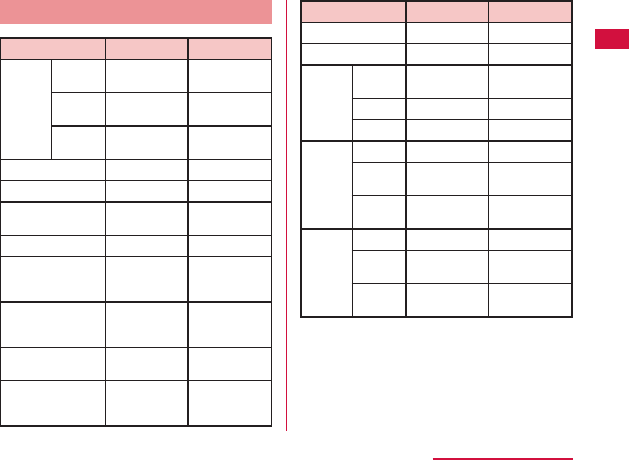
Material List
Part Material
Surface Treatment
Outer
case
Display Tem per ed
Glass -
Front
cover
PC resin NCVM
Back
cover
PC resin SF coating
Power key PC+TPU resin UV coating
Volume key PC+TPU resin UV coating
Camera panel Tempered
Glass
BK Rear
Printed
Flash panel PC resin Silk Print
Camera decoration AL Diamond-cut
aluminum
panel
microUSB
connector terminal
cover
PC+TPU resin UV coating
Battery
compartment
Diecasting
(Magnesium)
Urethane
coating
Charging terminal
connector (Battery
compartment)
Ti-Cu
-
Part Material
Surface Treatment
Speaker grill PET -
Screws Mild steel ZnB plating
Battery
pack
Battery
pack
PC resin PC resin
Sticker PET Ink coating
Terminals
Au + Ni Gold plating
microSD
card slot
Guide Stainless steel Nickel plating
Fixing
plate
LCP -
Metal
contacts
Phosphor
Bronze
Nickel and
Gold plating
UIM slot Guide SUS304 Nickel plating
Fixing
plate
LCP Pa46 -
Metal
contacts
C_7035 Nickel and
Gold plating
21
Contents / Precautions

Handling and Care
General Usage Guidelines
Keep this terminal away from water.
This terminal, battery pack, adapter and UIM are not
waterproof. Do not use them in places where high
humidity such as a bath or where rain may get it wet.
If you carry the terminal close to your body, moisture
from sweat may corrode the internal parts causing
a malfunction. Note that malfunctions deemed to be
caused by water are not covered by the warranty or
impossible to repair. Since these malfunctions are
not under warranty, even when repair is possible, it
will be done at the user's expense.
Clean the terminal with a dry, soft cloth (lens cleaning
cloth), etc.
•Rubbing it roughly with a dry cloth may scratch the
display.
•Drops of water or dirt left on the display may cause
stains.
•If the terminal is wiped with alcohol, paint thinner,
benzine or detergent, the printing may disappear
or color may fade.
Keep the connector contacts clean with a dry cotton
swab.
Clean the connector contacts with a dry cotton swab
to prevent contacts from getting dirty which can
result in intermittent connections.
Be careful when cleaning the connector contacts.
Do not place the equipment near air conditioner
outlets.
Condensation may form due to rapid changes in
temperature, and this may corrode internal parts and
cause malfunction.
Do not place excessive force on the terminal or
battery pack.
If the terminal is inserted to a full bag, or placed in a
pocket and sat on, the display, its internal PCBs or
battery pack may be damaged or malfunction.
Also, while the external device is connected to the
external connection terminal (microUSB connection
terminal and earphone/microphone terminal), it may
damage the connector and cause malfunction.
Do not rub or scratch the display with metal.
The display may get scratched and it may cause
malfunction or damage.
Read the individual manual attached to the battery
pack and adapter.
22
Contents / Precautions

Notes about the Terminal
Do not place excessive force on pressing the
touch panel, or operate by sharp objects such as
fingernails, ballpoint pen and pins.
Damage of touch panel may result.
Avoid using in extremely high or low temperatures.
The terminal should be used within a temperature
range from 5˚C to 35˚C and a humidity range from
45% to 85%.
This terminal may adversely affect fixed phones,
televisions or radios in use nearby. Use as far as
possible from such appliances.
Keep a separate record of any information stored on
this terminal and store the copies in a safe location.
DOCOMO assumes no responsibility for the loss of
any of your data.
Do not drop the terminal or subject it to shocks.
Damage or malfunction may result.
Do not insert a microUSB connection terminal,
earphone/microphone terminal crookedly or pull them
strongly.
Damage or malfunction may result.
It is normal for this terminal to become warm during
use. You can continue using without problems.
Do not leave the camera under direct sunlight.
Discoloring or burn-in of materials may result.
Always use the terminal with the microUSB connector
terminal cover closed.
Malfunction may result from dust or water.
Do not use the terminal without the back cover.
Battery pack may come off. Malfunction and damage
may result.
Do not remove microSD card or turn off the terminal
while using a microSD card.
Data loss or malfunction may result.
Do not bring any magnetic cards close to the terminal.
The magnetic data in cash cards, credit cards,
telephone cards, floppy disks, etc. may be erased.
Do not bring strong magnetic objects close to the
terminal.
Strong magnetism may cause malfunction.
23
Contents / Precautions

Notes about the Battery Pack
The battery pack is a consumable accessory.
Battery life varies depending on usage conditions,
etc., but it is time to change battery packs when the
usage time has become extremely short even though
the battery pack has been fully recharged. Change
to a specified new battery pack.
Charge the battery pack in an environment with the
proper ambient temperature (5˚C to 35˚C).
Battery life may differ depending on the use
environment or degradation level of the battery pack.
Depending on the usage condition, the battery pack
may inflate slightly when the battery life is almost
over. Note that it is not a problem.
Be careful especially about the following points when
storing the battery pack.
•Keeping under fully charged state (right after the
charging ends)
•Keeping under not charged state (consumed too
much to turn on the terminal)
The performance and life of the battery pack may
deteriorate.
It is recommended that you store the battery pack
with around 40% battery level.
Notes about the Adapter
Charge the battery pack in an environment with the
proper ambient temperature (5˚C to 35˚C).
Do not charge in the following places.
•Places that are very humid, dusty or exposed to
strong vibrations.
•Near ordinary phone or TV/radio.
It is normal that the adapter becomes warm while
being charged. You can continue using without
problems.
Use the DC adapter only when the car engine is
running.
The car battery may be exhausted.
When using an outlet with a mechanism preventing
unplugging, follow the handling instructions of the
outlet.
Do not give a strong impact to the adapter. Also, do
not deform the charging terminal or terminal guide.
Malfunction may result.
24
Contents / Precautions

Notes about the UIM
Do not put excessive force on the UIM when inserting
into or removing from this terminal.
Note that DOCOMO assumes no responsibility for
malfunctions occurring as the result of inserting and
using a UIM with other IC card reader/writer.
Always keep the IC portion of the UIM clean.
Clean the UIM with a dry, soft cloth (lens cleaning cloth),
etc.
Be sure to keep a separate note of the information
registered on the UIM.
DOCOMO assumes no responsibility for the loss of
any of your data.
Visit docomo Shop to return the UIM for the
environmental purpose.
Do not scratch, touch carelessly or short circuit the IC
portion.
Data loss or malfunction may result.
Do not drop or give force to the UIM.
Malfunction may result.
Do not bend or put heavy things on the UIM.
Malfunction may result.
Do not insert UIM into this terminal with labels or
stickers attached on.
Malfunction may result.
Notes about the Bluetooth
Function
To secure the Bluetooth communication security, the
terminal supports the security function compliant
with Bluetooth standards, but the security may not be
sufficient depending on the settings. Be aware of the
communication using the Bluetooth function.
Note that DOCOMO is not responsible for data or
information leakage when making data
communications using Bluetooth.
In the terminal, applications for Hands free, Headset,
Object push, Serial port, Audio, Phonebook access,
File transfer (server) are available. Also Audio/Video
remote control may be available for Audio (only
compatible Bluetooth devices).
25
Contents / Precautions
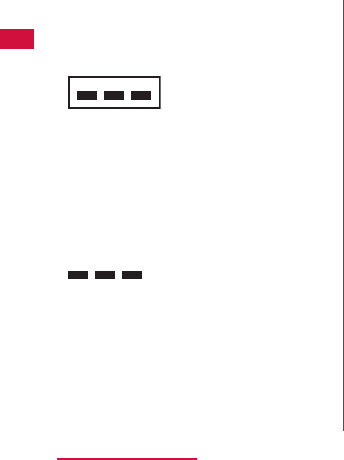
Frequency band
Frequency bands used by the terminal Bluetooth
function/Wireless LAN function are described on the
terminal battery compartment. They are described
as follows.
2.4FH1/DS4/OF4
2.4 : Indicates radio equipment using
2,400 MHz.
FH/DS/OF : Indicates that modulation methods
are FH-SS, DS-SS or OFDM.
1 : Indicates that assumed inducing
interference from distances is
10 m or less.
4 : Indicates that assumed inducing
interference from distances is
40 m or less.
: The full band between 2,400 MHz
and 2,483.5 MHz is used and the
band of the mobile identification
device is avoidable.
Available channels vary by the country.
For use in an aircraft, contact the airline company
beforehand.
Bluetooth Device Cautions
The operating frequency band of this terminal is
used by industrial, scientific, consumer and medical
equipment including microwave ovens, premises
radio stations for identifying mobile units used in the
manufacturing lines of plants (radio stations requiring
no license) and amateur radio stations (hereinafter
referred to as "another station").
1. Before using this terminal, confirm that "another
station" is not being operated nearby.
2. In the event of this terminal causing harmful
radio wave interference with "another station",
promptly change the location or stop radio
wave emission by turning off the power, etc.
3. If you have further questions, contact docomo
Information Center provided on the last page of
this manual.
26
Contents / Precautions

Notes about Wireless LAN (WLAN)
Wireless LAN (WLAN) uses radio waves to enable
communications between compatible devices, thus
allowing connection to a local area network from
anywhere within range. However, there is a risk of
data interception by malicious third parties unless
security is established. Users are advised to assess
their responsibilities and accordingly configure security
settings.
Wireless LAN
Do not use wireless LAN near magnetic devices
such as electrical appliances or AV/OA devices, or in
radio waves.
- Magnetism or radio waves may increase noises or
disable communications (especially when using a
microwave oven).
- When using near TV, radio, etc., reception
interference may occur, or channels on the TV
screen may be disturbed.
- If there are multiple wireless LAN access points
nearby and the same channel is used, search may
not work correctly.
2.4 GHz Device Cautions
The operating frequency band of the WLAN device
is used by home electrical appliances such as
microwave ovens, industrial, scientific, consumer and
medical equipment including premises radio stations
for identifying mobile units used in the manufacturing
lines of plants stations (radio stations requiring no
license) and amateur radio stations (radio stations
requiring a license).
1. Before using the device, confirm that premises
radio stations for identifying mobile units,
specified low power radio stations and amateur
radio stations are not being operated nearby.
2. If the device causes harmful radio interference
to premises radio stations for identifying mobile
units, immediately change the frequency band
or stop use, and contact "docomo Information
Center" on the last page of this manual for
crosstalk avoidance, etc. (e.g. partition setup).
3. If the device causes radio interference to
specified low power radio stations or amateur
radio stations, contact "docomo Information
Center" on the last page of this manual.
27
Contents / Precautions

Handling the FeliCa Reader/Writer
The FeliCa reader/writer function for this terminal
handles delicate signals that require no radio station
license.
The 13.56 MHz frequency band is used. If there is
another reader/writer near the terminal, keep enough
distance between the terminal and the reader/writer.
Also, make sure that there is no radio station using
the same frequency band nearby.
Caution
Do not use a modified terminal. Using a modified
terminal results in violating the law of Electromagnetic
Compatibility.
This terminal has been complied with technical
standard of wireless equipment stipulated by law of
Electromagnetic Compatibility. As a proof, "Technical
standard compliance mark " is indicated in the
inscription seal.
If this terminal is modified by turning the screw to the
left to disassemble, technical standard compliance
becomes invalid.
Please do not use this terminal during the time when
technical standard compliance is being invalid, since
you are in violation of the law of Electromagnetic
Compatibility.
Be careful when using the terminal while driving.
Using the mobile phone in your hand while driving is
subject to punishment.
However, absolutely necessary cases such as
rescue of a sick person or maintaining public safety
are exempted.
The FeliCa reader/writer function can only be used in
Japan.
The FeliCa reader/writer function for this terminal is
compliant with the radio standards for Japan.
Overseas usage may be subject to punishment.
Do not make unauthorized modifications to the basic
software.
Repairs may be refused if the software has been
modified.
28
Contents / Precautions
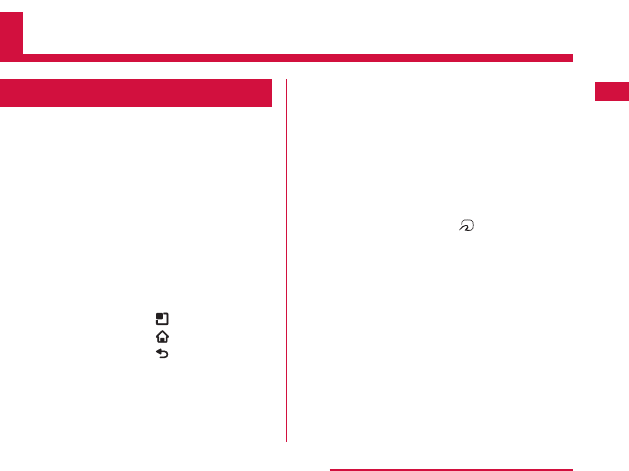
Confirmation and Settings before Using
Part Names and Functions
a Earpiece (receiver)
b Front camera
c Proximity sensor:
Switch the touch
screen to on or
off to prevent from
unintentionally
activating functions
resulted from face
touch while making a
call.
d Display (touch screen)
e Menu key
f Home key
g Back key
h Bluetooth/Wi-Fi
antenna area*2
i Main camera
j microSD card slot
(internal)
k Flash
l UIM slot (internal)
m GPS/Xi antenna area*2
n mark
o Back cover*1
p Speaker
q Xi antenna area*2
*1 Do not remove stickers from the back surface of the
back cover. If a sticker is removed, the IC card may
not be read or written.
*2 Antenna is built inside the terminal. If the antenna
area is covered by your hand, quality may be
affected.
29
Confirmation and Settings before Using
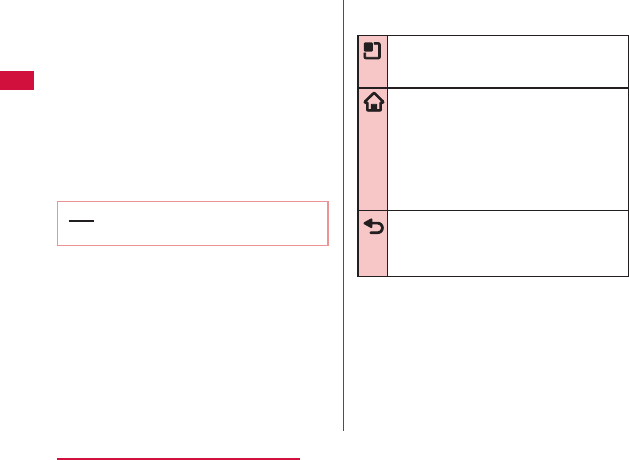
r Earphone microphone
terminal
s Top microphone
t microUSB connection
terminal
u Power key/Screen lock
key
v 1Seg antenna
w Volume key
x Bottom microphone
Note
•Do not put any sticker on the sensor area.
There are three keys on the front of the terminal. The
roles of these keys are shown below.
Menu key
Tap this key to display the options menu for
the current screen or application.
Home key
•If you tap this key, you will return to the
Home screen, regardless of the application
being used or the screen being displayed.
•If you touch this key for over 1 second, the
icons of the most recently used applications
appear. Tap an icon to open the application.
(It may be displayed as horizontal screen.)
Back key
Tap this key to return to the previous screen. It
also closes a dialog box, an options menu, the
Notification panel, or the on-screen keyboard.
30
Confirmation and Settings before Using

UIM
UIM is an IC card that stores informations of each
customer.
You cannot use some of the terminal functions if the
UIM is not inserted. Before inserting or removing
the UIM, you must always turn OFF the power and
disconnect the AC adapter cable.
This terminal uses only the UIM. Bring your miniUIM/
FOMA card to a docomo Shop to exchange it.
UIM security codes
The UIM can set security code named PIN code. This
code is set to "0000" at the time of subscription, but you
may subsequently change it. For details about changing
this security code, refer to "Security Code and UIM
Protection" (P111).
Inserting the UIM
a Insert a fingernail into the groove in the
back cover, and pull up in the direction
of the arrow (a) while pressing ● part
slightly to remove the back cover
31
Confirmation and Settings before Using

bRemove the battery pack (P35), and
insert the UIM into the slot with the gold-
colored IC side facing down
Removing the UIM
a Remove the back cover and the battery
pack. Gently press the UIM with your
fingertip and slide it out
32
Confirmation and Settings before Using

microSD Card
A microSD card can be used with any other compatible
devices.
•When a microSD card is not inserted, camera
functions and playing or downloading music or
videos are not available.
•The terminal supports a microSD card of up to 2
GB, and a microSDHC card of up to 32 GB (as of
November 2011).
•Consult with the manufacturers about the supporting
microSD cards.
Inserting a microSD Card
a Remove the back cover (P31)
bInsert the microSD card into the slot
with the metal contacts facing down
•Insert a microSD card properly, paying attention
to the insertion direction. Improper insertion of a
microSD card may damage the card itself and
the slot, or may be unable to eject the card.
Removing a microSD Card
a Remove the back cover and take out the
microSD card
33
Confirmation and Settings before Using

Battery Pack
Attaching the Battery Pack
a Remove the back cover (P31)
bInsert the battery pack in the direction of
the arrow (a) with the "CE" mark facing
up. Ensure that the tabs on the terminal
and the battery pack are aligned with
each other
cCheck the direction of the back cover
and attach it to the terminal (b). Press
portion to close it firmly (c)
•Make sure there is no gap between the terminal
and the back cover.
34
Confirmation and Settings before Using
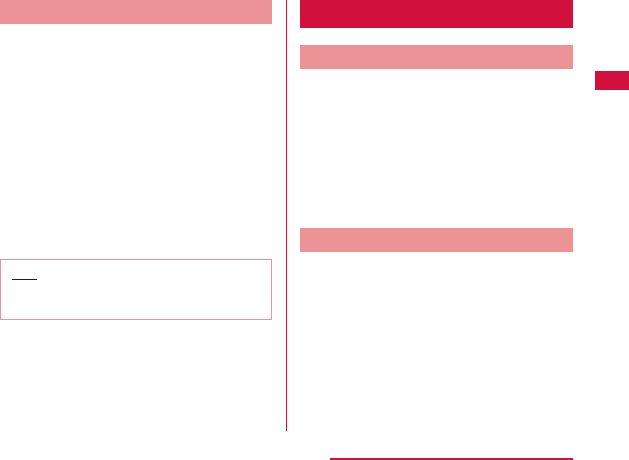
Removing the Battery Pack
a Remove the back cover (P31)
bPut your fingernail into the groove, and
lift out the battery pack in the direction
of the arrow (b), pushing it to the
direction of the arrow (a)
Note
•Turn the power OFF before attaching/removing
the battery pack.
Charging
Battery Pack Life
•The battery pack is a consumable accessory. The
usage time of the battery per one charge decreases
gradually each time the battery is recharged.
•When the usage time from one charge becomes
about half of a new battery pack, the life of the
battery pack is assumed to be almost over. We
recommend that you replace the battery ahead of
time. Refer to "Repairs" on the back of the manual
or consult a specified DOCOMO repair center for
battery exchanging information.
Battery Charging
•For detailed information, refer to manuals for FOMA
charging microUSB conversion adapter L01, FOMA
AC Adapter 01/02 (optional), FOMA AC Adapter 01
for Global use (optional) and FOMA DC Adapter
01/02 (optional).
•FOMA AC Adapter 01 only supports AC 100V.
FOMA AC Adapter 02 and FOMA AC Adapter 01 for
Global use support AC 100V to 240V.
35
Confirmation and Settings before Using
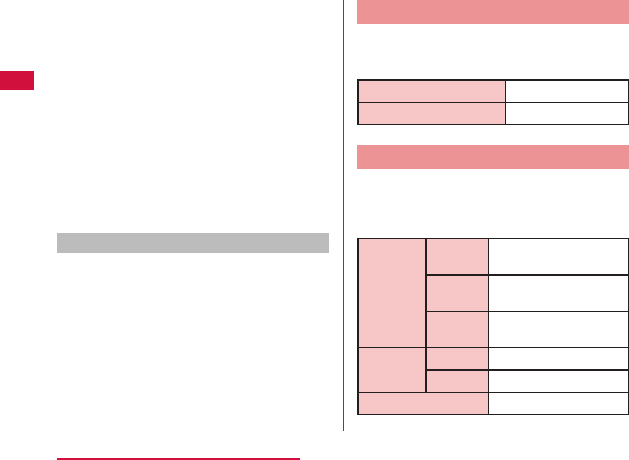
•The shape of the AC adapter plug is for AC 100V
(Japanese standard). The conversion plug adapter
for overseas is required if you use an adapter for
AC 100V to 240V. Also do not use a transformer for
overseas travel.
•Do not force the connector when inserting/pulling it
out. Instead, insert/pull it out slowly.
•If you start charging when the battery pack is empty,
you may not be able to power ON the terminal for a
while.
•Make sure to unplug the power cord after finishing
charging.
•When charging in combination with the FOMA
charging microUSB conversion adapter L01, it is not
possible to fully charge if charging starts when the
battery pack is empty.
Do not charge for a long time (several days)
•If you carry on charging the terminal after it has been
fully charged, the battery pack will start supplying
power to the terminal. This will reduce the actual
usage time and deplete the battery. If this happens,
please charge it again correctly. Before recharging,
remove the terminal from FOMA charging microUSB
conversion adapter L01 and reset.
Charging Time (estimate)
The estimated time for charging an empty battery pack
is shown below. Charging under low temperatures
requires longer time.
FOMA AC Adapter 01/02 Approx. 330 minutes
FOMA DC Adapter 01/02 Approx. 330 minutes
Usage Time (estimate)
A list of the charging time (estimate) of a fully charged
battery is shown below. The usage time varies depending
on the usage conditions and the battery pack condition.
For details, refer to "Main Specifications" (P225).
Continuous
standby
time
Xi/LTE Stationary (Automatic):
Approx. 240 hours
FOMA/3G Stationary (Automatic):
Approx. 300 hours
GSM Stationary (Automatic):
Approx. 240 hours
Continuous
call time
FOMA/3G Approx. 340 minutes
GSM Approx. 240 minutes
1Seg watching time Approx. 240 minutes
36
Confirmation and Settings before Using
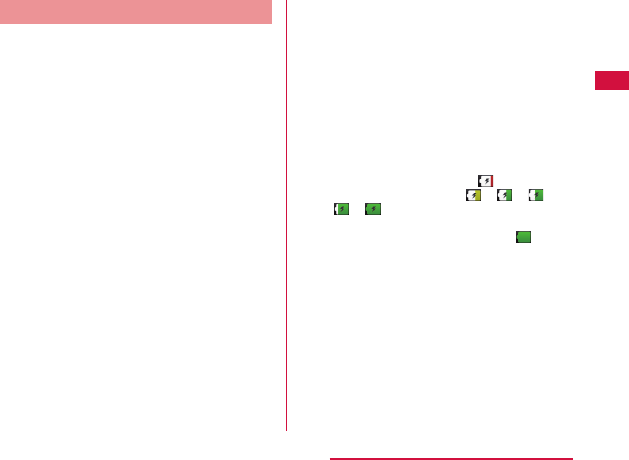
Charging with the AC Adapter
How to use the supplied AC adapter to charge the
terminal is described below.
a Insert the USB connector of the supplied
USB connection cable into the USB
connection terminal of AC adapter
bOpen the microUSB connector terminal
cover of the terminal
cInsert the microUSB connector of USB
connection cable into the microUSB
connection terminal of the terminal
•Insert the USB connection cable horizontally
with the USB mark facing up.
dInsert the AC adapter plug into the power
outlet
•During charging, the battery level icon in the
status bar either appears like or changes its
appearance in the order of u u u
u .
•When the battery pack is fully charged, the battery
level icon on the status bar changes to .
eWhen charging is completed, remove
the microUSB connector from the
terminal and close the microUSB
connector terminal cover
fRemove the USB connector of USB
connection cable from the USB connection
terminal of AC adapter
g
Remove AC adapter plug from power outlet
37
Confirmation and Settings before Using

Charging with the Desktop Holder
Using the optional desktop holder L12, you can charge
by attaching the terminal, and also charge by attaching
the battery pack L15.
By dragging the terminal display while charging, it is
possible to display the clock and calendar, and to use
the slideshow of images stored in the Gallery.
Charging by attaching the terminal
a Insert the USB connector of the supplied
USB connection cable into the USB
connection terminal of AC adapter
bInsert the microUSB connector of the
USB connection cable into the connection
terminal on the back of the desktop holder
L12.
•Insert the USB connection cable horizontally
with the USB mark facing up.
•The charge indicator on the desktop holder
blinks Red → Green → Orange.
cOpen the microUSB connector terminal
cover of the terminal
dWhile holding the desktop holder L12,
insert the terminal in the a direction
shown in the figure, and then attach it
firmly to the connection terminal of the
desktop holder L12
38
Confirmation and Settings before Using

eInsert the AC adapter plug into the outlet
•Charging begins. The charge indicator turns
OFF during charging.
•After charging is completed, a message
explaining that charging is completed is
displayed on the screen.
fWhen charging is completed, remove
the terminal according to the reverse
procedure while holding the desktop
holder L12
g
Remove AC adapter plug from power outlet
Charging by attaching only the battery
pack
You can insert the battery pack to the slot opening
for the battery pack on the top surface of the desktop
holder L12 for charging. The charge indicator turns
red during charging. After charging is completed,
the charge indicator turns green.
Charging by attaching the battery pack
and terminal together
Charging begins for the terminal first. The charge
indicator turns OFF while the terminal is charging.
After charging of the terminal is completed, the
battery pack begins to charge. At that time, the
charge indicator turns red.
Charging with a PC
a Open the microUSB connector terminal
cover of the terminal
bInsert the microUSB connector of USB
connection cable into the microUSB
connection terminal of the terminal
cConnect USB connector of USB connection
cable to PC USB port
d"Charge only" u "OK"
•For details about the connection method
between the terminal and PC, refer to
"Connecting the Terminal with a PC" (P138).
eWhen charging is completed, remove
the microUSB connector from the
terminal and close the microUSB
connector terminal cover
fRemove the USB connector from the PC
USB port
39
Confirmation and Settings before Using
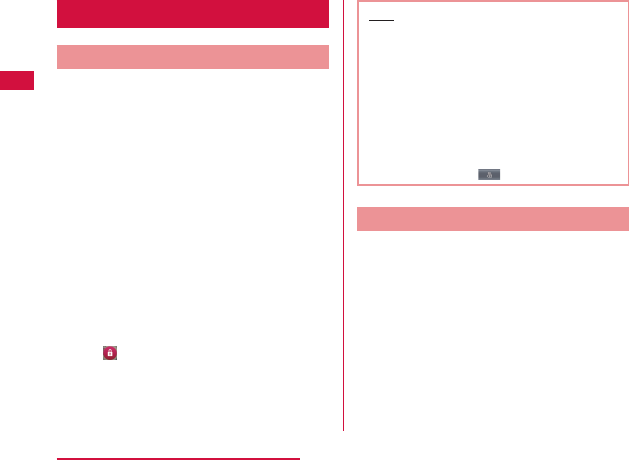
Turning ON/OFF the Power
Turning ON the Power
a Press and hold the power key for over 1
second
bTap to release the screen lock.
Note
•The "Locked" screen appears when the power is
turned ON or when the backlight is turned on.
•If the screen lock has been set using a screen
unlock pattern, the "Draw pattern to unlock"
screen appears when the power is turned ON.
•If the screen lock has been set using a PIN code
or password, the "Locked" screen appears
when the power is turned ON. After releasing
the screen lock by following Step 2, enter the
PIN code or password and tap "OK". To correct
the typing error, tap .
Turning OFF the Power
a Press and hold the power key for over 1
second
b"Power off"
c"OK"
40
Confirmation and Settings before Using

Turning on Backlight
To prevent unintended operation and to save power,
the backlight turns off after a set period. If you then turn
on the backlight to release the screen lock, the screen
that was displayed before the backlight was turned off
appears again.
a Press the power key
•The "Locked" screen appears. The backlight
automatically lights up when you receive a call
or when alarm is ringing.
Note
•Screen gets locked if pressing the power key
while the backlight is on.
•You can set the length of time before the
backlight turns off. For details, refer to "Display"
(P109).
•If a screen unlock pattern has been set, you will
be prompted to enter the pattern when pressing
the power key. For more details about setting a
screen unlock pattern and releasing the screen
lock, refer to "Location & Security" (P110).
Basic Operations (Touch
Screen Operations)
The display of the terminal has a touch screen that
allows you to perform various operations by touching it.
Precautions on Using Touch Screen
The touch screen has been designed for finger touching
slightly. Do not press it with sharp objects (fingernail,
ballpoint pen, pin etc.) or press it hard with your finger.
The following user actions may cause the touch screen
not to work properly. They may also cause malfunction.
•Touching the screen with gloved hands
•Touching the screen with the tip of a fingernail
•Placing a foreign object on the screen
•Sticking a protective sheet or seal on the screen
41
Confirmation and Settings before Using
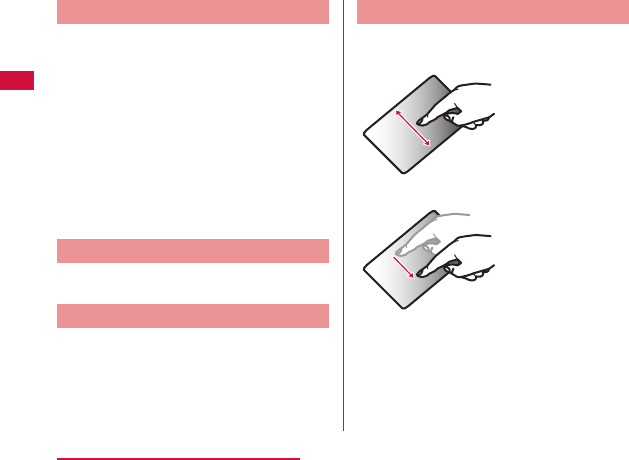
Touch Screen Operations
You can perform the following actions on the touch
screen.
•Tap: Touch the screen lightly
•Double-tap: Touch the screen lightly twice
successively
•Touch for over 1 second: Touch and hold down the
screen
•Swipe: Lightly flick the screen
•Drag: Touch and hold down to flick the screen, and
then release your finger
•Pinch-out: Touch the screen with 2 fingers and then
move them apart
•Pinch-in: Touch the screen with 2 fingers apart and
then move them together, as if pinching
Opening Items
a Tap an item
Checking or Unchecking Options
a Tap an item that has a checkbox
•If the checkbox was unmarked, a check mark
now appears in it.
•If the checkbox was marked, the check mark
now disappears from it.
Scrolling Screen
You can scroll the screen up or down. On some web
pages, you can also scroll side to side.
Drag up or down to
scroll.
Swipe to scroll quickly.
To stop scrolling, touch
the screen.
42
Confirmation and Settings before Using
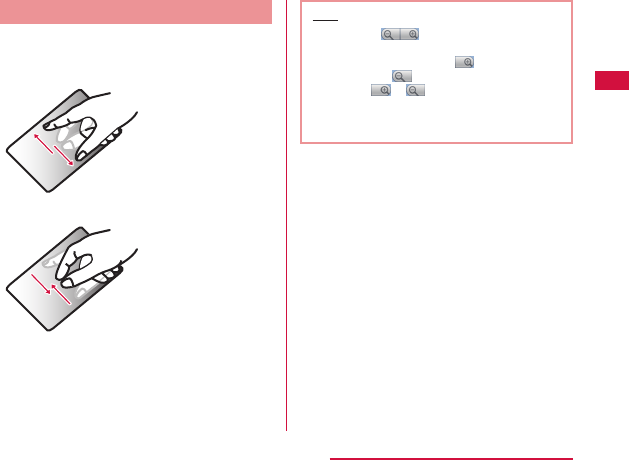
Zooming In or Out
Some applications allow you to zoom in on small text
that is difficult to read. After zooming in, you can also
zoom out to a full-screen view.
The movement of your
fingers enlarges the
screen display by
pinching it out.
•The movement of
your fingers reduces
the screen display by
pinching it in.
•Pinch in on the Home
screen to display the
Home screen list, and
then set the Home
screen.
Note
•Sometimes appears when you drag the
screen. You can also zoom in or out by tapping
this zoom control icon. Tap to zoom in by
one level. Tap to zoom out by one level.
However, or grays out if you have
already zoomed in to the maximum or zoom out
to the minimum. This grays out indicates that
you cannot zoom in or out any further.
43
Confirmation and Settings before Using
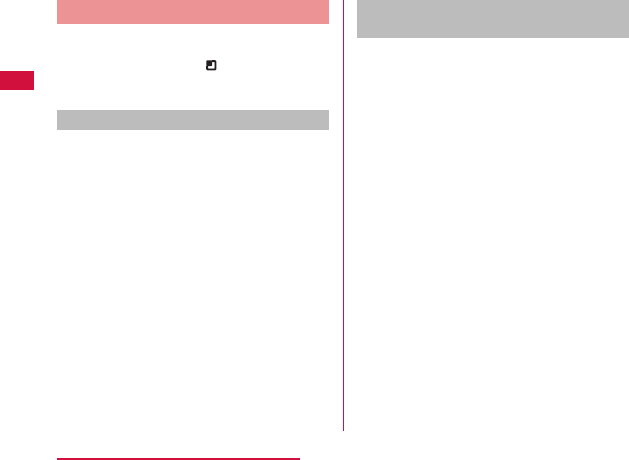
Using Motion Gesture
Various functions can be operated simply by moving the
terminal.
•To use motion gestures, tap u "Settings" u
"Gesture" from the Home screen, and place a check
mark in each item.
Using motion gesture on alarm
Stopping alarm
a Flip the terminal while alarm is ringing
•Alarm stops.
Using motion gesture while an incoming
call arrives
Muting ringtone
a When an incoming call arrives, flip the
terminal
•The ringtone is muted.
44
Confirmation and Settings before Using
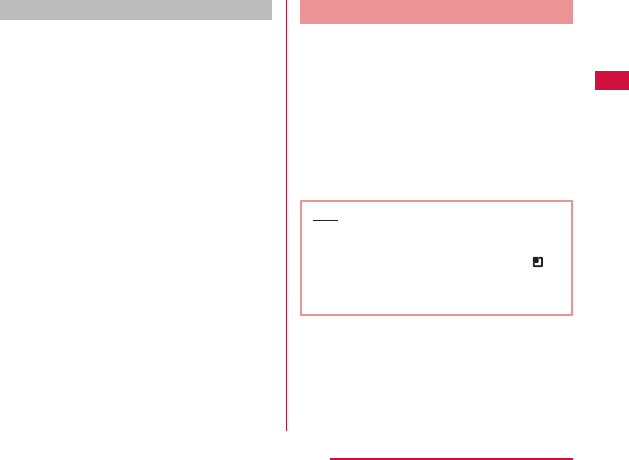
Using motion gesture in gallery
Viewing previous/next image
a While an image in gallery is being
displayed, tap the left or right side of the
terminal
•The left or right image is displayed.
Changing Screen Orientation
The terminal screen automatically rotates to horizontal
(landscape) or vertical (portrait) views, depending on
the direction in which it is turned.
Note
•Screen orientation may not change in some
applications.
•You can disable screen rotation by tapping u
"Settings" u "Display" on the Home screen, and
unmarking the "Auto-rotate screen" checkbox on
the "Display settings" screen.
45
Confirmation and Settings before Using

Initial Settings
First-time Settings
When the power is first turned ON, you need to set the
language and date for the terminal. Once you set those
settings, there is no need to set them the next time the
power is turned ON. You can also change these settings
later.
•Procedures differ depending on the connection with
network and settings. Here, an explanation is given
for the docomo Palette UI.
a Press and hold the power key for over 1
second
bTap to cancel the screen lock
cOn the "あなたのL-05Dです。ガイドに
沿って設定をはじめましょう" screen, tap
"続ける"
d"English (United States)" / "日本語" on
the "言語の選択" screen
eSet each item on the "Set date & time"
screen and tap "Next"
f"Mobile network or Wi-Fi" / "Wi-Fi only"
on the "Set internet connection" screen
g
Set each item on the "Wi-Fi settings"
screen and tap "Next"
hTap "Next" on the "Add a Google
account" screen and set by following
screen instructions
•If you tap "Skip", you can skip the operation and
make the settings later.
i"OK" on the "Software Update" screen
j
"Next" on the "docomo service initial
settings" screen
k
"Install" / "Not install" on the "Install all
apps" screen
u
"Next"
l
"Set"
/
"Not set"
on the
"Use Osaifu-
Keitai" screen
u
"Next"
m
Tap "Set" on the "docomo apps
password settings" screen, input a
docomo apps password, and then tap
"OK"
n
"Location providing ON" / "Location
providing OFF" / "Unknown blocking"
on the "Location providing setting"
screen
u
"Next"
o
"OK" on the "Complete setting" screen
46
Confirmation and Settings before Using
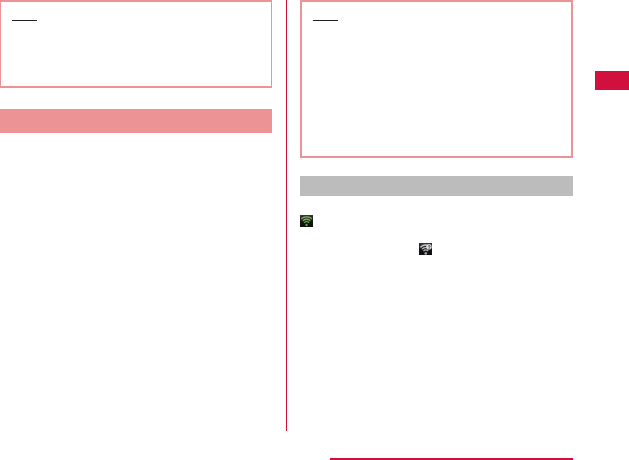
Note
•A data connection (LTE/3G/GPRS) is required
to set online services. For details on enabling
data connection, refer to "Wireless & Networks"
(P101).
Configuring Wi-Fi Settings
The terminal connects to the Internet via access points
for Wi-Fi networks or public wireless LAN services.
To connect, you must configure the access point
connection settings on the terminal.
Reception interference caused by Bluetooth devices
•As the terminal's wireless LAN devices and
Bluetooth device use the same frequency
(2.4 GHz), reception interference may occur or the
communications speed may lower. Also, you may
hear noise or have a connection problem. In these
cases, do the following:
- Keep the wireless LAN device over 10 m away
from the Bluetooth device.
- Within 10 m, turn off either the wireless LAN
device or the Bluetooth device.
Note
•Packet communication can be connected, even
when Wi-Fi function is ON. However, while Wi-
Fi is available, Wi-Fi is prioritized. When the
Wi-Fi network is disconnected, the terminal
automatically connects to the LTE/3G/GPRS
network. Packet communication charges apply
if you use it with LTE/3G/GPRS connected.
•You can reduce battery consumption by turning
OFF Wi-Fi when you are not using it.
Wi-Fi network status
When the terminal is connected to a Wi-Fi network,
appears in the status bar. An open network with
no security protection is detected when Wi-Fi network
notification is set to ON, always appears in the status
bar.
47
Confirmation and Settings before Using
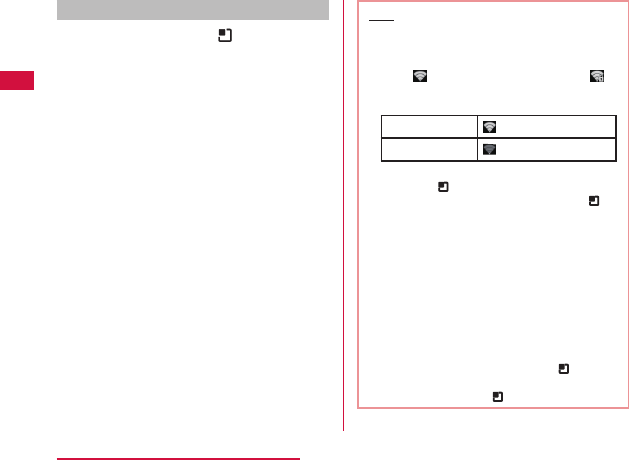
Connecting to a Wi-Fi network
a From the Home screen, u "Settings"
u "Wireless & networks"
•The "Wireless & network settings" screen
appears.
bPlace a check mark on "Wi-Fi"
c"Wi-Fi settings"
•The "Wi-Fi settings" screen appears.
dTap the Wi-Fi network that you want to
connect to
•If you try to connect to a protected Wi-Fi
network, you will be prompted to enter the
security key for that Wi-Fi network. Tap the
"Password" box, enter the network password
and tap "Connect".
•Usually, when you enter a password, the last
character entered is displayed and as many
"・" as the number of characters appear instead
of previously entered characters. All characters
can be displayed when you place a check mark
on "Show password".
Note
•There are two types of available networks - open
networks and protected networks. The network
type is indicated by an icon to the network
name. represents an open network and
represents a protected network.
•The icon also indicates the signal strength.
Strong signal
Weak signal
•To search Wi-Fi network again, from the Home
screen, tap u "Settings" u "Wireless &
networks" u "Wi-Fi settings", and then tap u
"Scan".
•Network name does not appear depending
on the settings for the access point even if the
network is connectable. If this happens, you can
still connect to the network. Refer to "Adding a
Wi-Fi network" (P50).
•When establishing a Wi-Fi network connection,
the required information is generally obtained
from a DHCP server automatically. However, it is
possible to specify these items separately.
•To check the Wi-Fi MAC address and IP
address, from the Home screen, tap u
"Settings" u "Wireless & networks" u "Wi-Fi
settings", and then tap u "Advanced".
48
Confirmation and Settings before Using
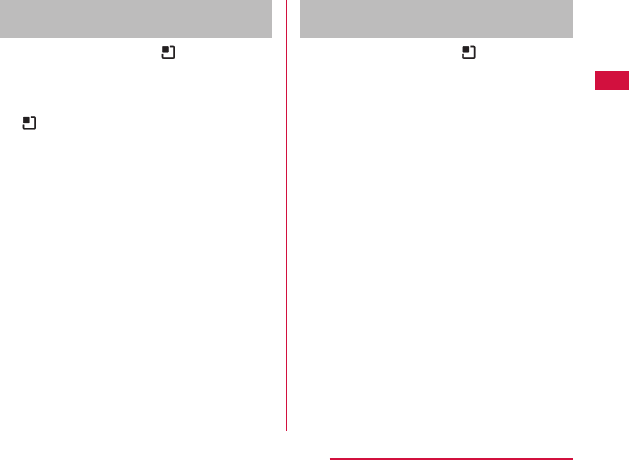
Connecting to a Wi-Fi network by
specifying a static IP address
a From the Home screen, u "Settings"
u "Wireless & networks" u "Wi-Fi
settings"
•The "Wi-Fi settings" screen appears.
b u "Advanced"
cPlace a check mark on "Use static IP"
dTap in the order of "IP address",
"Gateway", "Netmask", "DNS 1", and
"DNS 2" to set
•A menu appears for each item. Set the
appropriate value for each item. Make sure
to enter value on "IP address", "Gateway",
"Netmask", and "DNS 1".
Notifying when Wi-Fi network with no
security protection is detected
a From the Home screen, u "Settings"
u "Wireless & networks" u "Wi-Fi
settings"
•The "Wi-Fi settings" screen appears.
bPlace a check mark on "Wi-Fi"
cPlace a check mark on "Network
notification"
•You will be automatically notified when an open
network with no security protection is detected.
49
Confirmation and Settings before Using
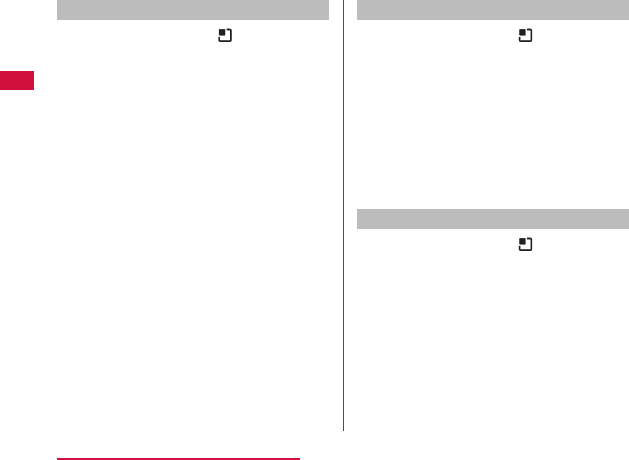
Adding a Wi-Fi network
a From the Home screen, u "Settings"
u "Wireless & networks" u "Wi-Fi
settings"
•The "Wi-Fi settings" screen appears.
bPlace a check mark on "Wi-Fi"
c"Add Wi-Fi network"
•The "Add Wi-Fi network" menu appears.
dEnter the network SSID in the "Network
SSID" box
e"Security"
•"Security" menu appears. Select the appropriate
type from "Open", "WEP", "WPA/WPA2 PSK", and
"802.1x EAP".
•The setting method differs depending on the
security settings.
f"Save"
•The Wi-Fi network is added.
Changing the Wi-Fi network password
a From the Home screen, u "Settings"
u "Wireless & networks" u "Wi-Fi
settings"
•The "Wi-Fi settings" screen appears.
bTouch the Wi-Fi network name for over 1
second
•A menu appears.
c"Modify network"
•The network settings are displayed. Tap the
"Password" box and enter the new password.
Disconnecting from a Wi-Fi network
a From the Home screen, u "Settings"
u "Wireless & networks" u "Wi-Fi
settings"
•The "Wi-Fi settings" screen appears.
bTouch the name of Wi-Fi network that
you want to disconnect from for over 1
second
•A menu appears.
c"Forget network"
•You are disconnected from the Wi-Fi network.
50
Confirmation and Settings before Using
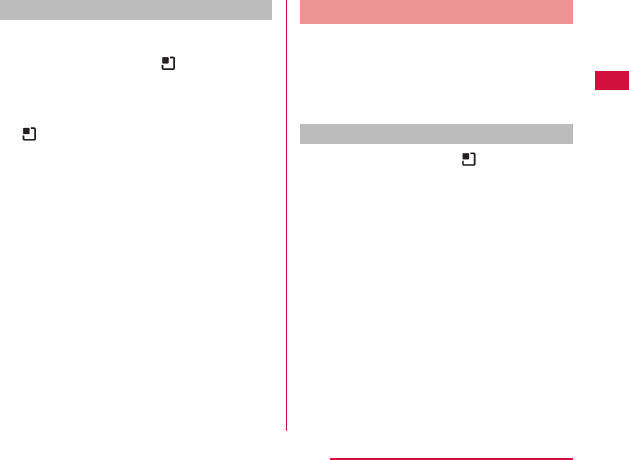
Setting Wi-Fi to sleep mode
Set Wi-Fi to sleep mode and specify the timing of
switching the terminal to data communications.
a From the Home screen, u "Settings"
u "Wireless & networks" u "Wi-Fi
settings"
•The "Wi-Fi settings" screen appears.
b u "Advanced"
c"Wi-Fi sleep policy"
•"Wi-Fi sleep policy" menu appears. Choose from
"When screen turns off", "Never when plugged
in" and "Never".
Setting Online Service Accounts
You can update your status on Google and other online
services once you have set up your online service
account on the terminal. You can also configure the
terminal to automatically sync updates from the online
service.
You can also delete unnecessary accounts.
Adding an online service account
a From the Home screen, u "Settings"
u "Accounts & sync"
•The "Accounts & sync settings" screen appears.
b"Add account"
•The "Add an account" screen appears.
c
Tap the online service that you want to set
an account
•Follow the screen instructions and enter your
login details.
•When you have finished adding the account, the
added online service appears in the "Manage
accounts" group.
51
Confirmation and Settings before Using
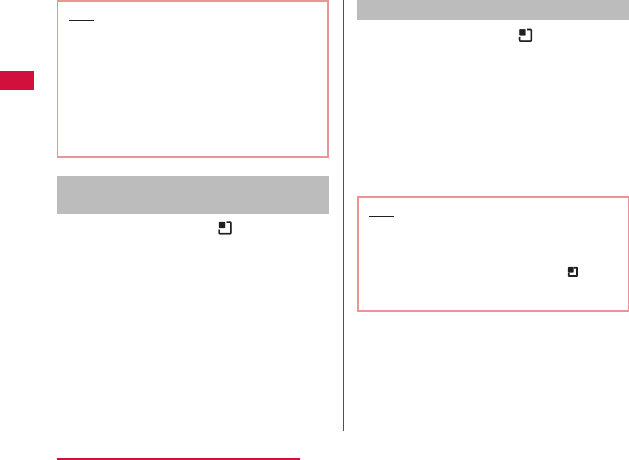
Note
•If you mark the "Background data" checkbox,
all installed applications on the terminal
will automatically communicate with their
respective services. If you mark the "Auto-
sync" checkbox, the applications will also
automatically synchronize data with their
respective services. These operations may incur
packet communication charges. Marking these
checkboxes also runs down the battery.
Manually synchronizing online service
data
a From the Home screen, u "Settings"
u "Accounts & sync"
•The "Accounts & sync settings" screen appears.
bTap the account that you want to
synchronize with
•A list of online service's synchronized data
appears.
•The data with a check mark is synchronized.
cPlace a check mark on synchronized
data
•The data with a check mark is synchronized.
Deleting an online service account
a From the Home screen, u "Settings"
u "Accounts & sync"
•The "Accounts & sync settings" screen appears.
bTap the account that you want to delete
•The "Data & synchronization" screen appears.
c"Remove account"
•The "Remove account" screen appears.
d"Remove account"
•The selected account is deleted.
Note
•The Google account that you set for the first
time cannot be deleted with the operation
above. To delete it, initialization of the terminal
is required from the Home screen, tap u
"Settings" u "Privacy" u "Factory data reset".
•docomo account cannot be deleted.
52
Confirmation and Settings before Using
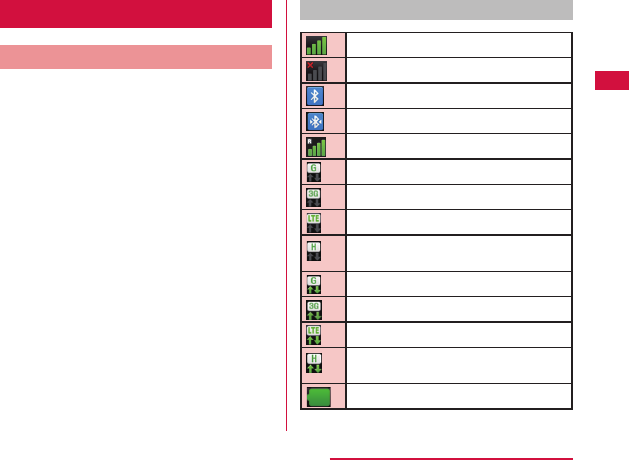
Screen Display/Icons
Status Bar
The status bar is displayed at the top of the screen. The
terminal status and notifications are displayed in the
status bar. Notification icons are displayed on the left
side, and the terminal status icons are displayed on the
right side.
Main status icons
Signal strength
Out of service area
Bluetooth ON
Connected to Bluetooth device
When you are roaming overseas
GPRS available
3G available
LTE available
FOMA high speed/HSDPA network
available
Communicating by GPRS
Communicating by 3G
Communicating by LTE
Communicating by FOMA high speed/
HSDPA network
Battery level
53
Confirmation and Settings before Using
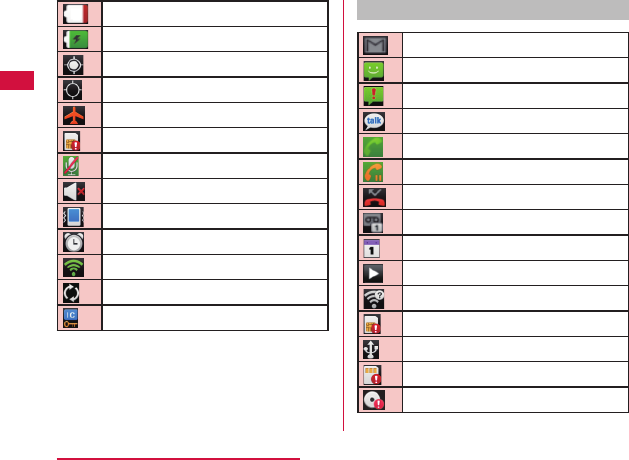
The battery needs to be charged
The battery is charging
GPS enabled
GPS is positioning
Airplane mode activated
UIM locked or UIM not inserted
Phone microphone is muted
Silent mode is set (no vibration)
Silent mode is set (vibration)
Alarm is set
Connected to Wi-Fi
Synchronizing data
Osaifu-Keitai lock activated
Main notification icons
New Gmail
New SMS message
Problem with an SMS message
New Google Talk message
Making a call or during a call
Call on hold
Missed call
New voicemail message
Upcoming calendar event
Music is playing
Discovered Open Network (Wi-Fi)
UIM is not inserted
USB is connected
microSD card is not inserted
No space in the microSD card
54
Confirmation and Settings before Using
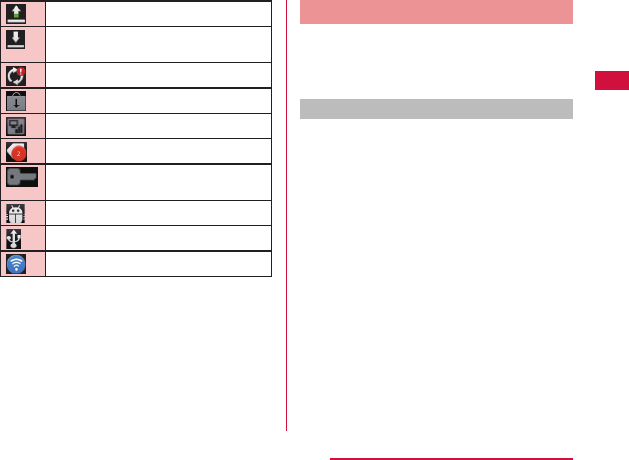
Uploading data
Downloading data/Data download
completed
Problem with login or synchronization
Update of installed application available
Viewing 1Seg
More notifications
Connected to a VPN/Not connected to a
VPN
USB debug mode is connected
USB tethering available
Wi-Fi tethering available
Notification Panel
Notification icons are displayed in the Notification
panel. You can open notifications, such as messages,
reminders, or event notifications, directly from the
Notification panel.
Opening the Notification panel
a Drag or swipe the status bar downwards
•The Notification panel appears. Icons are
displayed at the top of the Notification panel.
Icons are blue when they are on, and gray when
they are off.
55
Confirmation and Settings before Using
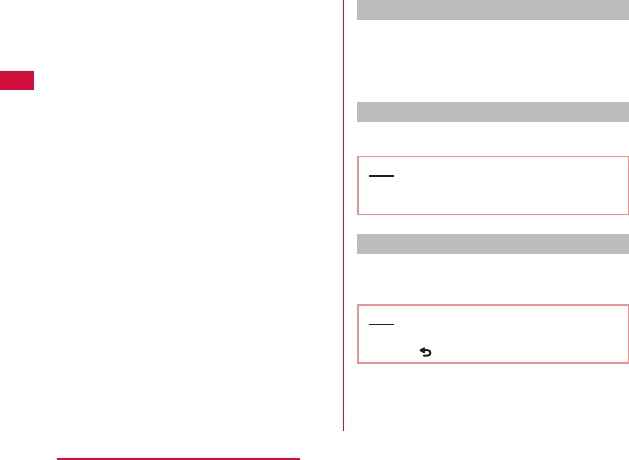
a Silent mode
Switch between on and off. Touch for over 1 second
to display the "Sound settings" screen.
b Wi-Fi
Switch between on and off. Touch for over 1 second
to display the "Wi-Fi settings" screen.
c Bluetooth
Switch between on and off. Touch for over 1 second
to display the "Bluetooth settings" screen.
d GPS
Switch between on and off. Touch for over 1 second
to display the "Location & security settings" screen.
e Mobile network settings
When Wi-Fi is not available, set if access to mobile
network. Touch for over 1 second to display "Mobile
network settings" screen.
f Clear
Delete notification information and icons.
g Notification information
Display details of notification information.
Viewing notification details
a Tap the notification message on the
Notification panel
•The notification details are displayed in the
appropriate application.
Clearing notification informations
a Tap "Clear" on the Notification panel
Note
•Some notifications cannot be cleared,
depending on their content.
Closing the Notification panel
a Drag or swipe the bottom of the
Notification panel upwards
Note
•You can also close the Notification panel by
tapping .
56
Confirmation and Settings before Using

Character Entry
The terminal has an on-screen keyboard that is
displayed in the touch screen for character entry.
Character Entry Using the On-
screen Keyboard
If you tap a text box on the screen, the on-screen
keyboard appears in the touch panel. The terminal
provides two types of on-screen keyboards: an on-
screen 10-key keyboard and an on-screen QWERTY
keyboard.
Tap key icon to switch the entry operation such as
character mode change.
On-screen 10-key keyboard
Use this for entering Japanese in "Kana character
input".
On-screen QWERTY keyboard
Use this for entering Japanese in "Roman letter
input".
a Reverse order key/Undo key
Displays the previous character (reverse
sequence). When "Undo" is displayed, this undoes
the last operation.
b Left cursor key
The highlight moves to the left. Touch this for over 1
second to move it continuously. It can also narrow
the conversion range.
c Symbol key
Displays a list of pictograms, symbols and
emoticons.
d Switch character mode key/Setting key
Switch the character mode. Touch for over 1 second
to display "iWnn IME Menu".
57
Confirmation and Settings before Using
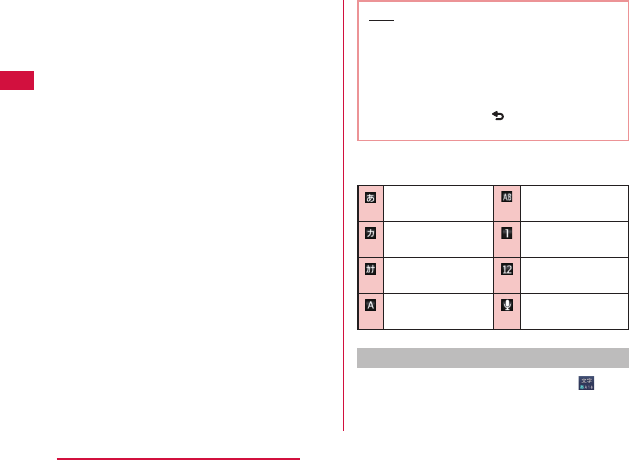
e Deletion key
Deletes the character to the left of the cursor. Touch
this for over 1 second to delete the characters
continuously.
f Right cursor key
The highlight moves to the right. Touch this for over
1 second to move it continuously. It can also widen
the conversion range. Also, if you tap this icon when
the highlight is at the right end of an unconfirmed
character string, the number of characters
applicable to predictive conversion increases.
g Space key/Conversion key
Enter a space. Execute consecutive segment
conversions.
h Execution key/Enter key
Confirms the entered characters or converted
characters. If the entered characters or converted
characters have already been confirmed, this
executes the function of the text box in which the
characters were entered.
i Shift key
Switch between upper case letter and lower case
letter.
Tap once: Only the first letter is capitalized
Tap twice: All letters are capitalized
Tap three times: Lowercase
Note
•The key display varies depending on the entry
screen or character mode.
•For information on switching the type of on-
screen keyboard, refer to "Switching the
keyboard" (P58).
•When you no longer need the keyboard, you
can close it by tapping . To display it again,
tap the text box on the screen.
There are 8 character input modes. The current mode is
indicated by the following icons in the status bar.
Hiragana and Kanji
input
Half-width alphabet
input
Full-width Katakana
input
Full-width number
input
Half-width Katakana
input
Half-width number
input
Full-width alphabet
input
Voice Input
Switching the keyboard
a On the on-screen keyboard, touch for
over 1 second
•"iWnn IME Menu" appears.
58
Confirmation and Settings before Using
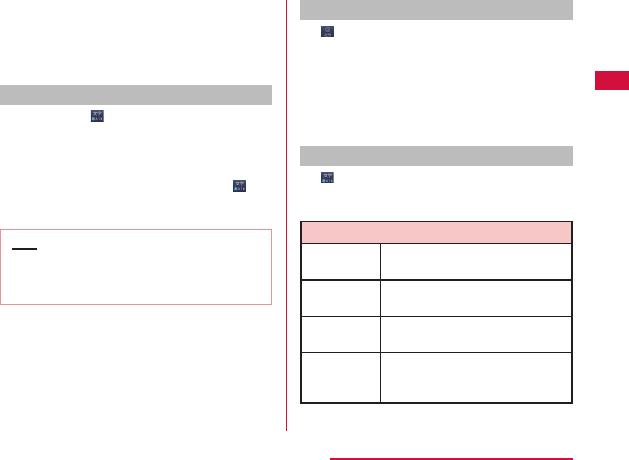
b"10-key ⇔ QWERTY"
•The keyboard is switched.
•When the input mode is changed, the keyboard
switches automatically. Switch back using "10-
key ⇔ QWERTY".
Switching the character mode
Each time you tap on a character entry screen, the
character mode switches in the order of "Hiragana-
Kanji" u "Half-width Alphabet" u "Half-width Numeric".
If you check "Voice Input" on "Common Keyboard
Settings", voice input is enabled.
You can also switch the input mode by touching for
over 1 second and then tapping "Input Mode" on the
"iWnn IME Menu" that appears.
Note
•In some character entry screens, certain
character modes may not be available or
selectable.
Entering symbols/emoticons
Tap in a character entry screen to switch to symbol/
emoticon input mode, and display the available symbols
and emoticons on the display.
Tap "Symbol" and "Emoticon" to display respectively
the available symbols and emoticons. Tap one of the
available symbols or emoticons to enter it.
Tap "文字" to return to the on-screen keyboard that was
displayed before the symbol or emoticon was entered.
Changing character entry settings
Tap for over 1 second on a character entry screen
to display "iWnn IME Menu". Tap "Change Settings" to
change the character entry settings.
Common Keyboard Settings
Sound on Key
Press
Mark this checkbox to play a brief
sound on each key press.
Vibrate on
Key Press
Mark this checkbox to make the
terminal vibrate on each key press.
Key Preview Mark this checkbox to display an
enlarged popup of the entered key.
Auto
Capitalization
Mark this checkbox to automatically
capitalize the first letter of the first
word at the beginning of a sentence.
59
Confirmation and Settings before Using
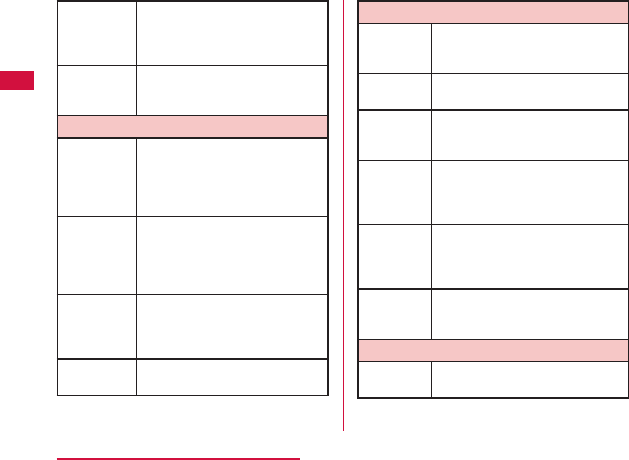
Keyboard
Type
This allows you to set the type of
keyboard to use on each screen
view (horizontal/vertical) or for each
input mode.
Voice Input Mark the checkbox to enable voice
input, and add it to the character
entry modes.
10-key Keyboard
Flick Input Mark this checkbox to change the
input method on the on-screen 10-
key keyboard to flick input. Unmark
this checkbox to change it back to
toggle input.
Flick
Sensitivity
If you tap this when the "Flick
Input" checkbox is marked, the
"Flick Sensitivity(Low⇔High)" menu
appears, allowing you to set the flick
sensitivity using a slide bar.
Toggle Input If you mark this checkbox when the
"Flick Input" checkbox is marked,
toggle input is enabled as well as
flick input.
Auto Cursor
Movement
Specify the speed for auto cursor
movement.
Conversion
Input Word
Learning
If you mark this checkbox, the phrase
confirmed by the conversion process
is learned by iWnn IME.
Word
Prediction
Mark this checkbox to display the
predictive conversion candidates.
Typing Error
Correction
Mark this checkbox to display the
candidates for corrections for input
errors.
Wildcard
Prediction
Mark this checkbox to display
conversion candidates based on the
number of characters in the word or
phrase.
Lines of
Candidate
Area
This allows you to set the number
of lines of conversion candidates
displayed in horizontal (landscape)
and vertical (portrait) screens.
Font size of
candidate
This allows you to set the font size
for characters displayed in the
conversion candidate window.
External Application
Mushroom This allows you to set whether to use
the Mushroom application.
60
Confirmation and Settings before Using
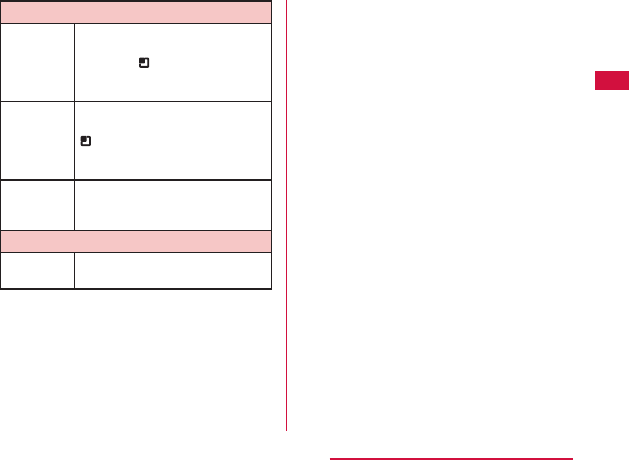
Dictionary
Japanese
User
Dictionary
Tap this to display the "Word List
in Japanese User Dictionary"
screen. Tap to register, edit or
delete words, or to delete the entire
Japanese User Dictionary.
English User
Dictionary
Tap this to display the "Word List in
English User Dictionary" screen. Tap
to register, edit or delete words,
or to delete the entire English User
Dictionary.
Clear
Learning
Dictionary
Delete all contents of the learning
dictionary.
About IME
iWnn IME Displays information about iWnn IME,
such as its version.
61
Confirmation and Settings before Using

docomo Palette UI
The docomo Palette UI is a home application that allows
you to quickly find and operate what you want such as
access to the Web and applications.
Viewing the Home Screen
You can customize the Home screen by adding or
moving shortcuts and widgets, and by changing the
wallpaper.
The Home screen has up to 12 screens each on the left
and right for adding shortcuts and widgets.
62
docomo Palette UI
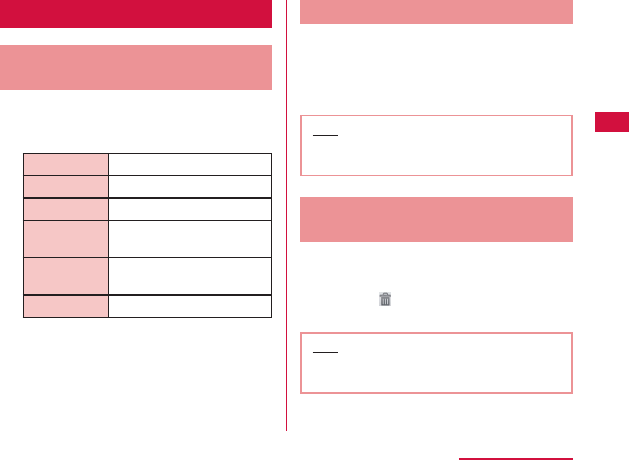
Home Screen Management
What You can Add to the Home
Screen
You can customize the Home screen.
a Touch the Home screen for over 1 second
• The "Add to home screen" list screen appears.
Shortcut You can create shortcuts.
Widget You can layout Widgets.
Folder You can create folders.
Kisekae You can select the background
and icon design.
Wallpaper You can choose the wallpaper
for the Home screen.
Group You can select from groups.
bTap the item you want to add/set.
• It is added/set to the Home screen.
Moving Shortcuts, etc.
a From the Home screen, touch the icon you
want to move for over 1 second
bDrag the icon and release your nger
• The icon is moved.
Note
• You can also drag the icon to one of the Home
screen's extended screens to the left or right.
Deleting Shortcuts, etc. from the
Home Screen
a From the Home screen, touch a shortcut
icon or widget for over 1 second
bDrag it to and release your nger
• The icon is deleted from the Home screen.
Note
• It is also possible to delete by tapping “Delete"
displayed in the balloon of Step 1.
63
docomo Palette UI
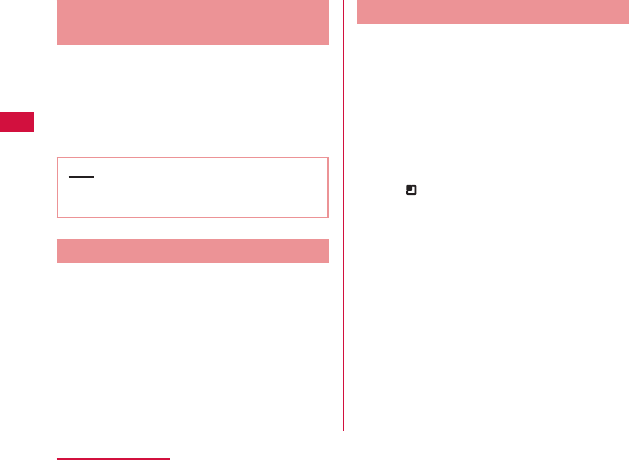
Uninstalling Applications and
Widgets
a From the Home screen, "Applications"
bTouch the application you want to delete for
over 1 second u "Uninstall"
c"OK"
• The application is deleted.
Note
• Applications installed in the terminal when
purchasing cannot be uninstalled.
Changing Folder Names
a From the Home screen, tap a folder you
want to change name
• The folder window opens.
bTouch the title bar for over 1 second
• The "Edit name" menu appears.
cEnter a new name of the folder and tap
"OK"
• The name of the folder is changed.
Changing Kisekae
Change the wallpaper and icon of the Home screen to
change the image.
a Touch the Home screen for over 1 second
• The "Add to home screen" list screen appears.
bTap "Kisekae", select a design, and tap
"Set"
• It is possible to select and set designs that you
like from a website.
• It is also possible to set from the Home screen
by u "Kisekae/Wallp" u "Kisekae".
64
docomo Palette UI

Changing Wallpaper
a Touch the Home screen for over 1 second
b"Wallpaper"
c"Gallery" / "Live wallpapers" / "Wallpaper
gallery"
• If you have tapped "Gallery", tap an image that
you want to use as wallpaper. Drag the square
displayed on the screen to select the section
that you want to use as wallpaper, and then tap
"Save".
• Live wallpaper list appears when tapping
"Live wallpapers". Tap to select one of the live
wallpaper, then tap "Set wallpaper". Depending
on the type of wallpaper, you can set the live
wallpaper settings by tapping "Settings...".
Adding Home Screens
You can add Home screens.
a From the Home screen, u "Home
screens"
• The "Home screens" screen appears.
• You can create up to 12 Home screens.
bTap one of the thumbnails with a "+" mark
• The "+" appears for screens that can be added.
Sorting Home Screens
You can sort the scroll order for Home screens.
a From the Home screen, u "Home
screens"
• The "Home screens" screen appears.
bTouch the thumbnail for over 1 second, and
drag it to the location where you want to
move it
65
docomo Palette UI
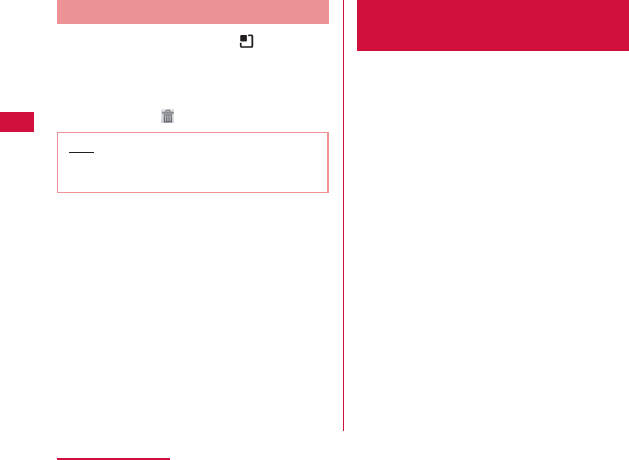
Deleting Home Screens
a From the Home screen, tap u "Home
screens"
• The "Home screens" screen appears.
bTouch the thumbnail for over 1 second,
drag it over to and release your nger
Note
• It is also possible to delete by tapping "Delete"
displayed in the balloon of Step 2.
Viewing the Application
Screen
a From the Home screen, "Applications"
Groups of applications are displayed as an icon
list.
66
docomo Palette UI
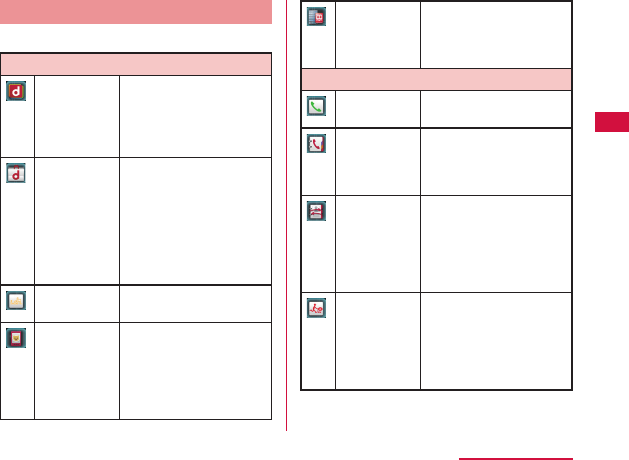
Application List
Some applications need to be applied separately (paid).
DOCOMO Services
dmenu This is a shortcut application
for "dmenu" to easily nd fun
and convenient contents
for smart phones including
contents used in i-mode.
dmarket This is the application
for starting dmarket.
From dmarket, you can
purchase contents such as
music, videos, and books.
Also, applications from
the Android market are
introduced.
iチャネル This is the application for
using i-Channel.
Machi-chara This is the application for
displaying characters on the
terminal screen. Characters
move on the Widget, and
noties information such as
incoming calls and email.
docomo
backup
This is the application for
backing up and restoring
data such as for the
phonebook.
Basic Functions
Phone Make or receive a call.
(P78)
Phonebook Register Phonebook, make a
call or send a message from
the registered phonebook.
(P85)
PhoneBookCopy
This is the application
for moving and copying
phonebook data using
external recording media
such as a microSD card.
(P89)
声の宅配便 This is the application
for easily using "Koe-no-
Takuhaibin" on a smart
phone. You can easily record
and play voice messages.
(P90)
67
docomo Palette UI
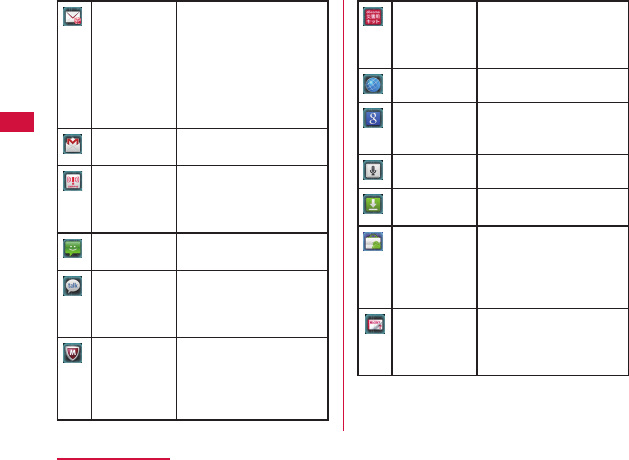
spモードメー
ル
This allows you to send
and receive emails using a
docomo email address
(@docomo.ne.jp). It allows
you to use pictograms
and Deco-mail, and also
supports auto receive.
(P122)
Gmail Send and receive Google
account emails. (P124)
Area Mail This is the application for
receiving and conrming
early warning "Area Mail".
(P125)
Messaging Available to send and
receive SMS. (P122)
Talk It allows you to chat (text
chatting) with friends who
have Google accounts.
(P129)
Anshin Scan This application is for
protecting the terminal from
viruses. It can detect viruses
in installed applications and
in the microSD card.
災害用キット This application is for
registering and conrming
messages on the disaster
message board.
Browser Browse web page. (P126)
Google Search Search for Phonebook,
application, web page, etc.
inside the terminal.
Voice Search Search by voice.
Downloads Conrm, display or play the
downloaded data. (P191)
Market Access applications and
games directly via Android
market to download and
install them to the terminal.
(P156)
Instruction
Manual
(Japanese)
Manual of this terminal.
Activate the function
you want to use from the
description.
68
docomo Palette UI
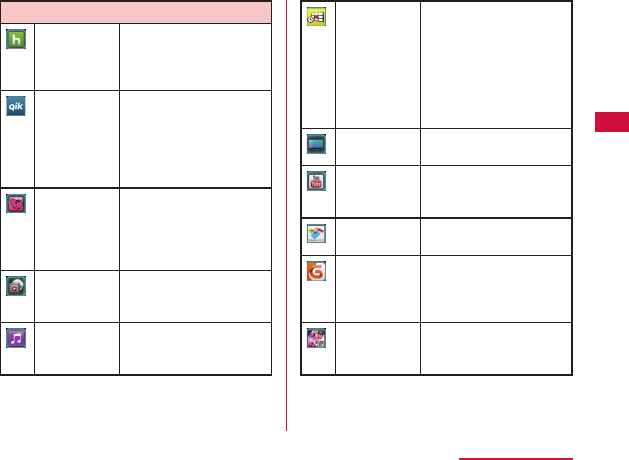
Entertainment
Hulu This is the application for
watching popular Hollywood
movies and overseas
dramas at a xed rate.
Qik Video This service is for
enjoying integrated video
communication for social
video sharing/video chat/
video mail/video archives
using one application.
JOOKEY This is for viewing
information variety programs
provided by celebrities and
experts, mainly Yoshimoto
entertainers.
Media Player This is the application for
playing music and videos.
(P148)
Music You can play songs from the
Songs, Albums, Artists, and
Playlists folders.
Gガイド
番組表
With this application you
can view program guides
for terrestrial digital, BS
digital, and other broadcast
services. You can search
for a program by keyword,
genre, etc., and schedule
watching 1Seg programs.
TV You can watch TV (1Seg).
(P169)
YouTube Play YouTube videos, and
upload the videos you have
shot to YouTube. (P187)
ビデオ
マーケット
You can enjoy various high-
quality video programs.
ジークラウド This application is for
enjoying games using the
cloud provided by NHN
Japan.
SF IV HD
Trailer
This is the application
for downloading STREET
FIGHTER IV HD.
69
docomo Palette UI
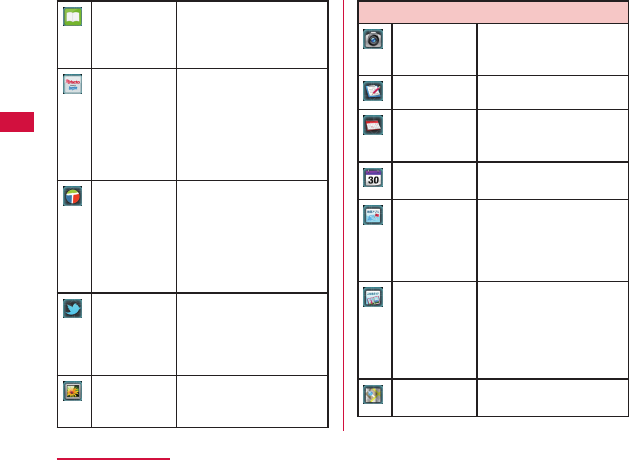
Book Store
MyShelf
This is the application for
viewing e-books that were
purchased through the
dmarket BOOK Store.
BOOKストア
2Dfacto
This is an electronic book
store where you can
purchase and browse a
variety of books such as
literary books, popular
comics, and famous
business books.
Twonky
Special
This is the application for
connecting terminals with
home electrical appliances.
Wirelessly play videos,
photos and music stored
in the terminal or on the
Internet via TV or audio.
Twitter This is the official Twitter
client application. You can
publish short messages on
site to communicate with
others.
Gallery A software to view still
images (photos) and videos.
(P146)
Tools
Camera A software for shooting still
images (photos) or videos.
(P141)
Memo Memo is available to use.
Schedule Memos can be registered
and schedule management
is possible.
Calendar View calendar and manage
schedule. (P183)
地図アプリ Supplies Maps, Shop
Search, Navigation, Transfer
and Visited places functions
to support you when you are
outdoors.
ご当地ガイド This is for introducing
information for
recommended locations
throughout Japan including
pictures and local foods to
help support walking tours.
Maps View current location, search
places or routes. (P160)
70
docomo Palette UI
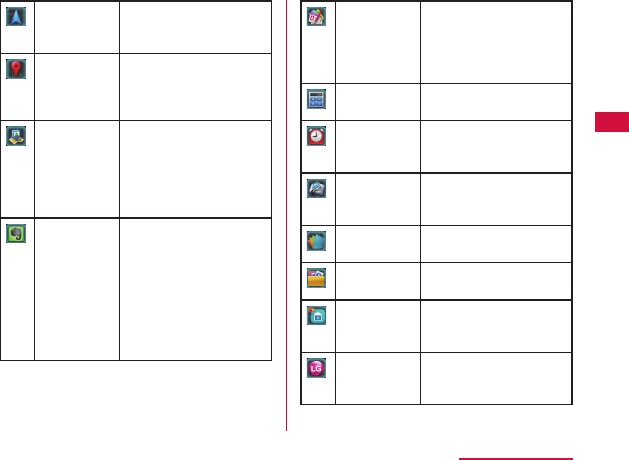
Navigation Voice guidance is available
to show the route to
destination. (P168)
Places Search for the nearest
restaurant, cafe, Japanese-
style bar, travel spot, ATM or
gas station. (P169)
Latitude Conrm your friend's
location and share status
message. It also enables you
to send emails and search
for a route to your friend's
location. (P167)
Evernote Save website content and
information such as the shot
images, the memos of ideas,
etc. to a server to search
or view when necessary.
The information can also be
saved or viewed from a PC
or other devices in addition
to this terminal.
Name card
creator
This is the application for
creating original name cards
that can be displayed to
your My prole box in the
"Phonebook" application.
Calculator Four arithmetic operations
are available. (P186)
Alarm Clock You can use the stopwatch,
and set the timer, world
clock, and alarms. (P181)
Dictionary Look for a word and register
the word to Wordbook.
(P189)
Polaris Office Read and edit various
document formats. (P187)
Application
Manager
This allows you to manage
application. (P191)
Link Backup Backup call log, calendar
(Schedule), etc. to microSD
card. (P192)
SmartWorld Enables to enjoy various
applications, dramas and
variety shows. (P186)
71
docomo Palette UI
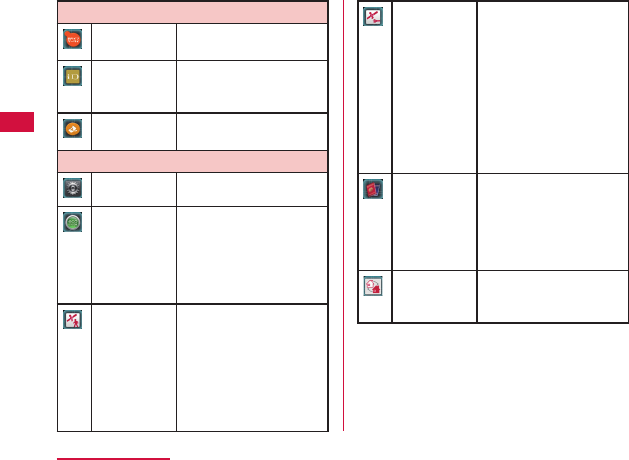
Osaifu/Shopping
Osaifu-Keitai You can set Osaifu-Keitai.
(P177)
iD設定アプリ This is the application for
setting e-money iD for using.
(P188)
ToruCa Acquire, display, search and
update ToruCa. (P180)
Settings
Settings Set various settings. (P100)
ecoモード This is the application
for setting "eco Mode"
for reducing battery
consumption by adjusting
various settings such as
screen brightness.
AUTO-GPS This application is for using
auto GPS compatible
services that notify
weather information, local
information such as shops,
and tourist information
according to your current
location.
docomo
location
information
This is the application
for providing location
information by imadoco
search, imadoco kantan
search, Keitai-Osagashi
Service, and emergency
information location
notications. You can also
change various settings
and access the setting site/
service site.
ドコモ海外
利用
This is the application for
supporting overseas packet
communication. You can
easily set data roaming and
carrier for using overseas
Pake-hodai.
Home
Switcher
This is the application
for switching the home
application.
72
docomo Palette UI

Note
• This is a list of the applications that have been
installed in this terminal at the time of purchase.
• If the software is updated, application content
and icon positions may change.
• The names of some applications may not be
fully displayed below their respective icons.
Manage Applications
Adding Shortcuts to the Home
Screen
a From the Home screen, "Applications"
bTouch the application icon for which you
want to create a shortcut for over 1 second,
and tap "Add"
The shortcut icon is added to the Home screen.
Uninstalling an Application
a From the Home screen, "Applications"
bTouch the application icon you want
to uninstall for over 1 second, and tap
"Uninstall"
cThe conrmation screen appears,
then tap "OK"
73
docomo Palette UI
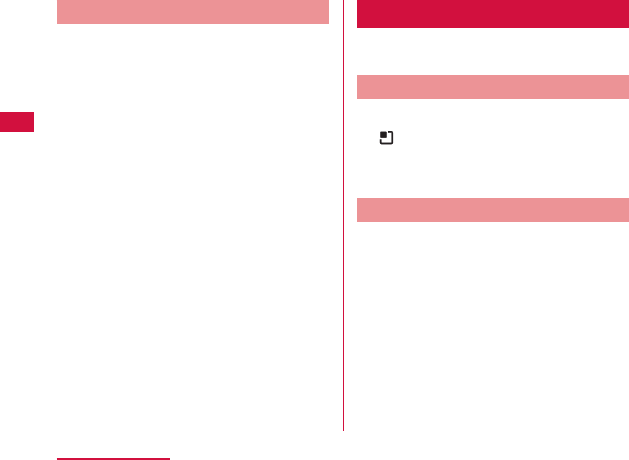
Moving Applications
a From the Home screen, "Applications"
bTouch the application you want to move for
over 1 second
cDrag the application and release your
nger
• The application is moved.
Group Management
Manage groups on the application screen and sort
icons.
Adding Groups
a From the Home screen, "Applications"
b u "Add group"
cEnter a group name and tap "OK"
• The group is added on the application screen.
Sorting Groups
a From the Home screen, "Applications"
bTouch the group name for over 1 second,
and drag it
• The group location is moved.
74
docomo Palette UI

Editing Group Names
a From the Home screen, "Applications"
bTouch the group name for over 1 second,
and tap "Edit name"
cEnter a new group name and tap "OK"
• The group name is changed.
Changing Group Colors
a From the Home screen, "Applications"
bTouch the group name for over 1 second,
and tap "Edit label"
• Select a color and tap.
Adding Groups to the Home
Screen
a From the Home screen, "Applications"
bTouch the group name for over 1 second,
and tap "Add"
• The group shortcut icon is added to the Home
screen.
Deleting Groups
a From the Home screen, "Applications"
bTouch the group name for over 1 second,
and tap "Delete"
c"OK"
• The group is deleted.
75
docomo Palette UI
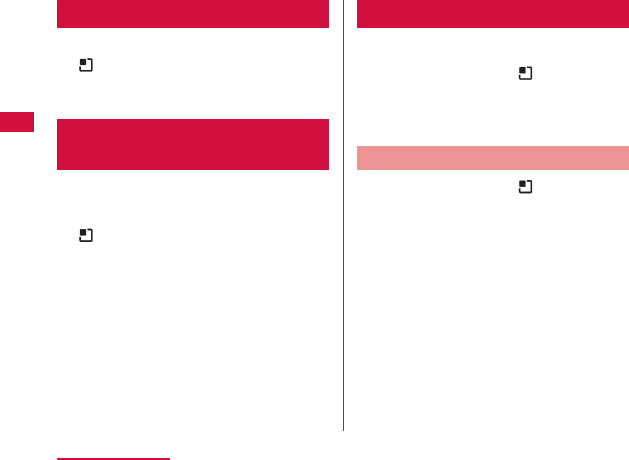
Searching Applications
a From the Home screen, "Applications"
b u "Search"
• The Search widget starts. Enter a keyword or
use Voice Input to search.
Switching Application
Screen Display
Select the display for the Application screen as Tile or
List.
a From the Home screen, "Applications"
b u "List format" / "Tile format"
Home Application Information
You can view the operation guide for the docomo Palette
UI.
a From the Home screen, u "More" u
"Help"
• An explanation for the docomo palette UI
operation is displayed.
Version Information
a From the Home screen, u "More" u
"Application info"
• The application name, provider, and version are
displayed.
76
docomo Palette UI
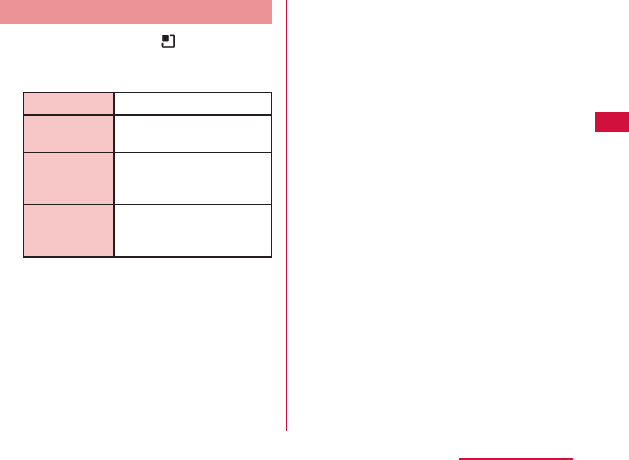
Home Application Settings
a From the Home screen, u "More" u
"Home settings"
• "Home settings" screen appears.
Personal area Personal area is displayed.
Wallpaper loop The wallpaper display is
looped.
Sync function Auto communication is
executed when personal area
information is updated.
International
roaming
Auto communication is
executed during international
roaming.
77
docomo Palette UI
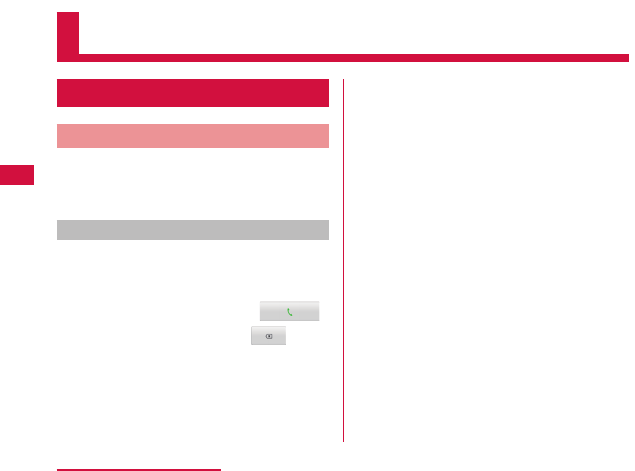
Calling / Network Services
Making/Receiving Calls
Making a Call
You can use the terminal to make international calls
and emergency calls, as well as standard calls. You can
also enter a pause when using phone services, such as
reserving tickets or checking your bank balance.
Making a call
a From the Home screen, "Phone" u
"Dial"
•The "Dial" tab appears.
bEnter the phone number u Tap
•If you enter a wrong number, tap to
delete the number.
a Tab
"Recent calls" tab (P83)
"Favorites" tab (P89)
"Dial" tab: Dial screen appears.
"Phonebook" tab (P85)
b Phone number entry box
The input phone number is displayed.
c Dial key
78
Calling / Network Services
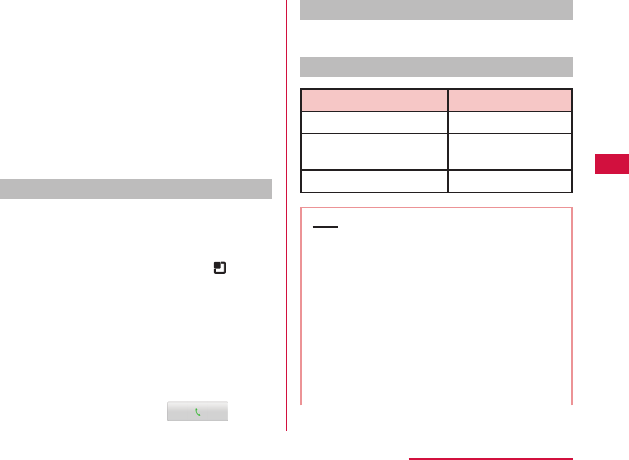
d Call button
e "Add to phonebook" button
The input phone number is registered to the
Phonebook.
f Edit button
The input text is deleted.
g "Koe-no-Takuhaibin" button
The Koe-no-Takuhaibin is sent to the input phone
number. (P90)
h "SMS" button
Create and send SMS. (P122)
Entering a pause
a From the Home screen, "Phone" u
"Dial"
•The "Dial" tab appears.
bEnter the phone number and tap u
"Add 2-sec pause"
•A comma "," is displayed after the phone
number.
•It is also possible to send a push signal
manually by touching "*" for over 1 second.
After ";" is entered next to the phone number, go
to Step 3.
cEnter the menu number of the service
that you are using u Tap
Ending a call
a During a call, "End"
Emergency call
Emergency call Phone number
Police 110
Fire department or
ambulance service
119
Japan Coast Guard 118
Note
•When you are making an emergency call (110,
119, and 118) from your terminal, be sure
to notify that you are calling from a mobile
phone and give your mobile phone number
and present location clearly, as the police/fire
department may call you back for confirmation.
During an emergency call, be sure to stay where
you are so that your call will not be interrupted.
After making an emergency call, do not turn
off your mobile phone immediately. Keep it on
for about 10 minutes so that it can receive an
incoming call.
79
Calling / Network Services

•Depending on the location from which you make
an emergency call, connection may be made
to the fire department or the police of another
jurisdiction.
•In Japan, the 110, 119, and 118 emergency
numbers cannot be dialed when UIM is not
inserted, from the PIN code input screen or from
the PIN unblocking key input screen. For details
on PIN code, refer to "Security Code and UIM
Protection" (P111).
Making an international call (WORLD CALL)
WORLD CALL is an international call service that
enables you to make a call in Japan via the DOCOMO
terminals.
Customers who have subscribed to the FOMA service
would also have automatically subscribed to "WORLD
CALL" at the same time. (However, you can decline to
use "WORLD CALL" when subscribing to the FOMA
services.)
•Available to make a call over 240 countries or areas.
You can make an overseas call to a fixed line
telephone or a mobile phone.
•For information about the possible countries and
carriers at overseas, refer to "Mobile Phone User's
Guide [International Services]" or the DOCOMO
"International Services website".
•The fee of WORLD CALL will be charged together
with FOMA service communication fee every month.
•Subscription fee and monthly fee will not be charged.
•Contact "General Inquiries" on the back of this
manual for detailed information about WORLD CALL.
•When using an international call service company
other than DOCOMO, consult with the international
call service company you use.
•Depending on the carrier, the caller's number may
not be notified or displayed correctly. In that case,
making a call from call log is not available.
Calls to fixed-line telephone
a From the Home screen, "Phone" u
"Dial"
•The "Dial" tab appears.
bEnter "010" u Country code u Area
code u Recipient's phone number, and
tap
80
Calling / Network Services
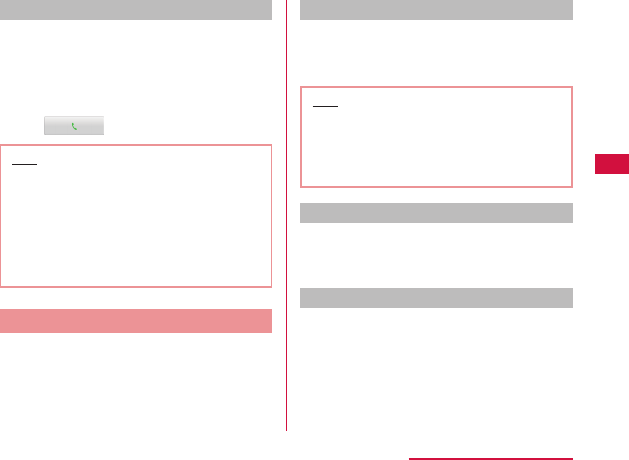
Calls to mobile phone
a From the Home screen, "Phone" u
"Dial"
•The "Dial" tab appears.
bEnter "010" u Country code u
Recipient's mobile phone number, and
tap
Note
•If a recipient's mobile phone number or an area
code begins with "0", omit "0". However, "0" may
be required when calling some countries or
areas, such as Italy.
•"+" (touch "0" for over 1 second to input "+") or
"009130-010" can also be used instead of "010".
•For details on WORLD CALL, refer to DOCOMO
"International Services website".
Receiving a Call
The terminal plays a ringtone when there is an incoming
call. In Silent mode, the ringtone does not sound. If the
terminal has been set to vibrate, it vibrates when there
is an incoming call.
Receiving a call
a When an incoming call arrives, tap
"Activate" u "Accept"
•You can talk to the caller.
Note
•If the caller has been saved in Contacts
(Phonebook), the caller's name and phone
number are displayed. If the caller is not saved
in Contacts (Phonebook), only the phone
number is displayed.
Declining a call
a When an incoming call arrives, tap
"Activate" u "Reject"
•The incoming call is declined.
Muting ringtone
a Press the Volume key (upper)/Volume
key (lower) while an incoming call
ringing
•The ringtone is muted.
81
Calling / Network Services
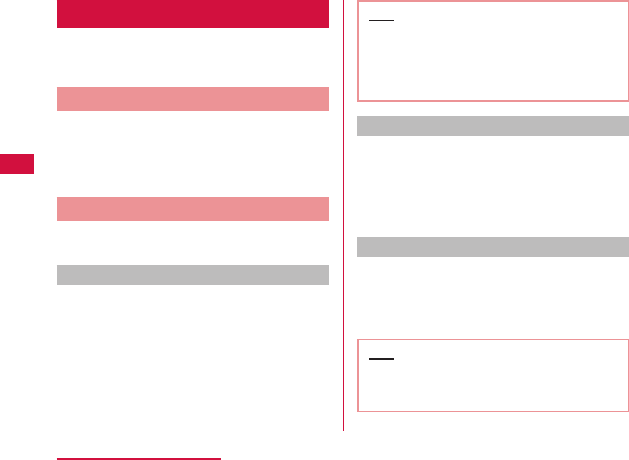
Operations during a Call
During a call, you can adjust the volume, turn the
speaker ON/OFF, mute the microphone, and put the call
on hold, depending on the usage conditions.
Adjusting Call Volume
During a call, you can adjust the reception volume.
a Press Volume key (upper)/Volume key
(lower)
•The call volume changes accordingly.
Using Call Options
During a call, you can put the caller onto speaker or
temporarily mute the microphone.
Turning the speaker ON/OFF
a During a call, "Speaker"
•You can hear the caller's voice through the
speaker.
bWith the speaker ON, "Speaker"
•You can no longer hear the caller's voice
through the speaker.
Note
•Do not hold the terminal against your ear with
the speaker ON.
•Speak into the terminal from a distance of no
more than 50 cm. If you find it difficult to hear
what is being said, turn off the speaker.
Muting the microphone
a During a call, "Mute"
•The caller can no longer hear what you are
saying.
bWith the microphone OFF, "Mute"
•The caller can hear what you are saying again.
Putting the call on hold
a During a call, "Hold"
•The call is put on hold.
bIn the hold state, "Unhold"
•Hold is canceled, and you can resume the call.
Note
•To use the function for putting a call on hold, a
subscription to Call Waiting Service (P95) is
required.
82
Calling / Network Services

Call Log
This automatically records a history of your incoming
and outgoing calls. You can also use the call log to call a
phone number or add it to Phonebook.
a The names of the recipient and caller are displayed.
b A call is made.
c Log icons are displayed.
: Dialed calls log
: Received calls log
: Missed calls log
: International call log
d Call icon
: Call icon without caller ID notification
: Call icon other than without caller ID notification
e Logs with the same person are displayed together as
. The number in parentheses shows the number of
logs.
Calling to Answer a Missed Call
When you have missed calls, a missed call notification
appears in the status bar.
a If you see in the status bar, drag or
swipe the status bar downwards
•The missed call notification appears in the
Notification panel. The missed call notification
displays the caller's phone number or the
caller's name that is saved in Phonebook, and
the time or date of the missed call.
bTap the missed call notification
•The "Incoming history" tab appears.
•For the missed call log, is displayed.
cTap on the right of the missed call log
•The call is made.
83
Calling / Network Services

Calling a Number from the Call Log
You can make calls to the phone numbers stored in the
call log.
a From the Home screen, "Phone" u
"Recent calls" tab
•"Incoming history" and "Outgoing history"
appear.
bTap on the right of the other party's
name or phone number
•The call is made.
Note
•You can make a call by tapping the name or
phone number on the "Recent calls" tab and
then "Call".
•You can also make a call by touching the name
or phone number on the "Recent calls" tab for
over 1 second and then tapping "Call ×××-×××-
×××××" in the menu that appears.
Registering Phone Numbers from
the Call Log to the Phonebook
You can register unregistered items from the call log to
the Phonebook.
a On the "Recent calls" tab, tap a phone
number
b"Add to phonebook"
•The "Register/Update phonebook" screen
appears.
c"Register new"
•When multiple accounts have been registered,
select the account for which you want to create
a phonebook.
dEnter information, and tap "Save"
•It is registered as a Phonebook.
Note
•It is also possible to register to the Phonebook
by touching the phone number that you want
to register for over 1 second on the "Recent
calls" tab and tapping "Add to phonebook" u
"Register new".
84
Calling / Network Services
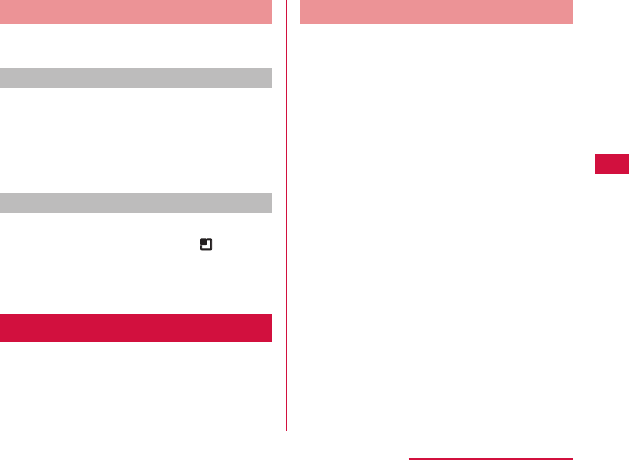
Deleting the Call Log
The call log is automatically added. However, you can
delete a call log or all call logs.
Deleting a desired call log
a On the "Recent calls" tab, touch a phone
number for over 1 second
•A menu appears.
b"Remove from call log" u "OK"
•The call log is deleted.
Deleting the entire call log
a On the "Recent calls" tab, "Incoming
history" / "Outgoing history" u u
"Delete all" u "OK"
•The entire "Incoming history"/"Outgoing history"
call log is deleted.
Phonebook
In Phonebook, you can enter information about your
personal contacts, such as their phone numbers, email
addresses and web service accounts.
Displaying the Phonebook
You can view all the information that is saved in
Phonebook.
a From the Home screen, "Phone" u
"Phonebook" tab
•The Phonebook appears.
85
Calling / Network Services

a The Phonebook (profile) is displayed.
b Call log is displayed. You can also confirm the sent/
received details for sp-mode mail and SMS.
c Your profile (My profile) is displayed.
d Tap the icon that is displayed by selecting the image
to make a call, create an email, or use various
services on the internet.
e Phonebook belonging to the selected group are
displayed.
f A new phonebook is registered.
g Enter a keyword and search Phonebook.
Note
•When you open Phonebook for the first time,
descriptions for adding Phonebook are
displayed. Tap u "Others" u "Import/Export"
to import or export contacts from your UIM or
microSD card.
Registering Phonebook
You can register a new phonebook.
a On the "Phonebook" tab, "Register"
•When multiple accounts are registered, select
the account for which you want to create a
phonebook.
bEnter information, and tap "Save"
•The entered information is added to Phonebook.
Editing Phonebook
You can edit a phonebook that has already been
registered.
a On the "Phonebook" tab, tap a
phonebook that you want to edit
•The Profile screen appears.
b"Edit"
•The "Edit profile" screen containing previously
entered information appears.
cAdd, delete or edit the information, and
tap "Save"
•The Phonebook is updated.
86
Calling / Network Services
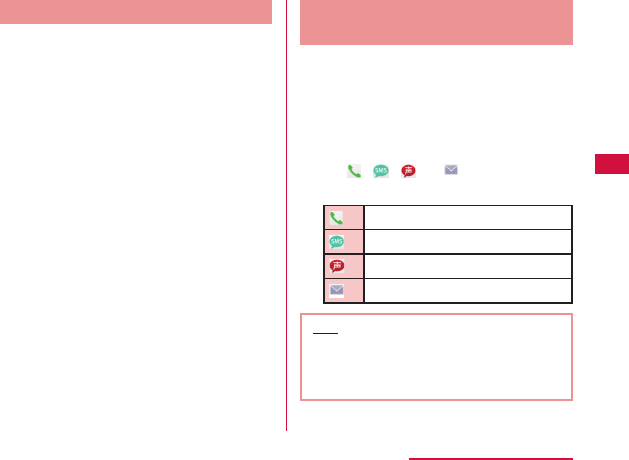
Searching the Phonebook
You can search for a phonebook on the "Phonebook"
tab by dragging in the tab or by text entry.
a On the "Phonebook" tab, "Search"
bEnter the word(s) that you are looking
for
•Search candidates and search results in the
terminal are displayed.
cTap a phonebook
•The Phonebook menu appears.
Making Calls/Sending Emails/
Chatting via Phonebook
You can make a call directly from Phonebook. If you
have added an email address or chat account to the
phonebook entry, you can also send an email or launch
a chat application.
a On the "Phonebook" tab, tap one of the
Phonebook contacts
•The Profile information is displayed.
bTap , , , or
•You can now make a call, send an email or chat.
Make a call.
Send an SMS message.
Record Koe-no-Takuhaibin
Send an email.
Note
•Touch the Phonebook for over 1 second to
display the option menu. You can now make a
call if you tap "Phone", or send an SMS message
if you tap "SMS".
87
Calling / Network Services
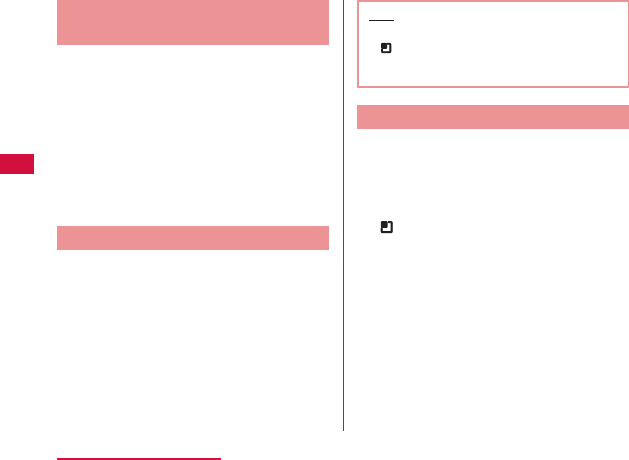
Viewing the Map of a Contact's
Address
If the address has been added to the Phonebook, you
can view its location in a map.
a On the "Phonebook" tab, tap one of the
Phonebook contacts
•The phonebook information appears.
bOn the "Profile" tab, touch the address
for over 1 second u "Display map"
•When selecting "Maps" or "地図アプリ", it
switches to the application to display the
location set as the address.
Deleting Phonebook
a On the "Phonebook" tab, touch one
of the Phonebook contacts for over 1
second
•The phonebook information appears.
b"Delete" u "OK"
•The phonebook is deleted.
Note
•You can also delete a phonebook by tapping
u "Delete" on the "Phonebook" tab, placing a
mark on the phonebook you want to delete, and
tapping "Delete".
Sharing Phonebook
You can share the phonebook saved in the terminal with
other applications.
a On the "Phonebook" tab, tap one of the
Phonebook contacts
•The phonebook information appears.
b u "Share"
•A menu listing the applications that the contact
can be shared with appears.
cTap one of the applications
•The screen of the selected application appears.
Follow the instructions on the screen.
88
Calling / Network Services
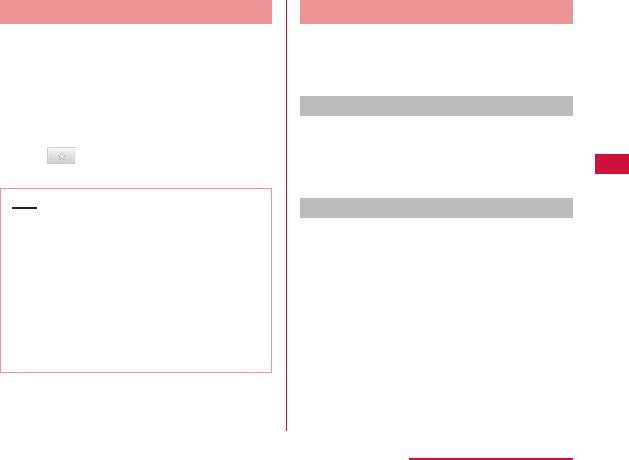
Adding a Phonebook to Favorites
When you add a phonebook to Favorites, it appears on
the "Favorites" tab. The "Favorites" tab allows you to
quickly display a specific Phonebook.
a On the "Phonebook" tab, tap the
phonebook that you want to add to
Favorites
•The Profile screen appears.
bTap
•The phonebook is added to the "Favorites" tab.
Note
•When you display a phonebook that has been
added to Favorites, the star icon in the top right-
hand corner of the screen turns yellow.
•If you tap the yellow star icon, it turns gray.
- If the phonebook has a call log, the
phonebook is displayed in the "Favorites" tab.
- If the phonebook has no call log, the
phonebook is undisplayed in the "Favorites"
tab.
•If you tap a gray star icon, it turns yellow and
the phonebook is displayed in "Favorites".
Using Phonebook Copy Tool
Copy Phonebook data between this terminal and other
terminals via microSD card. Also, you can copy the
Phonebook data stored in your Google account to your
docomo account.
Opening the Phonebook copy tool
a From the Home screen, "Applications"
u "PhoneBookCopy"
•For the first time users, to accept the "使用許諾
契約書" (License agreement) is required.
Exporting Phonebook to microSD card
a Insert a microSD card to the terminal
bFrom "エクスポート" (Export) tab screen,
"開始" (Start)
•Phonebook data stored in docomo account is
saved on microSD card.
c"OK"
89
Calling / Network Services

Importing Phonebook from microSD card
a Insert the microSD card on which your
Phonebook data is saved to the terminal
bFrom "インポート" (Import) tab screen,
tap a file to import u "上書き"
(Overwrite) / "追加" (Add)
•The imported Phonebook data is saved to
docomo account.
c"OK"
Copying Contacts on Google account to
docomo account
a From "docomoアカウントへコピー "
(Copy to docomo account) tab screen,
tap the Google account you want to
copy u "上書き" (Overwrite) / "追加"
(Add)
•The copied Phonebook data is saved on
docomo account.
b"OK"
Note
•When the items of Phonebook (number, etc.) in
other terminals are different from those in this
terminal, the item names may be changed or
deleted. The characters may be deleted when
they are not registerable on some terminals.
•It is not available to import group information.
•When exporting Contacts (Phonebook) to
microSD card, Phonebook data with no name
registered is not available to copy.
•When importing Contacts (Phonebook) from
microSD card, the file created in the "Link
Backup" application cannot be read.
Koe-no-Takuhaibin
This service is for sending voice messages via phone.
•For details about Koe-no-Takuhaibin, refer to the
DOCOMO website.
•The message can be recorded up to 15 minutes
per 1 message, up to 500 messages, and stored
up to 720 hours. A maximum of 5 messages can
be protected, and will automatically be deleted 720
hours after protection cancellation.
90
Calling / Network Services
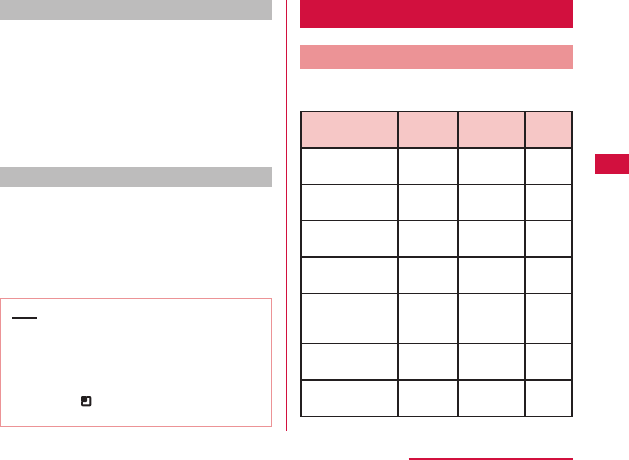
Message recording
a From the Home screen, "Phone" u "Dial"
bEnter the phone number u Tap
"Koe-no-Takuhaibin"
•The terminal is connected to the Koe-no-
Takuhaibin Service Center. Record a message
according to the voice guidance.
•You can also send it from the "Recent calls" and
Phonebook.
Play messages
The message is recorded and is notified by SMS.
a From the Notification panel, tap the Koe-
no-Takuhaibin notification u "メッセー
ジ再生" (Play Message) u "はい " (Yes)
•The terminal is connected to the Koe-no-
Takuhaibin Service Center.
Note
•A call fee will be charged for recording and
playing messages.
•Koe-no-Takuhaibin cannot be used from
overseas.
•To set Koe-no-Takuhaibin, from the Home
screen, tap u "Settings" u "Call settings" u
"Network service" u "Koe-no-Takuhaibin".
Network Services
Available Network Service
You can use the following DOCOMO network services
on the terminal.
Service name Monthly
charge Application Page
Koe-no-
Takuhaibin
Free Not
required
P90
Voice Mail
Service
Paid Required P92
Call Forwarding
Service
Free Required P96
Call Waiting
Service
Paid Required P95
Caller ID
Notification
Service
Free Not
required
P98
Nuisance Call
Blocking Service
Free Not
required
P106
Caller ID Display
Request Service
Free Not
required
P106
91
Calling / Network Services
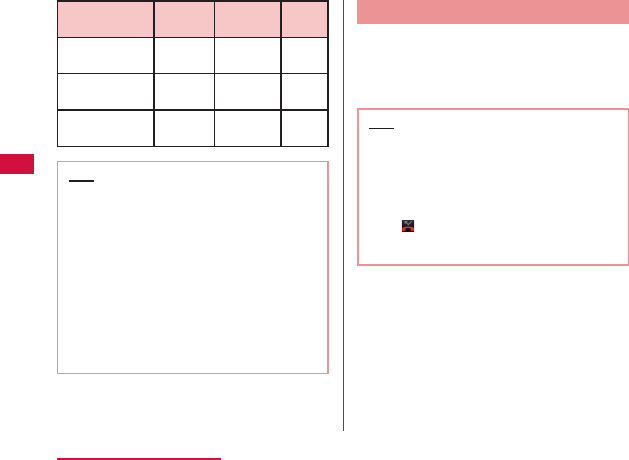
Service name Monthly
charge Application Page
Call Notification
Service
Free Not
required
P106
English
Guidance
Free Not
required
P106
Public Mode
(Power OFF)
Free Not
required
P99
Note
•You cannot use the network services when you
are outside of the service area or in a location
with no radio reception.
•Deactivating a service does not mean canceling
the contract of a service like the Voice Mail
Service or the Call Forwarding Service.
•For subscriptions and inquiries, contact
"General Inquiries" provided on the last page of
this manual.
•In this manual, the outlines of each network
service are described with menu operations of
the terminal. For details, refer to "Mobile Phone
User's Guide [Network Services]".
Voice Mail Service
If you are in a location with no radio reception, the
terminal is powered off, or you are unable to take the
call within the preset ring time, the Voice Mail Service
answers a call with a voice mail greeting and records
the caller's message.
Note
•The message can be recorded up to 3 minutes
per 1 message, up to 20 messages, and stored
up to 72 hours.
•If you do not answer an incoming call when the
Voice Mail Service is set to "Activate", the call
is saved in "Incoming history" as a missed call,
and appears in the status bar.
•This terminal does not record voice messages
on internal memory. Use the Voice Mail Service.
92
Calling / Network Services
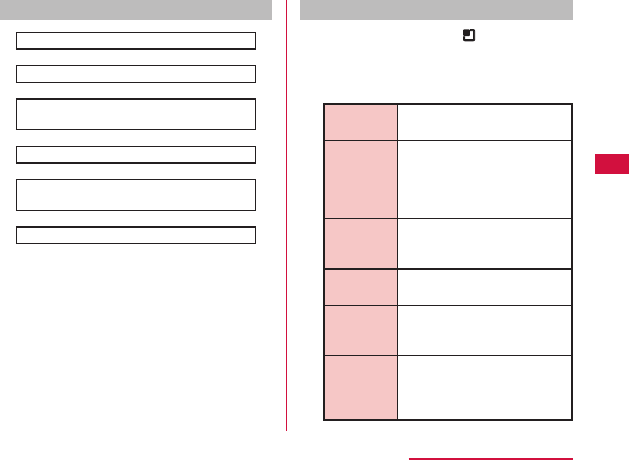
Basic flow of the Voice Mail Service
Start the Voice Mail Service.
▼
A call is made to your terminal.
▼
If you do not answer the call, a connection is
made to the Voice Mail Service Center.
▼
A caller records a message.
▼
You are notified of the message at the Voice
Mail Service Center.
▼
Play the voice message.
Setting the Voice Mail Service
a From the Home screen, u "Settings"
u "Call settings" u "Network service" u
"Voice mail service"
•The "Voice mail service" screen appears.
Activate
service
Tap "OK" to start the Voice Mail
Service.
Ring time
setting
Enter 0 to 120 (seconds) for the
ring time.
If the ring time is set to "0", calls
will not be saved in Incoming
history.
Deactivate
service
Tapping "OK" when setting the
Voice Mail Service deactivates
the Voice Mail Service.
Settings
confirmation
Display the setting state of the
Voice Mail Service.
Play
messages
Tap "OK" to connect to the Voice
Mail Service Center. Follow the
guidance to play messages.
Settings Tap "OK" to connect to the Voice
Mail Service Center. Follow the
guidance to change the Voice
Mail settings.
93
Calling / Network Services
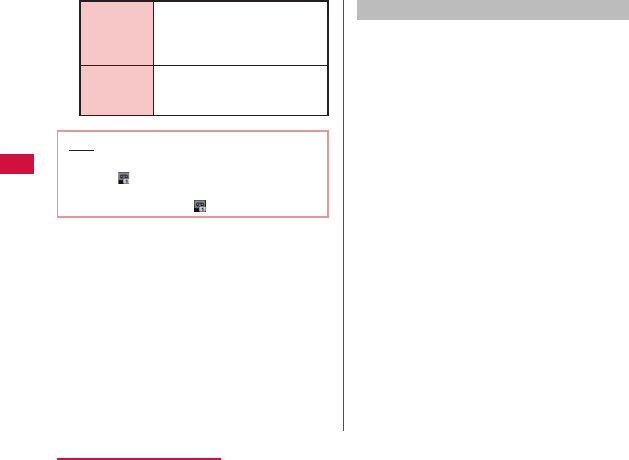
Checking
messages
Check whether there is a new
Voice Mail message. After
checking, the completion
message appears.
Message
notification
settings
Configure the setting for whether
to notify when new messages
arrive.
Note
•If you have messages at the Voice Mail Service
Center, appears in the status bar. Once
all messages have been cleared or stored,
following the guidance, will disappear.
Playing a voice message
a Drag or swipe the status bar downwards
•The Notification panel appears.
b"Voice mail" u "OK"
•The terminal is connected to the Voice Mail
Service Center. Follow the guidance to play
messages.
94
Calling / Network Services
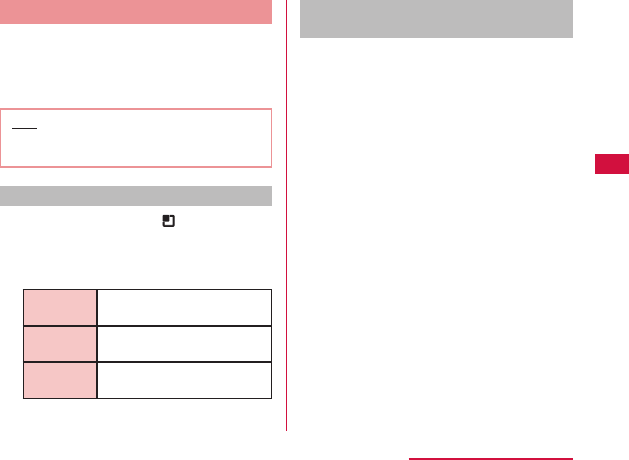
Call Waiting Service
When there is another incoming call while you are on a
call, the in-call ringtone notifies you of the second call.
You can answer the second call by putting the first call
on hold. You can also put your current call on hold and
make a call to another party.
Note
•Even when the call is on hold, the caller is
charged for a call fee.
Setting the Call Waiting Service
a From the Home screen, u "Settings"
u "Call settings" u "Network service" u
"Call waiting"
•The "Call waiting" screen appears.
Activate
service
Tap "OK" to start the Call Waiting
Service.
Deactivate
service
Tap "OK" to deactivate the Call
Waiting Service.
Settings
confirmation
The current settings are
displayed.
Putting the current call on hold and
answering an incoming call
a If you hear a beep during a call,
"Activate" u "Accept"
•The first call is automatically put on hold and the
incoming call is answered.
bSwitch to the first call
•To end the second call, tap "End". The second
call is terminated and you return to the first call.
•To put the second call on hold, tap "Swap". The
second call is put on hold and you return to the
first call. Tapping "Swap" switches to the other
party.
95
Calling / Network Services
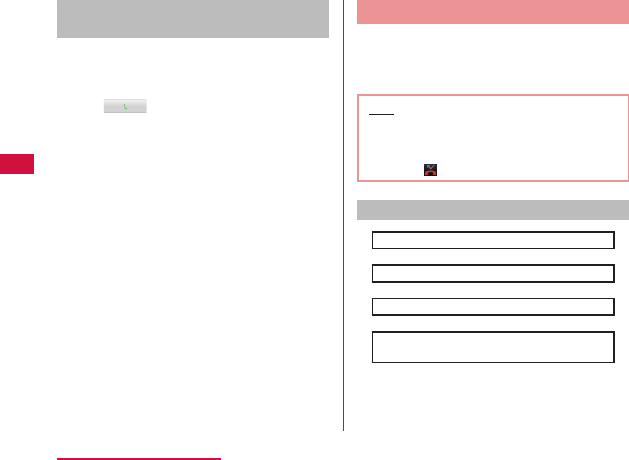
Putting the current call on hold and
making a call to another party
a During a call, "Add call"
•The "Dial" tab appears.
bEnter the other party's phone number
u
Tap
•The first call is automatically put on hold and
you are put through to the new call. You can
also search for a phonebook if you tap the
"Phonebook" tab or "Recent calls" tab.
cSwitch to the first call
•To terminate the new call, tap "End". The new
call is terminated and you return to the first call.
•To put the new call on hold, tap "Swap". The new
call is put on hold and you return to the first call.
Tapping "Swap" switches to the other party.
Call Forwarding Service
The Call Forwarding Service forwards a call to a preset
forwarding number if you do not answer the call within
the preset ring time, or are outside of the service area
or if the terminal is powered off.
Note
•If you do not answer an incoming call when the
Call Forwarding Service is set to "Activate", the
call is saved in "Incoming history" as a missed
call, and appears in the status bar.
Basic flow of the Call Forwarding Service
Register the forwarding number.
▼
Set the Call Forwarding Service to activate.
▼
A call is made to your terminal.
▼
If you do not answer a call, it is automatically
forwarded to the specified forwarding number.
96
Calling / Network Services
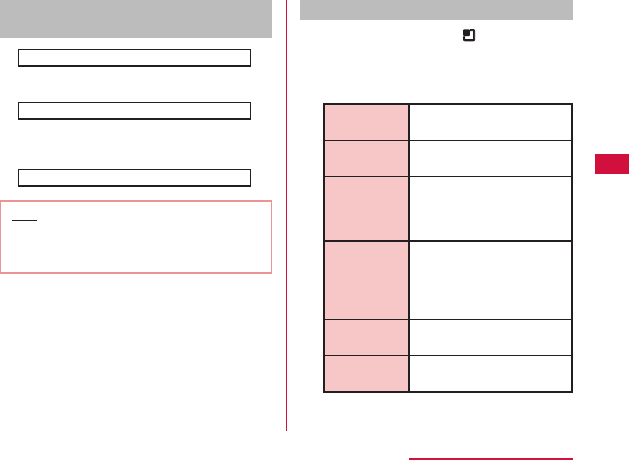
Call charge for the Call Forwarding
Service
Caller
▼Call charges are incurred by
the caller.
Subscriber to the Call Forwarding Service
▼
Call charges are incurred
by the subscriber to the Call
Forwarding Service.
Forwarding number
Note
•Even when the Call Forwarding Service is
active, you can answer a call while the ringtone
sounds.
Setting the Call Forwarding Service
a From the Home screen, u "Settings"
u "Call settings" u "Network service" u
"Call forwarding service"
•The "Call forwarding service" screen appears.
Activate
service
Change the forwarding
number and the ringing time.
Deactivate
service
Tap "OK" to deactivate the Call
Forwarding Service.
Change call
forwarding
number
Enter a new forwarding
number and tap "OK" to
change the forwarding
number.
Call forwarding
settings
Tap "Yes" to automatically
connect an incoming call to
the Voice Mail Service Center
if the forwarding number is
busy*.
Guidance
settings
Turn the guidance ON/OFF.
Settings
confirmation
The current Call Forwarding
Service settings are displayed.
* A subscription to the Voice Mail Service is
required.
97
Calling / Network Services
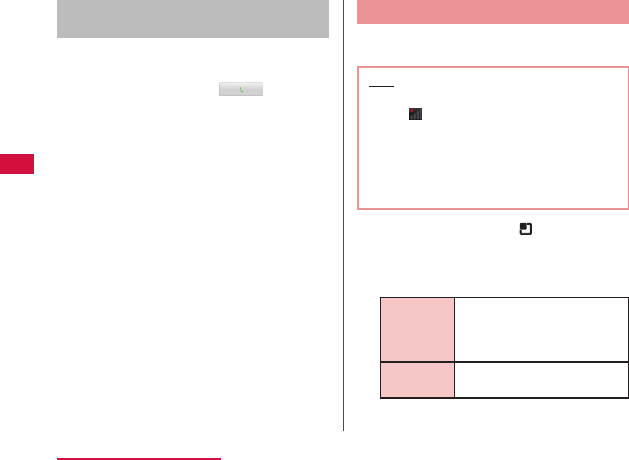
Setting the Call Forwarding guidance
on/off
a From the Home screen, "Phone"u "Dial"
•The "Dial" tab appears.
b"1" u "4" u "2" u "9" u
•Voice guidance is played. Follow the guidance
to configure the settings. For details, refer to
"Mobile Phone User's Guide [Network Services]".
Caller ID Notification Service
When making a call, your phone number can be shown
in the display of the other party's phone.
Note
•The Caller ID Notification Service is not available
when (out of service area) is displayed.
•The service is only available when the other
party's phone can display the caller ID.
•If an announcement requesting caller ID is
heard when making a call, activate Caller ID
Notification or add the "186" prefix to the phone
number and call again.
a From the Home screen, u "Settings"
u "Call settings" u "Network service" u
"Caller ID notification"
•The "Caller ID notification" screen appears.
Settings Set whether the other party is
notified of your caller ID. Tap
"Notify" to enable notification, and
"Not notify" to disable notification.
Settings
confirmation
The current Caller ID Notification
settings are displayed.
98
Calling / Network Services
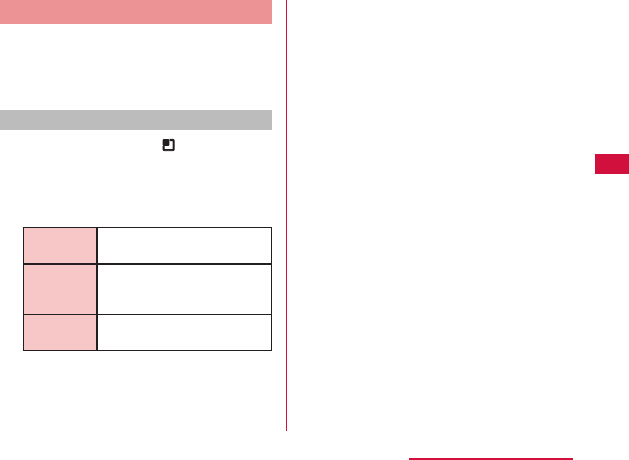
Public Mode (Power OFF)
When you receive at a public location where you want to
refrain from using or while driving, guidance is provided
to callers. Public mode (Power OFF) guidance is also
played when you are outside of the service area or
when there is no signal.
Public mode (Power OFF) settings
a From the Home screen, u "Settings"
u "Call settings" u "Network service" u
"Public mode (power OFF) settings"
•The "Public mode (power OFF) settings" screen
appears.
Activate
service
Tap "OK" to activate Public mode
(Power OFF).
Deactivate
service
When Public mode (Power OFF)
is set, tap "OK" to deactivate the
service.
Settings
confirmation
The current settings are
displayed.
99
Calling / Network Services
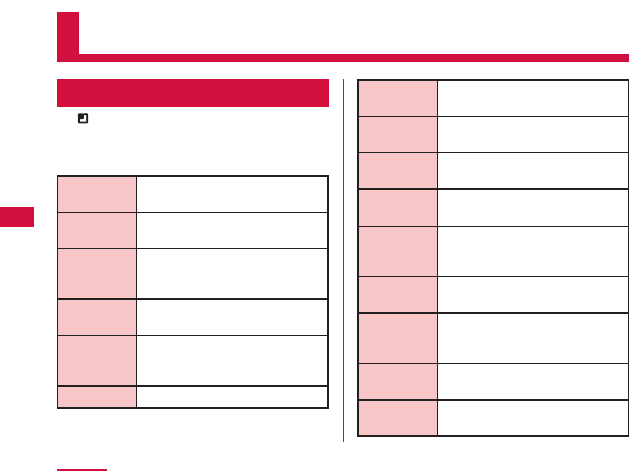
Settings
Settings Menu
Tap u "Settings" on the Home screen on the terminal
to display the "Settings" screen that allows you to
configure various settings. The menu displayed on this
screen is shown below.
Wireless &
networks
Configure various network settings.
(P101)
Call settings Configure various call settings.
(P106)
docomo
service
Settings for application management,
docomo apps password, and auto
GPS are configured. (P107)
Sound Configure settings, such as volume.
(P108)
Display Configure display settings, such as
screen brightness and animation.
(P109)
Gesture Set motion gesture settings. (P109)
Location &
security
Configure settings such as GPS,
screen lock and passwords. (P110)
Applications Configure applications' settings.
(P115)
Accounts &
sync
Configure settings for accounts and
synchronization. (P115)
Privacy Delete all data from the terminal.
(P116)
Storage Display free space of the microSD
card, mount, format and free space
in internal storage. (P116)
Language &
keyboard
Configure the terminal's language
and keyboard settings. (P117)
Voice input &
output
Configure the settings for voice
recognizer and reading of text.
(P117)
Accessibility Set the settings of accessibility
application. (P117)
Connectivity
settings
Set the USB connection mode and
On-Screen Phone function. (P118)
100
Settings
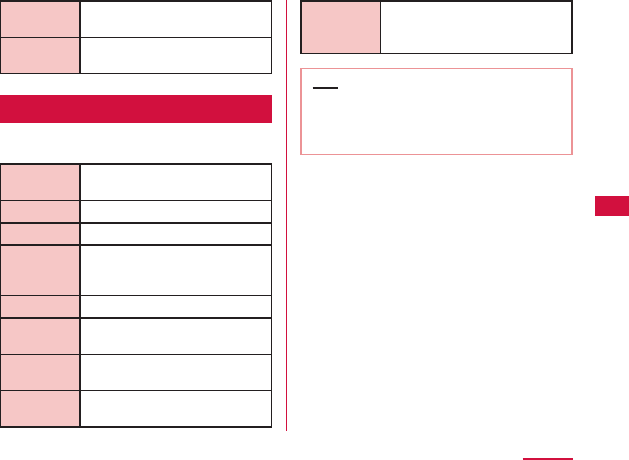
Date & time Configure the date and time settings.
(P120)
About phone Display information related to this
terminal. (P120)
Wireless & Networks
Set whether to enable/disable networks and configure
the network connection settings.
Airplane
mode
Enable/disable the terminal's
emission of radio waves.
Wi-Fi Turn the Wi-Fi function ON/OFF.
Wi-Fi settings Configure Wi-Fi settings.
Wi-Fi Direct
settings
Connect to Wi-Fi Direct compatible
devices directly without an access
point.
Bluetooth Turn the Bluetooth function ON/OFF.
Bluetooth
settings
Configure Bluetooth settings.
Portable
hotspot
Configure portable Wi-Fi access
point settings.
VPN settings Configure the settings for VPN (virtual
private network) communications.
Mobile
networks
Set an access point and configure
data roaming and network mode
settings.
Note
•When searching LTE using "Network operators"
from "Mobile networks", execute "Search
networks" after placing a check mark next to
"Data enabled".
101
Settings
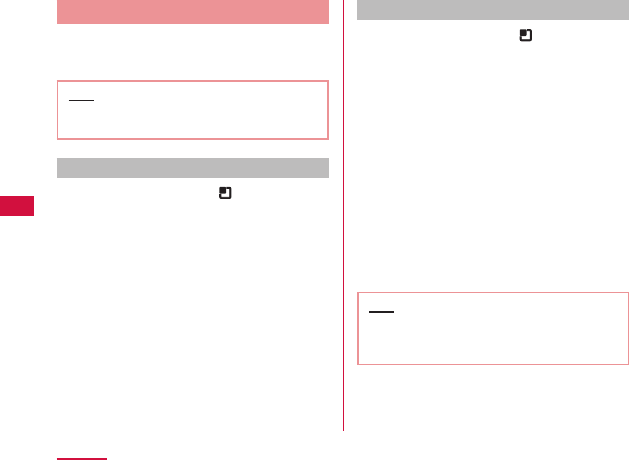
Wi-Fi Tethering Settings
Connect wireless LAN compatible device up to eight
devices to the Internet simultaneously using the terminal
as a Wi-Fi hotspot.
Note
•Wi-Fi tethering and USB tethering cannot both
be used at the same time.
Activating Wi-Fi tethering
a From the Home screen, u "Settings"
u "Wireless & networks" u "Portable
hotspot"
b"Portable Wi-Fi hotspot"
•Confirm the details of the warning and then tap
"OK".
•When activating for the first time, a dialog for
entering a new password appears. Enter a new
password, and then tap "Save".
Setting Wi-Fi access point
a From the Home screen, u "Settings"
u "Wireless & networks" u "Portable
hotspot"
b"Portable Wi-Fi hotspot settings"
c"Configure Wi-Fi hotspot"
•
"Configure Wi-Fi hotspot" menu appears.
dEnter network SSID in the "Network
SSID" box
e"Security"
•"S
ecurity" menu appears. Select appropriate one
from "Open" and "WPA2 PSK".
•
The password entry is necessary if "Se
curity" is set
to "WPA2 PSK".
f"Save"
Note
•Network SSID is set to "AndroidAP", and security
is set to "WPA2 PSK" by default. Set Security as
needed.
102
Settings

Connecting to VPN (Virtual
Private Network)
VPN (Virtual Private Network) is a technique to access
to the information protected in local network from other
networks. VPN is generally equipped in companies,
schools or other facilities. Users can access the local
network and view information outside the premise.
To set VPN access from the terminal, security
information from network administrator is required.
Adding a VPN
a From the Home screen, u "Settings"
u "Wireless & networks" u "VPN
settings"
b"Add VPN"
cTap a VPN type to add
•PPTP is unavailable when ISP is set to sp-mode.
dTap "VPN name" u Enter a VPN name u
Tap "OK"
eTap "Set VPN server" u Enter the
settings of VPN server u Tap "OK"
fEnter other necessary items
g u "Save"
Connecting to a VPN
a In VPN list, tap a VPN name to connect
•A menu appears.
bTap "Username" u Enter a user name
cTap "Password" u Enter a password
d"Connect"
•You can also connect to a VPN by touching a
VPN name to connect for over 1 second and
tapping "Connect to network".
Editing a VPN
a In VPN list, touch a VPN name to edit for
over 1 second
•A menu appears.
b"Edit network"
•The detailed setting screen is displayed with the
registered information entered.
cAdd, delete or edit the information, and
tap u "Save"
•The settings are updated.
103
Settings
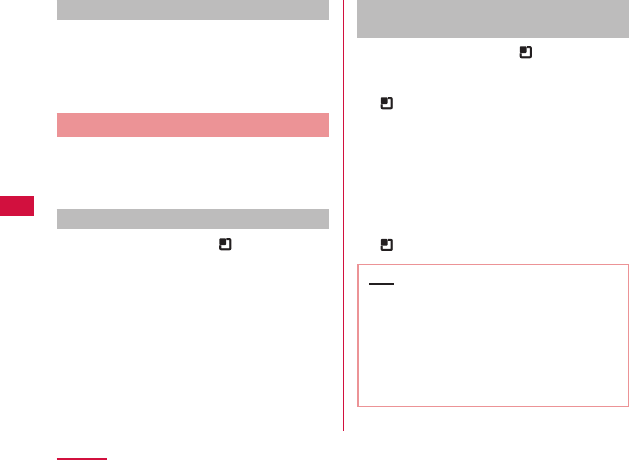
Deleting a VPN
a In VPN list, touch a VPN name to delete
for over 1 second
•A menu appears.
b"Delete network" u "OK"
Setting the Access Point
The access points (sp-mode, mopera U) required for
connecting to the Internet are preset. You may add or
change them if necessary.
The sp-mode is set as the default access point.
Checking the access point being used
a From the Home screen, u "Settings"
u "Wireless & networks" u "Mobile
networks" u "Access Point Names"
Setting an additional access point <New
APN>
a From the Home screen, u "Settings"
u "Wireless & networks" u "Mobile
networks" u "Access Point Names" u
u "New APN"
bTap "Name" u Enter the network profile
name you want to create u Tap "OK"
cTap "APN" u Enter the access point
name u Tap "OK"
dEnter any other items requested by your
network operator
e u "Save"
Note
•Do not change MCC to anything other than
440, or change MNC to anything other than 10.
Doing this will result in not being shown on the
screen.
•If the MCC and MNC disappear from the screen
after changing the settings, you can either
restore default settings or manually set the
access points again.
104
Settings
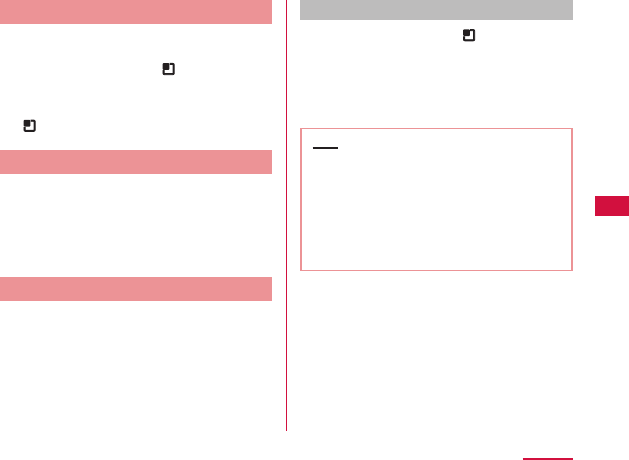
Initializing an Access Point
When you initialize an access point, it returns to its
default settings.
a From the Home screen, u "Settings"
u "Wireless & networks" u "Mobile
networks" u "Access Point Names"
b u "Reset to default"
sp-mode
sp-mode is an ISP for NTT DOCOMO smartphones. In
addition to Internet connection, this also provides an
email service that uses the same email addresses as
i-mode (@docomo.ne.jp). The sp-mode is a paid service
that requires subscription. For details about sp-mode,
refer to the NTT DOCOMO website.
mopera U
mopera U is an NTT DOCOMO ISP. If you have
subscribed to mopera U, you can use the Internet after
making the simple settings. mopera U is a paid service
that requires subscription.
Setting mopera U
a From the Home screen, u "Settings"
u "Wireless & networks" u "Mobile
networks" u "Access Point Names"
bTap to select the "mopera U" or "mopera
U設定" (mopera U settings) radio button
Note
•"mopera U設定" (mopera U settings) is the
access point for setting mopera U. Packet
communication fee is free by using the access
point for mopera U settings. Keep in mind
that you can only connect to the initial setting
screen and change settings screen. For details
on mopera U settings, refer to the mopera U
website.
105
Settings
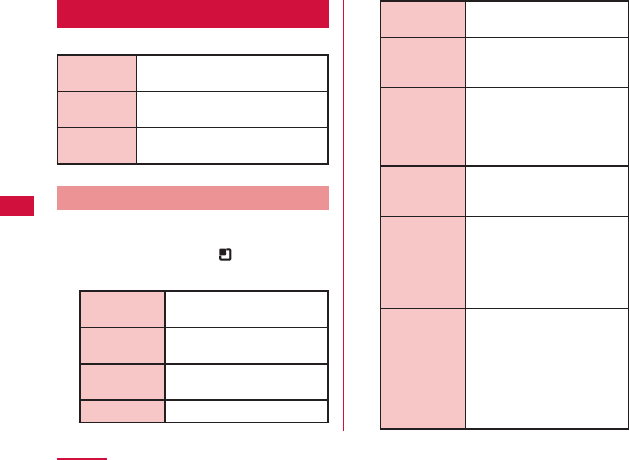
Call Settings
Configure various call settings.
Network
service
Configure docomo network service
settings.
Roaming
settings
Configure settings for international
roaming. (P203)
Advanced call
settings
Configure advanced call settings.
Network Service Settings
You can configure settings for the docomo network
services.
a From the Home screen, u "Settings"
u "Call settings" u "Network service"
Koe-no-
Takuhaibin
"Koe-no-Takuhaibin" (P90)
Voice mail
service
"Voice Mail Service" (P92)
Call forwarding
service
"Call Forwarding Service"
(P96)
Call waiting "Call Waiting Service" (P95)
Caller ID
notification
"Caller ID Notification Service"
(P98)
Nuisance
call blocking
service
Reject nuisance calls from the
same number.
Caller ID
notification
service
Set to play guidance
requesting number notification
to callers with a do-not-notify
setting, and terminate the call
automatically.
Second call
settings
You can set the connection
method for calls received while
you are on the phone.
Call
notification
SMS is used for notifying
you of missed calls when the
power is OFF, when you are
outside of the service area, or
when the incoming call cannot
be received.
English
guidance
You can set the general
voice guidance to English for
received and made calls.
It is also possible to set the
guidance for various network
service settings such as
"Voice Mail Service" and "Call
Forwarding Service" to English.
106
Settings
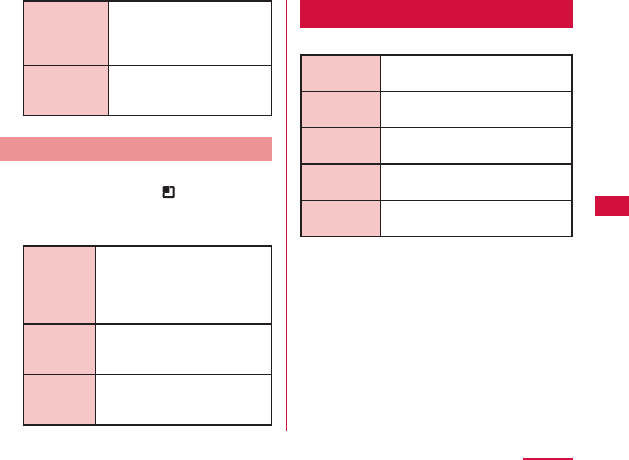
Remote
operation
settings
Set to remotely control the
terminal from a docomo mobile
phone, land-line phone, NTT
public phone, etc.
Public mode
(power OFF)
settings
"Public Mode (Power OFF)
Settings" (P99)
Using Advanced Call Settings
Configure advanced settings for calls.
a From the Home screen, u "Settings"
u "Call settings" u "Advanced call
settings"
Sub address
settings
Set the separator for when a
sub address is added to made
calls. The "*" that is included in
the phone number is used as a
separator for the sub address.
Prefix
settings
You can register international
phone numbers and area codes
to add them to made calls.
Reject
unregistered
call
Calls from numbers not
registered in the Phonebook are
rejected.
docomo Service
Configure docomo services.
Application
manager
Configure settings for regular update
confirmation, etc.
Wi-Fi Configure the settings for docomo
service via Wi-Fi.
docomo apps
password
Set a password for docomo
applications.
AUTO-GPS You can set the AUTO-GPS function
and view the location log.
Open source
licenses
Open source licenses are displayed.
107
Settings
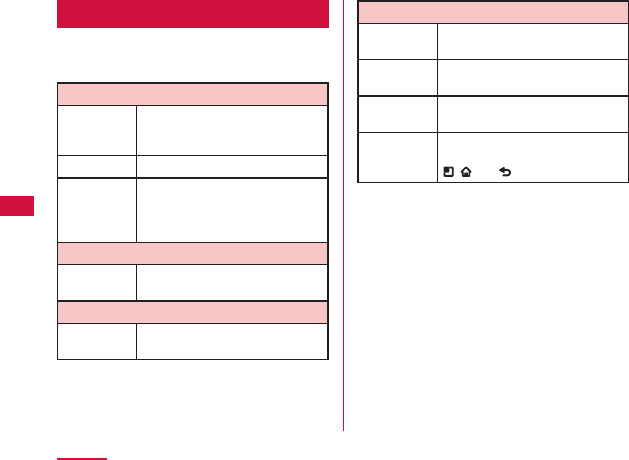
Sound
This allows you to configure various sound settings,
such as the type and volume of ringtones, Silent mode
and Vibrate.
General
Silent mode Enable/disable Silent mode. When
in Silent mode, all sounds apart from
music/video and alarms are muted.
Vibrate Set when to use the vibrator.
Volume Set the volume of the ringtone,
music/video and alarms. Sound
volume of notification also can be
adjusted.
Incoming calls
Phone
ringtone
Set the sound used as the ringtone.
Notifications
Notification
ringtone
Set the sound used for notifications.
Feedback
Audible touch
tones
Set whether to play a sound when a
phone number is entered.
Audible
selection
Set whether to play a sound when a
menu item is selected.
Screen lock
sounds
Set whether to play a sound when
the screen is locked/unlocked.
Haptic
feedback
Set whether to vibrate the terminal
during specific operations, such as
, , and .
108
Settings
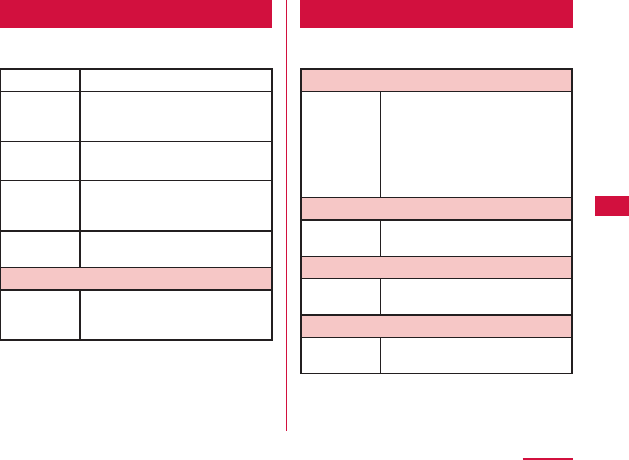
Display
This allows you to configure display settings, such as
screen brightness and animation.
Brightness Set the screen brightness.
Auto-rotate
screen
Set whether to automatically change
the screen display when the terminal
is rotated.
Animation Configure the animation settings.
Screen
timeout
Set how long to keep the backlight
on after the last time you use the
terminal.
Screen
optimization
Adjust the display of downloaded
applications according to resolution.
Sensor settings
Motion
sensor
calibration
Adjust the calibration of the motion
sensor.
Gesture
This allows you to enable or disable each motion
gesture.
Home screen
Rearrange
items
You can change item locations by
tilting the phone to the left and right
while an item is selected.
•This is only available when the
Home setting is "Home". It does
not work when "docomo Palette
UI" is used.
Incoming call
Mute When the phone is flipped while
ringing, the ringtone will stop.
Alarm
Snooze
(turn off)
When the phone is flipped while
ringing, the alarm will stop.
Gallery
Previous/next
picture
Tap the sides to view the previous/
next image.
109
Settings
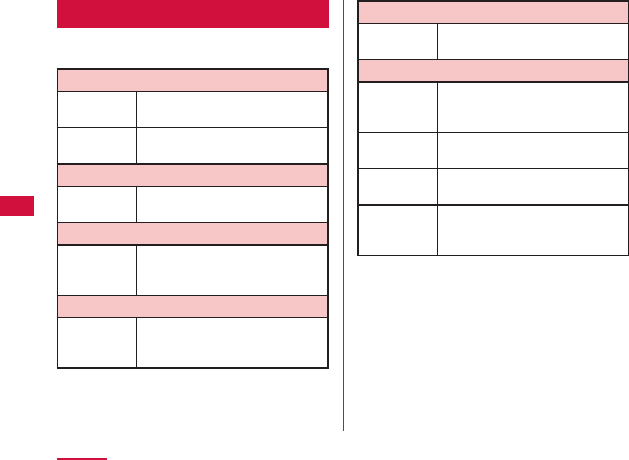
Location & Security
This allows you to configure settings such as GPS,
screen lock and passwords.
My location
Use wireless
networks
Display the current location in an
application using a wireless network.
Use GPS
satellites
Set whether to use GPS.
Screen unlock
Set up screen
lock
Set whether to use the screen lock
and configure its settings.
SIM/RUIM card lock
Set up SIM/
RUIM card
lock
Set whether to lock the SIM card
(UIM) and configure its settings.
Passwords
Visible
passwords
Set whether to display the
characters entered for the
password.
Device administration
Select device
administrators
Add or delete the administrator of
this terminal.
Credential storage
Use secure
credentials
Set whether to allow the application
to access the secure certification
and other certification information.
Install from
SD card
Install encrypted certificates from
microSD card.
Set password Set/change the credential
information storage password.
Clear storage Delete all content of credential
information storage and reset the
password.
110
Settings

Note
<On-Screen Unlock>
•If you enter incorrect screen-unlock patterns
5 times, a message prompting you for reentry
will appear after 30 seconds. If you forget the
screen-unlock pattern, tap "Forgot pattern?" on
the reentry screen then log in with your Google
account that has been set on your terminal. In
this way, you can enter a new pattern.
•Note that you cannot unlock the screen if you
forget the PIN or screen-lock password and
have not set a Google account.
Security Code and UIM Protection
For convenient and secure use of the terminal, you can
set codes to lock the terminal and network security
codes to be used with network services. You can make
better use of the terminal by using different codes
depending on the purposes.
Note
•Avoid setting security codes using your
birthday, part of your phone number, your
address or room number, "1111" or "1234",
which can be easily guessed by others. Be sure
to write down the security codes and store them
in a safe location.
•Do not reveal your security codes to others.
DOCOMO is not responsible for damage
caused by misuse of your security codes by
others.
•If you forget your security codes, you need to
bring your identification document (driver's
license, etc.), the terminal and the UIM to a
docomo Shop. For details, contact "General
Inquiries" provided on the last page of this
manual.
111
Settings

•Your PIN unblocking key is written in the
application form (copy for subscriber) given at
the time of contract. If you have subscribed at
a place other than a docomo Shop, bring your
identification document (driver's license, etc.)
and the UIM to a docomo Shop, or contact
"General Inquiries" provided on the last page of
this manual.
Network security code
The network security code is a 4-digit number
necessary for using the docomo Network Services or
identification at reception of your request in docomo
Shop or at docomo Information Center. It can be set to
any number at the subscription and also changed later
by yourself. You can change your network security code
to the new one through PC if you have a "docomo ID/
Password" on General support site for PC "My docomo".
Note
•For information about "My docomo", refer to
P246.
PIN code
The UIM can set security code named PIN code. This
code is set to "0000" at the time of subscription, but you
can subsequently change it.
PIN code is a 4- to 8-digit number that is entered to
check the user when the UIM is inserted in the terminal
or the terminal power is turned on. It is intended to
prevent unauthorized use of the terminal by a third party.
You can use the terminal by entering PIN code.
Note
•If you use a UIM that has been currently used
when you buy a new terminal, use the same PIN
code that had been set on the current terminal.
The code is "0000" if the default setting has not
been changed.
•If you enter incorrect PIN code three times in
a row, the code will be locked. In that case,
unlock with "PUK code".
112
Settings
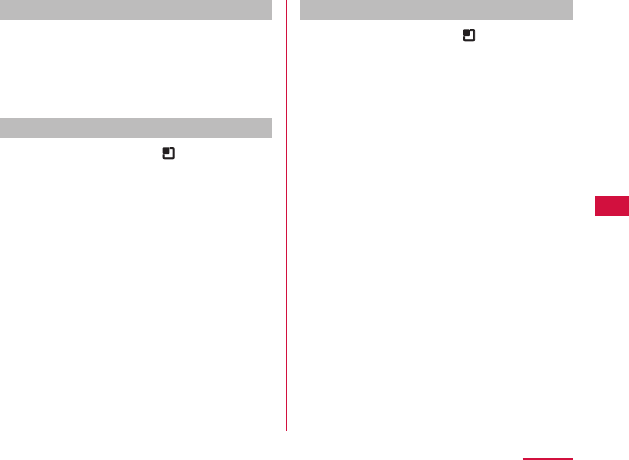
PIN unblocking key (PUK)
The PIN unblocking key (PUK) is an 8-digit number
used to unblock the PIN code. You cannot change it by
yourself.
•If you enter the PUK code incorrectly ten times in a
row, the UIM will be locked. If this happens, please
contact a docomo Shop.
Enabling UIM's PIN code
a From the Home screen, u "Settings"
u "Location & security"
b"Set up SIM/RUIM card lock"
•The "SIM/RUIM card lock settings" screen
appears.
c"Lock SIM/RUIM card"
•Set the PIN code on the "Lock SIM/RUIM card"
screen.
dEnter PIN code and tap "OK"
•You are asked to enter the PIN code when the
terminal is powered on.
Changing PIN code
a From the Home screen, u "Settings"
u "Location & security"
b"Set up SIM/RUIM card lock"
•The "SIM/RUIM card lock settings" screen
appears.
c"Change SIM/RUIM PIN"
•The "SIM/RUIM PIN" screen appears, and you
are prompted to enter the PIN code.
dEnter the current PIN code, and tap
"OK"
•You are prompted to enter the PIN code in the
"SIM/RUIM PIN" screen.
eEnter a new PIN code and tap "OK"
•You are prompted to enter the PIN code again in
the "SIM/RUIM PIN" screen.
fEnter the same PIN code that you
entered in step 5 and tap "OK"
•The PIN code is changed.
113
Settings
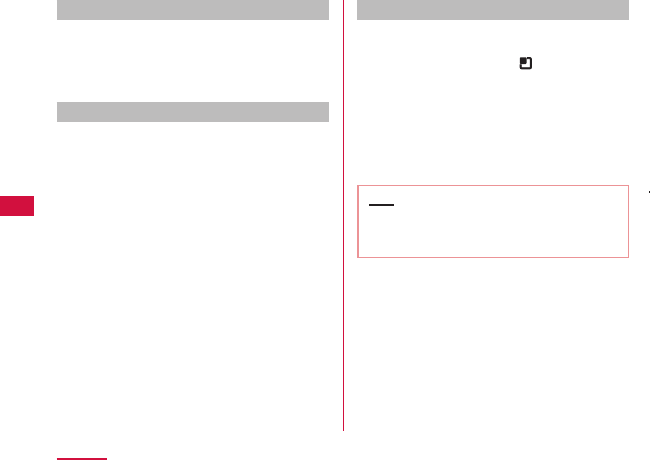
Enter PIN code
This the following operations if you are asked to enter
the PIN code when the terminal is powered on.
a Enter the PIN code of the UIM, and tap
"OK"
Unblocking the PUK locked UIM
Follow the procedures below to unlock PIN when you
enter PIN code 3 times incorrectly in a row.
a Enter PUK on PIN unblocking code
screen and tap "OK"
bEnter a new PIN code and tap "OK"
cEnter the same PIN code that you
entered in step 2 and tap "OK"
Device management
Configure device management settings to use Omakase
Lock.
a From the Home screen, u "Settings"
u "Location & security"
b"Select device administrators" u
Select a device administrator u Place a
checkmark
•At the time of purchase, the Omakase Lock is
set to be enabled.
Note
•To use the Omakase Lock, it is necessary to
enable "Omakase Lock". As of November 2011,
Omakase Lock cannot be used.
114
Settings
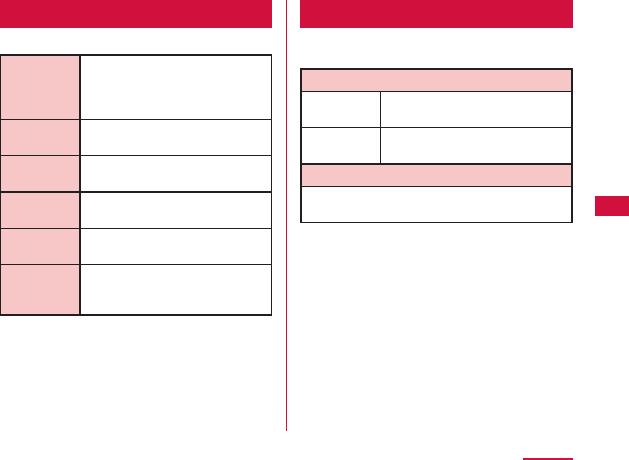
Applications
This allows you to configure applications' settings.
Unknown
sources
Configure whether to allow the
installation of the applications that
are supplied by other than Android
market.
Manage
applications
List/delete installed applications.
Running
services
List/stop the active services.
Storage use Display storage status used for
application.
Battery use Display applications which are using
battery and battery usage.
Development Configure the various settings
required for application
development.
Accounts & Sync
This allows you to configure the settings of accounts
and their synchronization.
General sync settings
Background
data
Set whether the applications always
synchronize and send/receive data.
Auto-sync Set whether the applications
automatically synchronize data.
Manage accounts
Add or delete an account used in this terminal, such
as Google account.
115
Settings
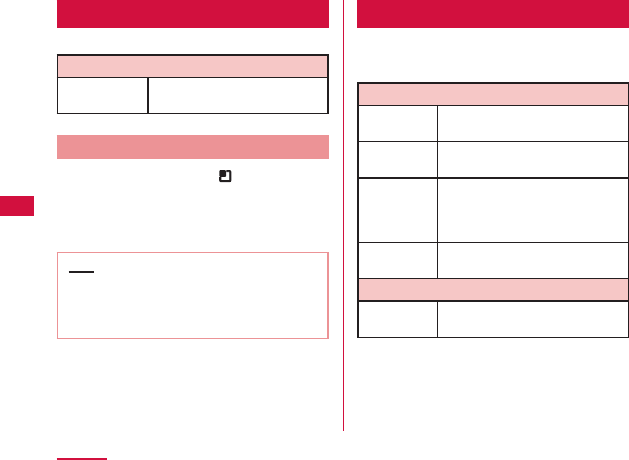
Privacy
This allows you to initialize data.
Personal data
Factory data
reset
Delete all data from the terminal.
Initializing Terminal
a From the Home screen, u "Settings"
u "Privacy"
b"Factory data reset" u "Reset phone" u
"Erase everything"
Note
•Backup your data such as images, videos and
music on PC. For details about connection
method, refer to "File Management" (P131) and
"External Device Connection" (P138).
Storage
This allows you to display the microSD card status,
mount and format, and the free space in internal
memory.
SD card
Total space Display the total space on microSD
card.
Available
space
Display free space on microSD card.
Unmount SD
card/Mount
SD card
•Unmount the microSD card to
remove it safely.
•Mount the microSD card before
using.
Erase SD
card
Erase all data (music, photo, etc.)
on microSD card.
Internal storage
Available
space
Display free space of internal
storage.
116
Settings
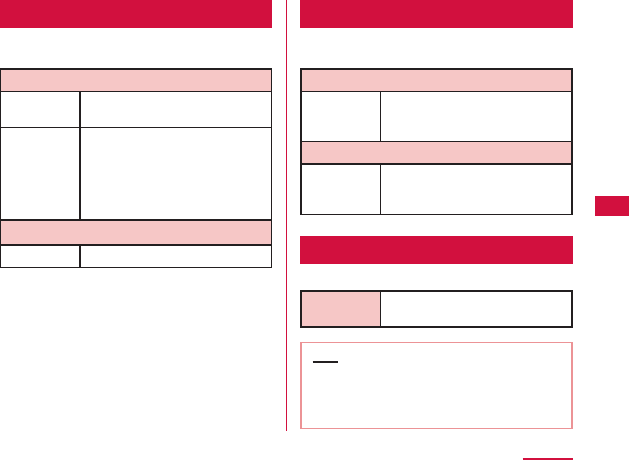
Language & Keyboard
This allows you to configure the terminal's language and
keyboard settings.
Language settings
Select
language
Select the language used on the
terminal.
User
dictionary
Procedures such as registration are
required when using the character
entry application supplied by
Google. You can download the
character entry application provided
by Google from Android market.
Keyboard settings
iWnn IME Set screen keyboard settings.
Voice Input & Output
This allows you to configure settings for voice input and
output.
Voice input
Voice
recogniser
settings
Configure the settings of voice
recognizer.
Voice output
Text-to-
speech
settings
Configure the settings for reading
out text.
Accessibility
Set the settings of accessibility application.
Accessibility Enable or disable the applications
compatible with accessibilities.
Note
•"No accessibility related applications found"
appears when purchased. If you want to set
accessibility, download compatible applications
from Android Market in advance.
117
Settings
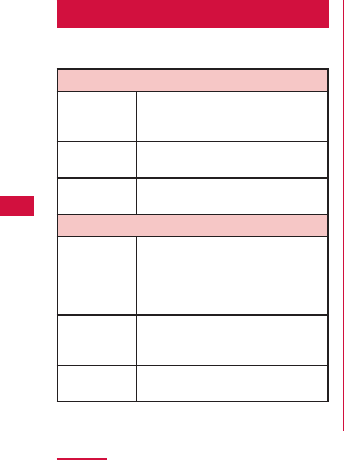
Connectivity Settings
Configure the settings for USB connection mode and
the On-Screen Phone function.
USB connection
Default
connection
mode
The default USB connection
mode
for connecting to a PC is set. (P138)
Always ask The USB connection mode is always
checked when connecting to a PC.
Help An explanation for USB tethering is
displayed.
On-Screen Phone settings
On-Screen
Phone
Change password when connecting
a PC with the terminal via a USB or
Bluetooth to display the screen of
the terminal on a PC and operate
the terminal.
Disconnect
On-Screen
Phone
Disconnect the On-Screen Phone.
Change
password
Change the On-Screen Phone
password.
●What is LG On-Screen Phone (OSP)?
LG On-Screen Phone is a function for displaying the
screen of the terminal on a PC, and for using mouse
and keyboard input on the PC for simple operation of
the terminal*.
It allows you to type using the keyboard of the PC,
receive notifications of alarms, schedules, incoming
calls, and other information on the PC, and exchange
files between the PC and terminal by dragging and
dropping them.
* Some functions which are available with the
terminal cannot be operated with LG On-Screen
Phone.
●About OSP
•For details on operating procedures, downloading
the PC software, and other information, refer to the
following site.
From a PC
→ http://www.lg.com/jp/mobile-phones/download-
page/index.jsp (in Japanese only)
118
Settings
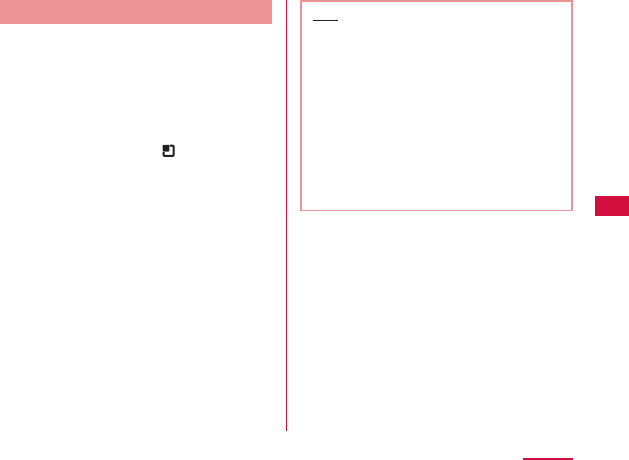
Activating USB Tethering
Connect the terminal and a PC using USB connection
cable to connect the PC to the Internet using the
terminal as a modem.
a Connect the terminal and a PC using USB
connection cable
•Confirm the details of the warning and then tap
"OK".
bFrom the Home screen, u "Settings"
u "Connectivity settings" u "Default
connection mode" u "USB tethering" u
"OK"
Note
•Hardware requirements of a PC for USB
tethering are as follows:
- OS*: Windows 7/Windows Vista/Windows XP
(Service Pack 3 or later)
* Operations conducted in environment with
upgraded OS or in added/changed
environment cannot be guaranteed.
•A dedicated driver is required for USB tethering.
For details about the method of the download
and operation of dedicated driver, refer to the
following site.
http://www.lg.com/jp/mobile-phones/download-
page/index.jsp (in Japanese only)
119
Settings
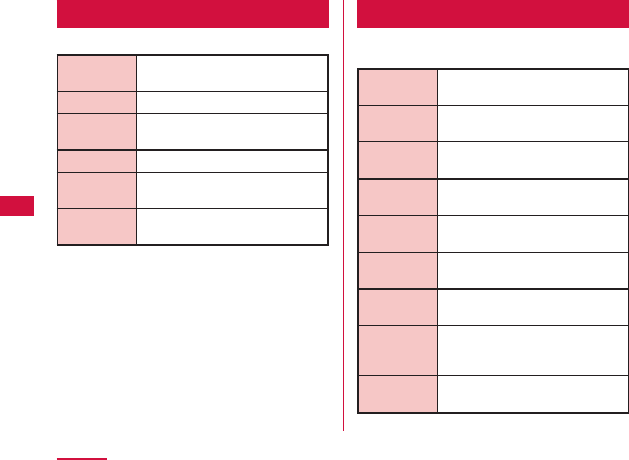
Date & Time
This allows you to configure the date and time settings.
Automatic Set the automatic retrieval of date
and time information via the network.
Set date Configure the date settings.
Select time
zone
Configure the time zone settings.
Set time Configure the time settings.
Use 24-hour
format
Set whether to display the time in
24-hour or 12-hour format.
Select date
format
Set the date format.
About Phone
This allows you to display various informations of the
terminal.
Software
Update
Change software update settings.
Status Display information related to this
terminal.
Battery use Display information about battery
usage.
Legal
information
Display information about the terms
of use.
Model
number
Display the model number (model
name) of your terminal.
Android
version
Display the version of Android
running on your terminal.
Baseband
version
Display the version of baseband
running on your terminal.
Kernel
version
Display the version of the kernel
used in Android running on your
terminal.
Build number Display the build number of Android
running on your terminal.
120
Settings
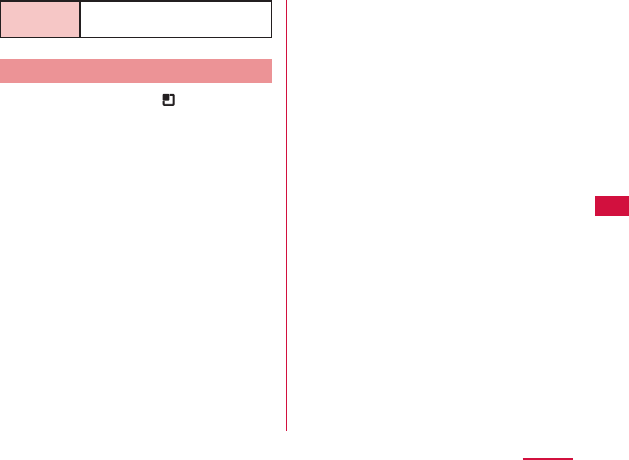
Software
version
Display the software version of the
terminal.
Displaying your Own Number
a From the Home screen, u "Settings"
u"About phone"
b"Status"
•The "Status" screen appears. Your own number
appears as "My phone number".
121
Settings

Mail / Internet
sp-mode Mail
This allows you to send and receive emails using an
i-mode mail address (@docomo.ne.jp).
It allows you to use pictograms and Deco-mail, and also
supports auto receive.
For details about sp-mode, refer to "Mobile Phone
User's Guide (sp-mode)".
a From the Home screen, "sp-mode mail"
•Follow the instruction on the screen.
SMS
You can send and receive text messages containing
up to 70 double-byte characters (or 160 single-byte
alphanumeric characters) to other terminals.
Sending an SMS Message
a From the Home screen, "Applications"
u "Messaging"
•The "Messaging" screen appears.
b"New Message"
cTap the "To" box u Enter recipient's
phone number
•A list of contacts beginning with the entered
number or name appears.
dTap the "Enter Message" box u Enter a
message
e"Send"
•The message is sent.
122
Mail / Internet
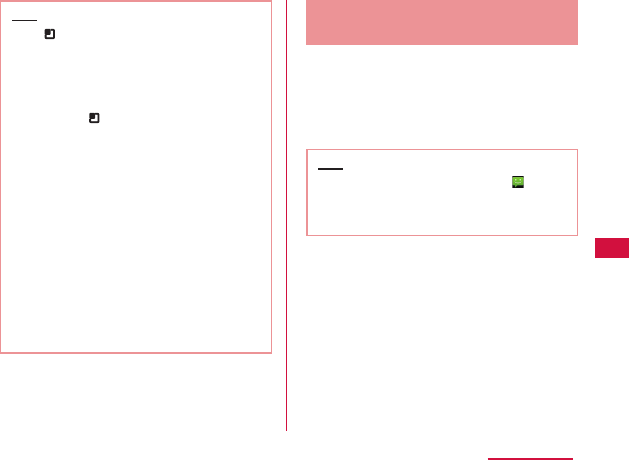
Note
•Tap u "Insert smiley" while entering a
message to insert a pictogram. Although an
emoticon appears on your "Enter Message" box,
the pictogram is displayed if the message is
received on an Android compatible phone.
•To receive notification that the SMS message is
received, tap u "Settings" on the "Messaging"
screen, and check the "Delivery reports"
checkbox.
•You can also send/receive SMS messages to/
from users of overseas network operators.
For available countries/compatible overseas
network operators, refer to "Mobile Phone User's
Guide [International Services]" or the DOCOMO
"International Services website".
•To send SMS messages to users of overseas
network operators, enter "+" u "Country code"
u "Recipient's mobile phone number". Omit "0"
if the recipient phone number starts with "0".
You can also send an SMS message by entering
"010", "Country code" and "the recipient mobile
phone number". (To reply to an SMS message
sent from overseas, enter "010".)
Receiving/Viewing an SMS
Message
a From the Home screen, "Applications"
u "Messaging"
•The "Messaging" screen appears.
bTap one of the threads
•The message appears.
Note
•When you receive an SMS message, appears
in the status bar. To read the message, drag or
swipe the status bar downwards to open the
Notification panel, and tap a new message.
123
Mail / Internet
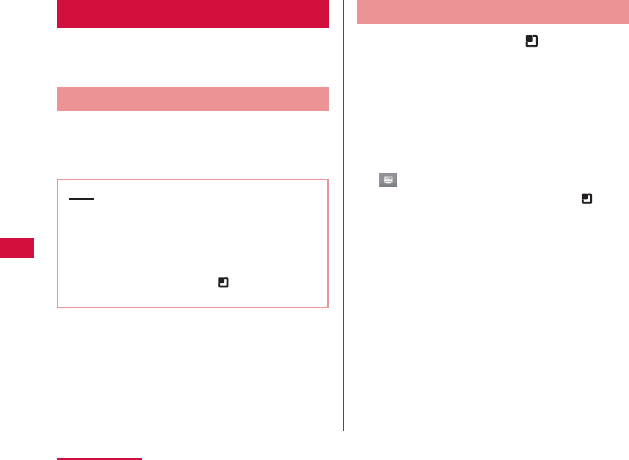
Gmail
If you have a Google account, you can send and
receive emails using Gmail. If you do not have a Google
account, you must open an account before using Gmail.
Opening Gmail
a From the Home screen, "Applications"
u "Gmail"
•Gmail opens, and the "Inbox" screen appears.
Note
•If your Google account settings have not been
completed, the "Add a Google Account" screen
appears. Follow the displayed instructions. If
you do not have a Google account, create one
here.
•For details about Gmail, tap u "More" u
"Help" on the "Inbox" screen.
Creating and Sending an Gmail
a From the "Inbox" screen, u
"Compose"
•The "Compose" screen appears.
bEnter email address in the "To" box
cEnter a subject in the "Subject" box
dEnter a message in the "Compose Mail"
box
e
•You can also send an email by tapping u
"Send" on the "Compose" screen.
124
Mail / Internet

Early Warning
"Area Mail"
You can receive Earthquake Early Warnings provided by
the Japan Meteorological Agency.
•Area Mail is a free service that does not require
application.
•You cannot receive Area Mail in the following cases.
- When the phone is turned OFF
- When you are out of the service area
- When the terminal is in Airplane mode
- During voice calls
- While updating software
- When you are roaming overseas
- When sending/receiving SMS messages
- When using a SIM card from another provider
•You may not be able to receive Area Mail when using
packet communication and tethering functions.
•You cannot receive an Area Mail after it has been
missed.
Receiving Area Mail
a Receiving Area Mail automatically
•When an Area Mail is received, a dedicated
ringtone sounds and the text of the Area Mail is
displayed.
•When the screen lock is set, the text of the Area
Mail is not displayed. It will be displayed when
the screen lock is canceled.
•You cannot change the ringtone volume.
Viewing Area Mail later
a From the Home screen, "Applications"
u "Area Mail"
•The "Early warning 'Area Mail' Inbox" screen
appears.
bTap an Area Mail
•The text of the Area Mail appears.
125
Mail / Internet
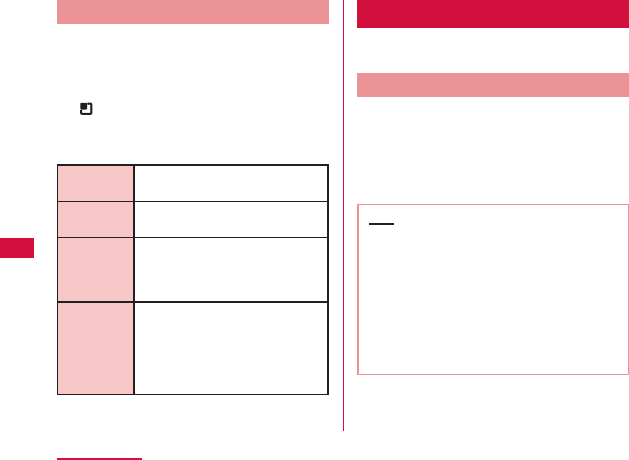
Setting Area Mail
a From the Home screen, "Applications"
u "Area Mail"
•The "Early warning 'Area Mail' Inbox" screen
appears.
b u "Settings"
•The "Settings" menu appears.
cChange the settings if required
Receive
setting
Check to receive Area Mail.
Beep tone Configure the beep time settings and
operations during Silent mode.
Check
screen
image and
beep tone
You can confirm operations for
receiving earthquake early warnings
and disaster/evacuation information.
Other
settings
To receive Area Mail other than
earthquake early warnings and
disaster/evacuation information,
you can register Area Mail names
and message IDs that you want to
receive.
Browser
Browser allows you to view web pages in the same way
that you can from a PC.
Opening Browser
a From the Home screen, "Browser"
•Browser opens, displaying the last web page
that you viewed. The home page appears if you
have not used the Browser recently.
•Pinch out on the web page to zoom in the
display, and pinch in to zoom out.
Note
•When viewing a web page that has been
designed for PCs, it is displayed in full size for
the first time use. However, you may zoom in or
out, or scroll through the page. For more details,
refer to "Touch Screen Operations" (P42).
•Web page operations may vary depending on
their format and content.
•For information on the file formats that can be
viewed and played on the terminal, refer to "File
formats" (P228).
126
Mail / Internet

a Search box
Enter the text you want to search or URL to
display a list of web page candidates and search
candidates that match the entered characters.
Tap one of the listed candidates or finish entering
the URL, and tap to display the web page.
If the search box is not displayed on the browser
screen, tap .
b Bookmark button
The "Bookmarks" tab appears.
c Previous web page
The previous page is displayed.
d Next web page
The next page is displayed.
e Zoom
Tilt the terminal toward you while touching to zoom
in the web page. Tilt it away from you to zoom out.
f Switching windows
You can switch to the selected window when
accessing web pages via multiple windows. You
can close the window by tapping .
g New window
A list of frequently used web pages is displayed,
and you can tap to access in a new window.
127
Mail / Internet
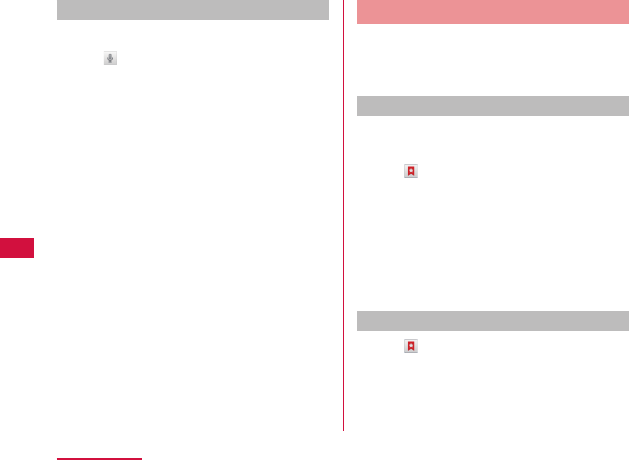
Searching for a web page by voice entry
a Tap the search box
bTap
•"Speak now" appears.
cClearly speak the search word(s) into
the microphone
•Candidates for the search word are displayed.
Tap a candidate word and it will be entered
in the search box. Also, a list of web pages
including the search word appears.
dTap one of the listed web pages
•The selected web page opens.
Using Bookmark and History
Bookmarking a web page allows you to quickly access
that web page.
You can also view previously visited web pages by
displaying your browsing history.
Adding a bookmark
a View the page that you want to
bookmark
bTap
•A thumbnail of the bookmarked page appears
on the "Bookmarks" tab.
c"★Add"
dEdit the name and URL if required, and
tap "OK"
•Thumbnails of the web pages displayed on the
list of bookmarks appear.
Viewing a bookmarked web page
a Tap
•The "Bookmarks" tab appears.
bTap the displayed bookmark
•The selected web page opens.
128
Mail / Internet
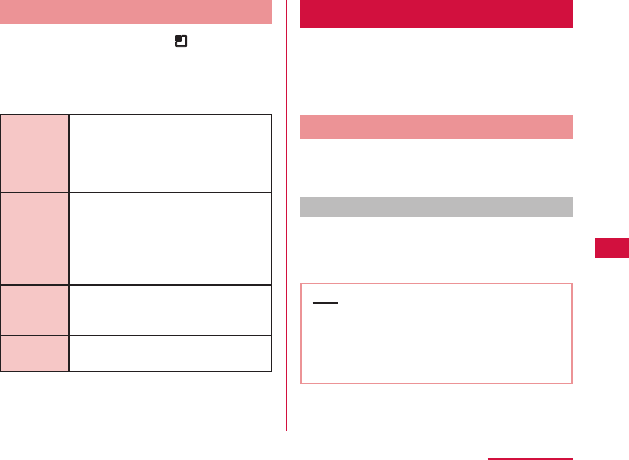
Changing Browser Settings
a From the Browser screen, u "More"
u "Settings"
•A menu appears.
bChange the settings if required
Page
content
settings
Set whether to use the default scaling
on web pages, whether to display
popup windows, whether to import
images, the home page and other
items.
Privacy
settings
Clear the browser cache, the browsing
history, cookies, form data, and
location information. Configure the
settings about whether to accept
cookies, to save form data and to allow
location information.
Security
settings
Set whether to save passwords and
whether to display security warnings.
You can also clear saved passwords.
Advanced
settings
Return website settings and browser
settings to default setting.
Talk
Google Talk is a Google instant messaging program. It
allows you to chat (text chatting) with friends who have
Google accounts. To use Google Talk, you must set up
your own Google account. For details, refer to "Setting
Online Service Accounts" (P51).
Before Using Google Talk
To use Google Talk, it is required to log in and add a
new friend. If you already have a Google account, you
don't have to sign in to start using Google Talk.
Logging in to Google Talk
a From the Home screen, "Applications"
u "Talk"
•
The set Google account appears.
Note
•If your Google account settings have not been
completed, the "Add a Google Account" screen
appears. Follow the displayed instructions. If
you do not have a Google account, create one
here.
129
Mail / Internet

Chatting
a Tap a friend's account on the "Talk"
screen
•The Chat screen appears.
bTap the "Type to compose" box u Enter
your message and tap "Send"
•The text that you entered in the "Type to
compose" box is sent.
•For details about Google Talk, from the Google
Talk screen, tap u "Settings" u "Terms &
privacy" u "Help Center" (Talk Help is displayed
in English).
130
Mail / Internet

File Management
File Operation
You can synchronize music with "Windows Media
Player" on your PC by connecting the terminal with the
PC via the supplied USB connection cable, and transfer
the data between the PC and the terminal by dragging
and dropping. Sharing some data may not be permitted
due to copyright.
•In order for your PC to recognize this terminal, a
dedicated driver and Windows Media Player 11 or
later are required.
- For details about the method of the download
and operation of dedicated driver, refer to the
homepage below.
http://www.lg.com/jp/mobile-phones/download-
page/index.jsp (in Japanese only)
- You can download the latest Windows Media
Player on Microsoft website.
http://www.microsoft.com/windows/windowsmedia/
download (in Japanese only)
•Some functions such as shooting and playing video
may not work while connecting the terminal with PC.
Note
•Operating environment of a PC for file operation
is as follows:
- OS*: Windows 7/Windows Vista/Windows XP
(Service Pack 3 or later)
- Windows Media Player: Windows Media
Player 11 or later
* Operations conducted in environment
with upgraded OS or in added/changed
environment cannot be guaranteed.
•Other than the terminal or PC, the following
devices and software are necessary to perform
file operation on a PC.
- Dedicated driver
131
File Management

Folder Structure in the Terminal
When you connect the terminal with PC, the microSD
card in the terminal is recognized with the name
"Removable disk".
Folders corresponding to files are created automatically
in microSD card in the terminal when saving photos and
videos shot on the terminal, downloading data such as
images and music on the Internet, etc.
•For details about connection method between the
terminal and PC, refer to "Connecting the Terminal
with a PC" (P138).
•The default folder structure of "Removable disk" is as
follows:
- Android
- .android_secure
- DCIM
- LOST.DIR
Note
•Shot photos and videos are saved in "DCIM"
folder in microSD card. Music data
synchronized with Windows Media Player on PC
are saved on "Music" folder.
•Backup your data saved in microSD card inside
the terminal to PC. For details about connection
method, refer to "File Operation" (P131) or
"Connecting the Terminal with a PC" (P138).
•Data saved from other devices such as a
PC to a microSD card in the terminal may
not be displayed or played on the terminal.
Additionally, data saved from the terminal to a
PC may not be displayed or played on other
devices.
132
File Management
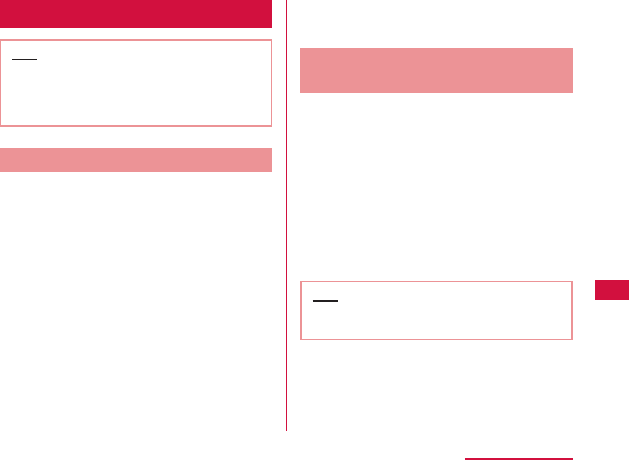
Folder and File Operations
Note
•Do not turn off the terminal while reading or
writing data.
•Do not unplug USB connection cable while
reading or writing data. It results in loss of data.
Transferring Data with a PC
a Connect the terminal with a PC via the
supplied USB connection cable (P139)
bSet USB connection mode to "Mass
storage" (P139)
cOpen "マイコンピュータ" (My computer)
and select "リムーバブルディスク"
(Removable disk) on PC
•A microSD card root folder for the terminal
appears.
•"自動再生" (Auto play) screen may appear
depending on the setting. Choose "フォルダを
開いてファイルを表示する" (Open the folder to
display) when the screen is displayed.
dDrag and drop data between the terminal
and the PC
Synchronizing Data with
Windows Media Player
This allows you to synchronize music and videos with
Windows Media Player library on PC. In this way,
music and videos with copyright protection can be
synchronized as well as the copyright information.
a Connect the terminal with a PC via the
USB connection cable (P139)
bSet USB connection mode to "Mass
storage" (P139)
cActivate Windows Media Player on PC
and synchronize
Note
•For details about Windows Media Player, refer to
Windows Media Player help.
133
File Management

Disconnecting the terminal from a PC
a Stop and remove the removable disk
safely from PC
•For example, for Windows® 7/Windows Vista®/
Windows® XP, execute operation according to
the "ハードウェアの安全な取り外し" (Safely
Removing Hardware).
bRemove the supplied USB connection
cable from terminal and PC
Bluetooth Communication
Connect the terminal to Bluetooth devices wirelessly,
and enable to exchange data.
•For Bluetooth compatible version or profile, refer to
"Main Specifications" (P225).
•For Bluetooth setting and operation procedure, refer
to a manual of Bluetooth devices to connect.
•The terminal does not connect wirelessly with all
types of Bluetooth devices.
Notes on using Bluetooth function
•The distance between the terminal and another
Bluetooth device keeps within approximately
10 m with no obstructions in sight. The distance
that the terminal and a Bluetooth device can
make connection may be shorter when there are
obstructions between them or depending on the
conditions of the surroundings (such as walls or
furniture) and the structure of a building. Especially
when there is a wall or floor of reinforced concrete
between them, they may be unable to connect with
each other. Note the above mentioned distance is
not guaranteed.
•Make sure to keep the terminal and another
Bluetooth device 2 m or more away from home
electric appliances, AV devices, OA devices, etc.
before connection. The Bluetooth device is liable
to be adversely affected by a microwave oven,
so keep it 3 m or more away from the microwave
oven while using it. Otherwise, normal connection
134
File Management